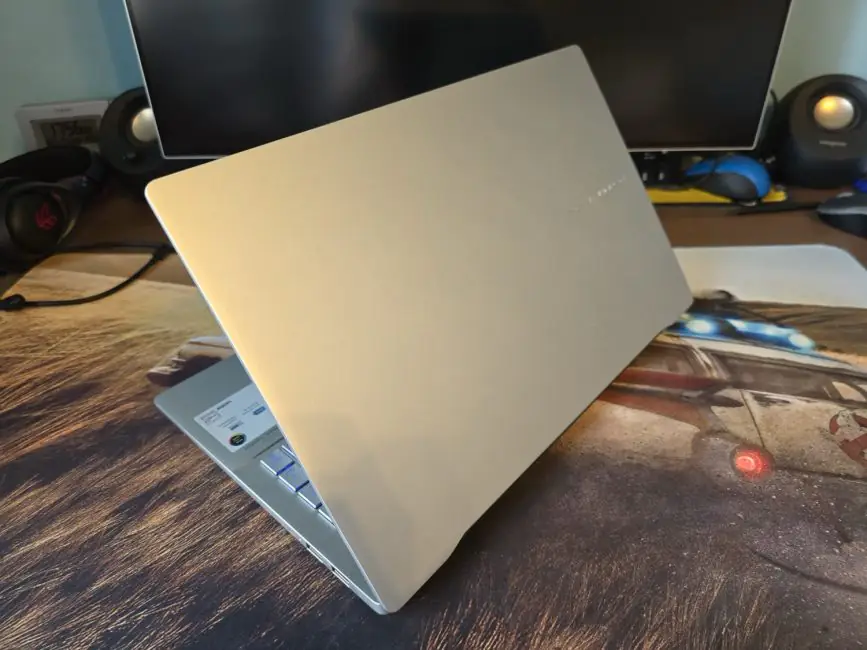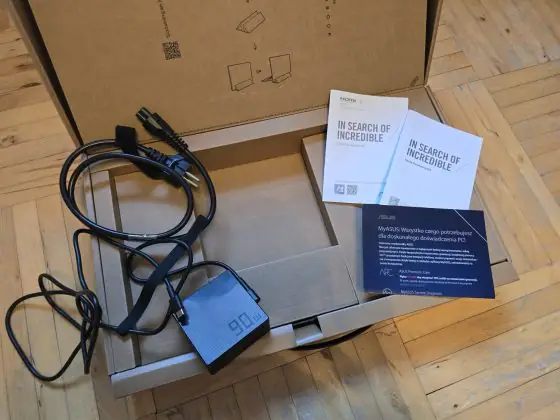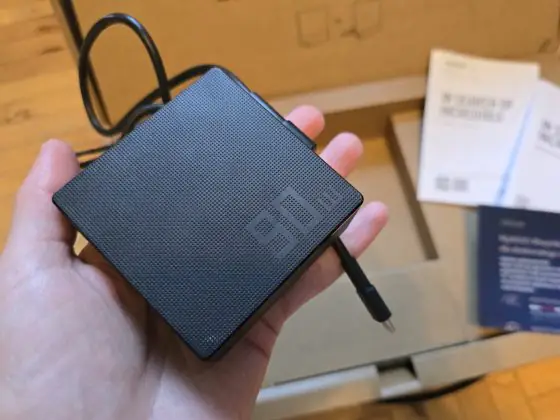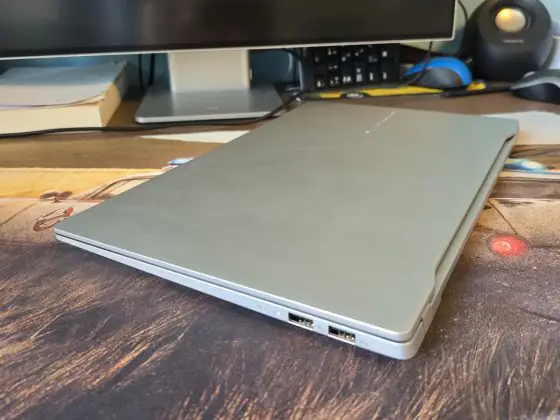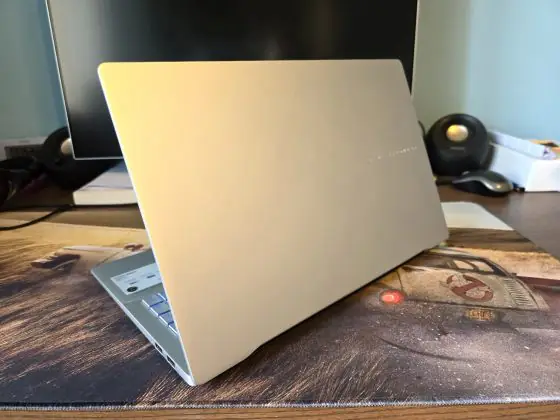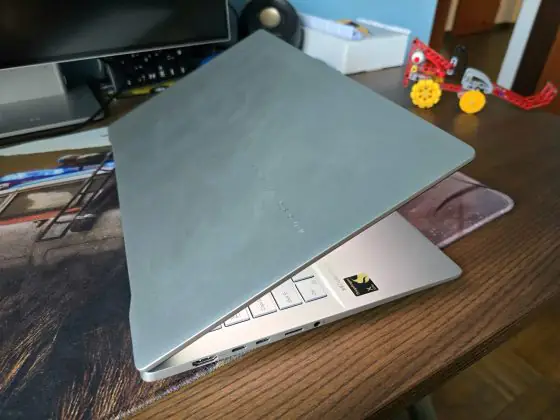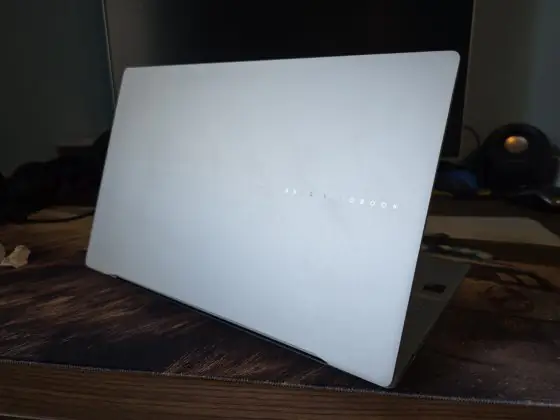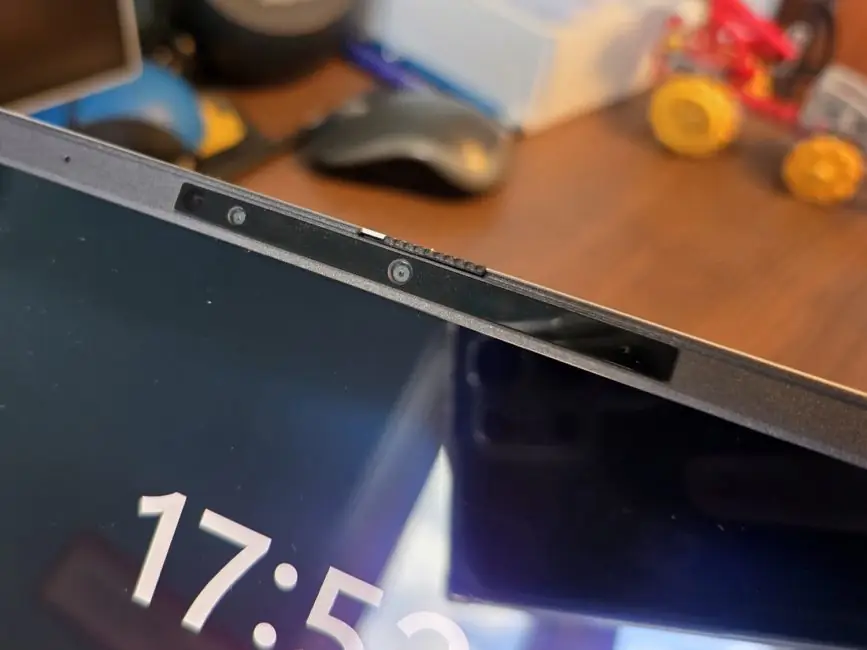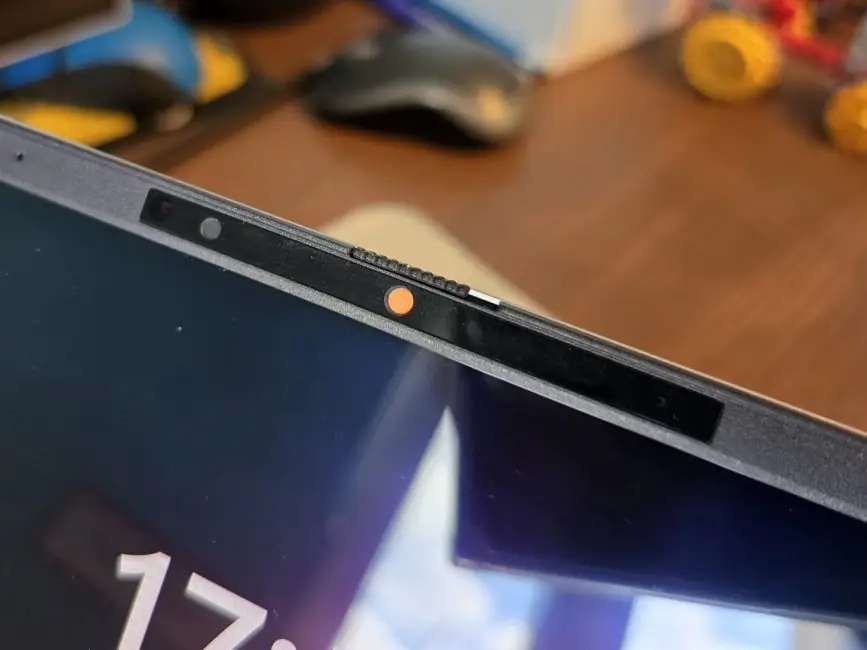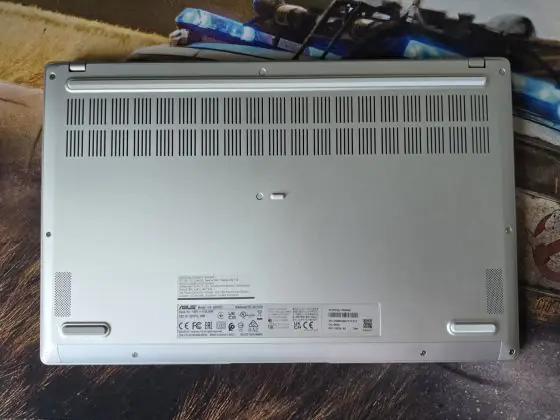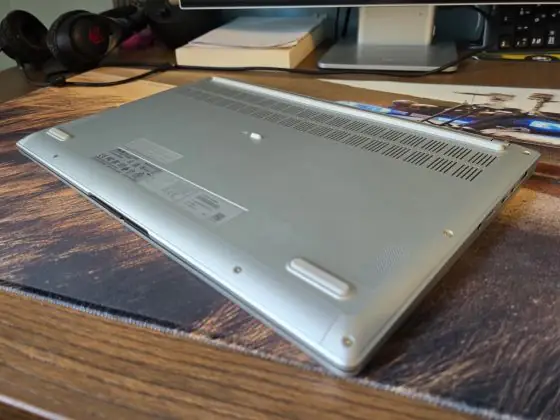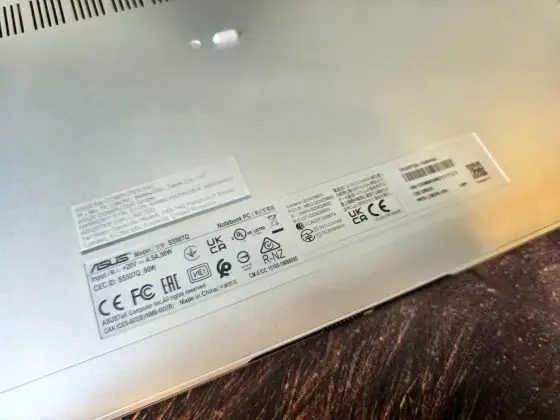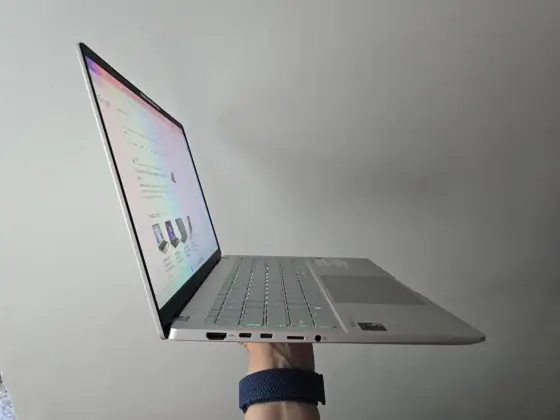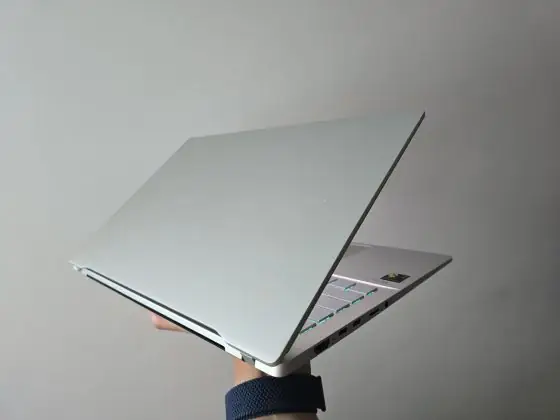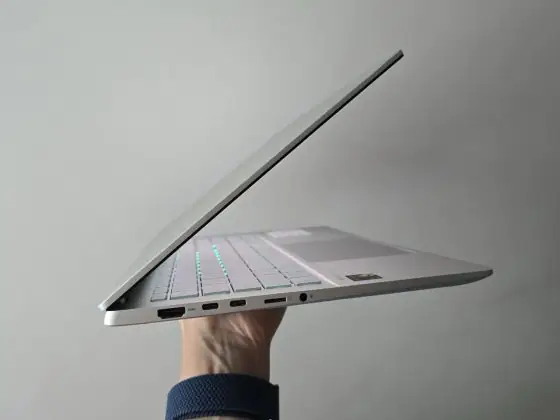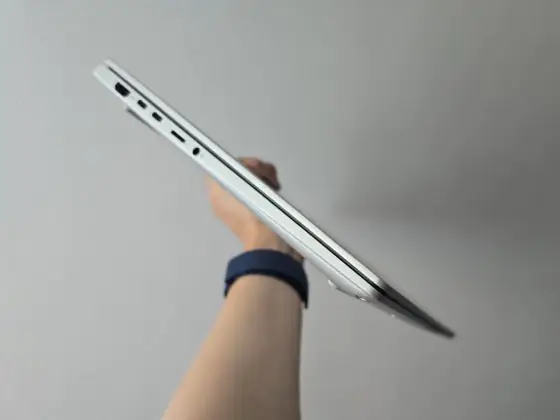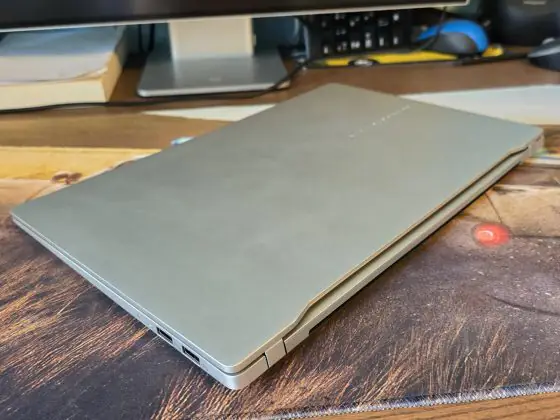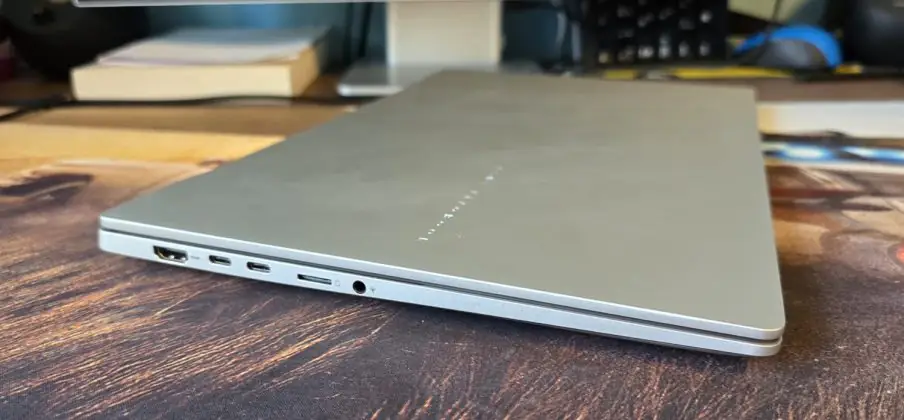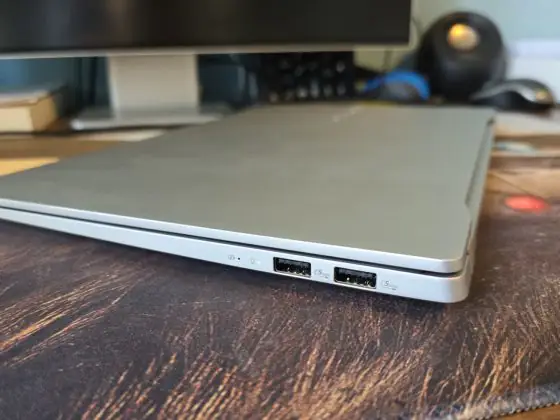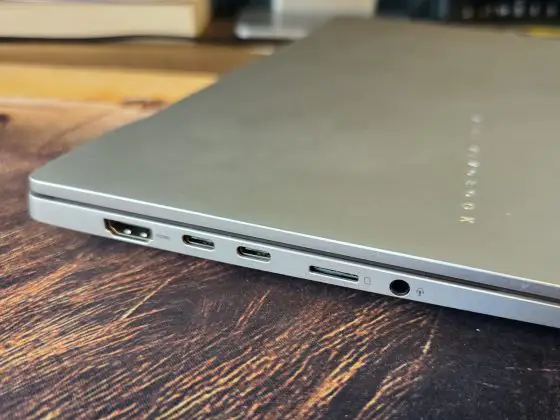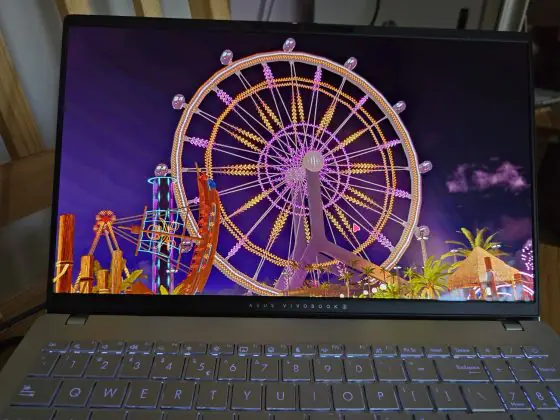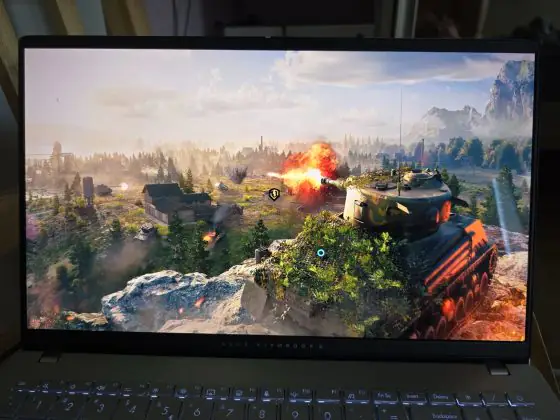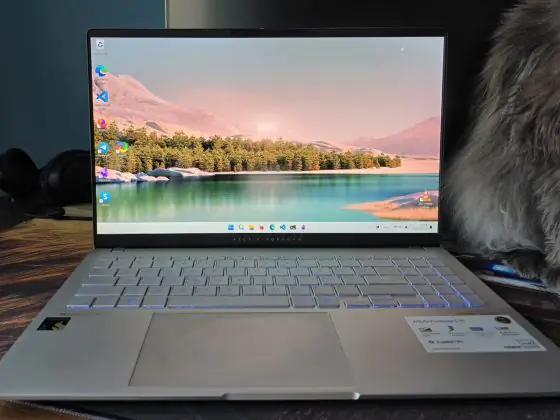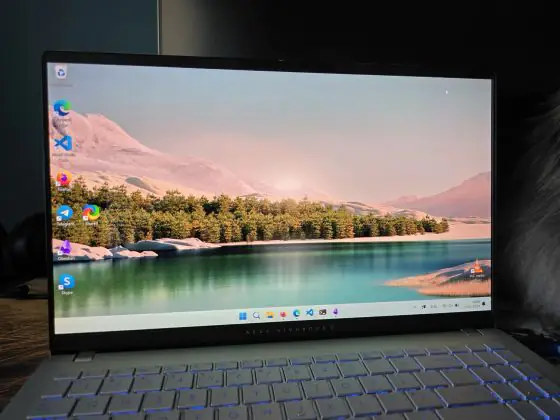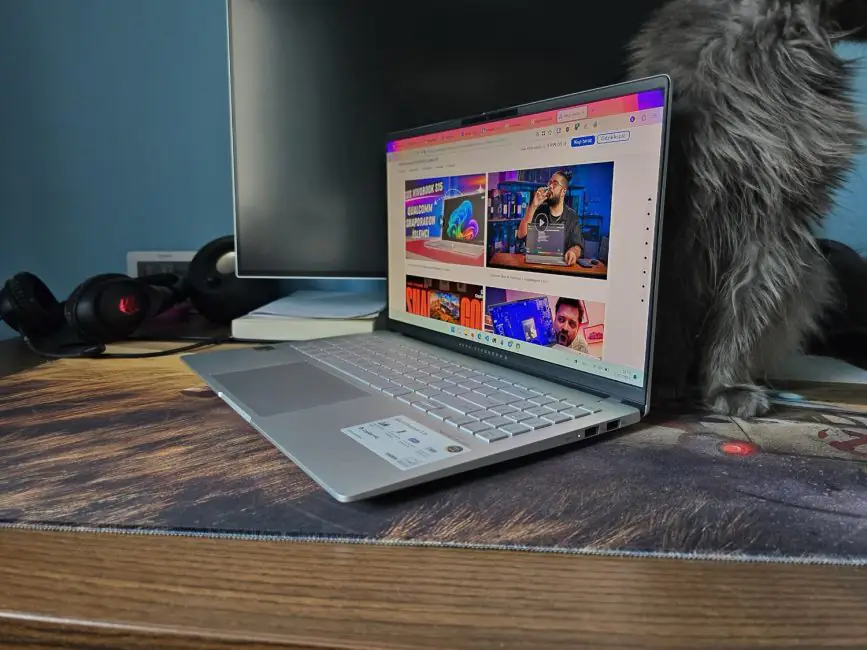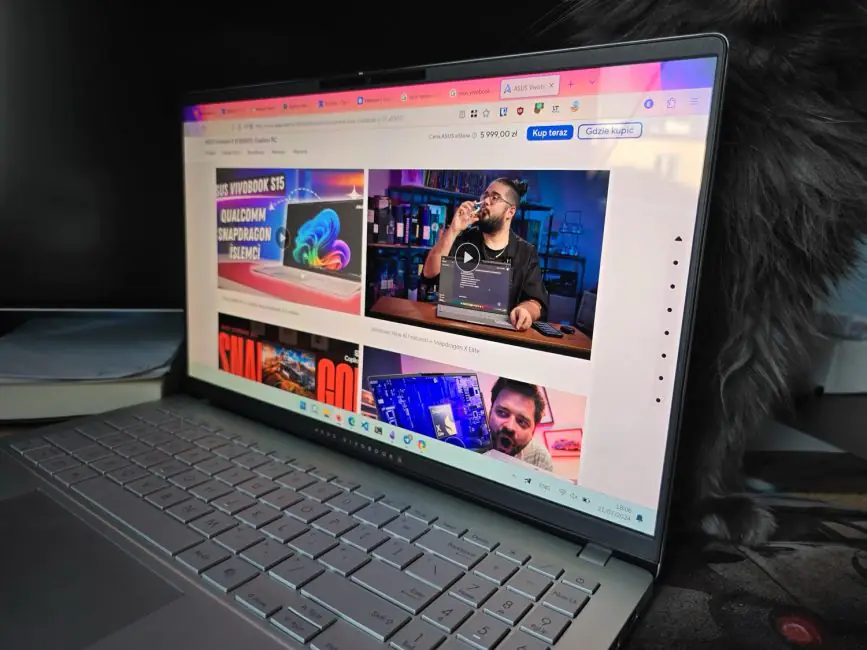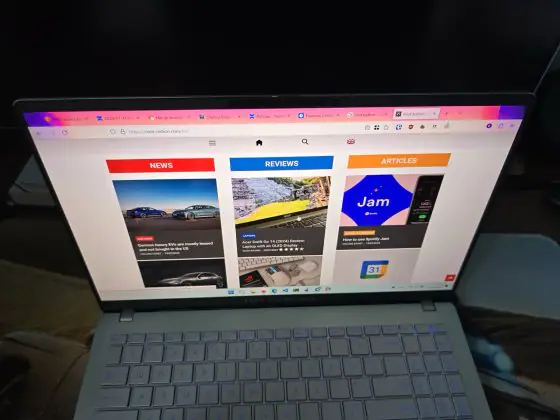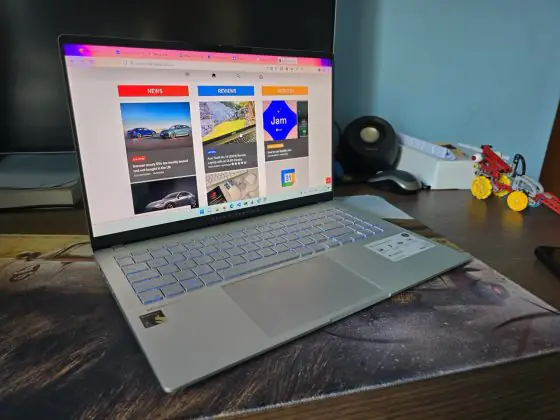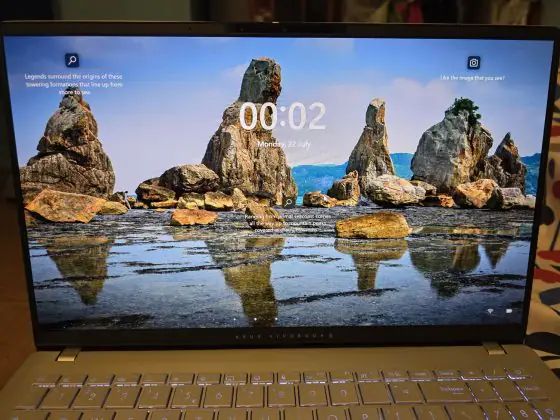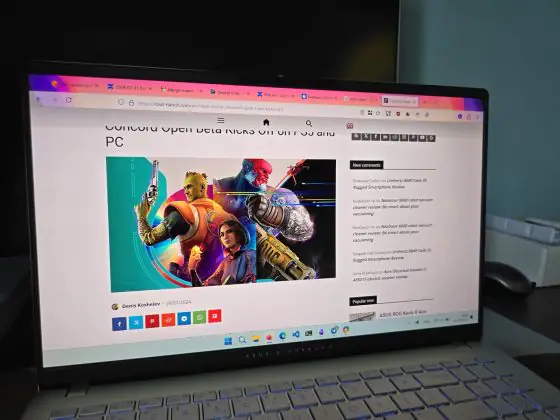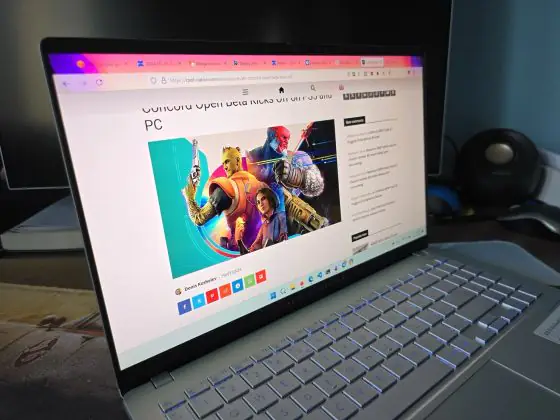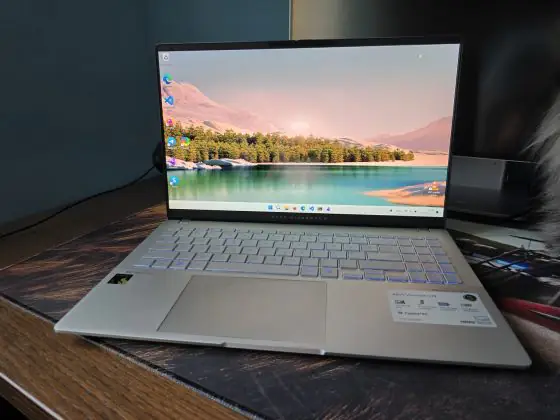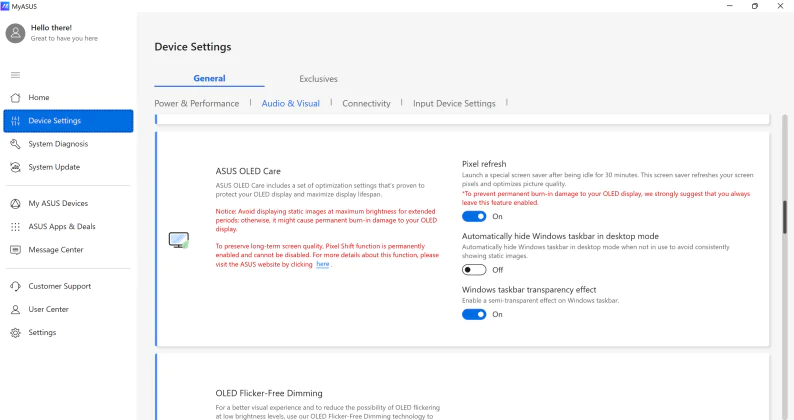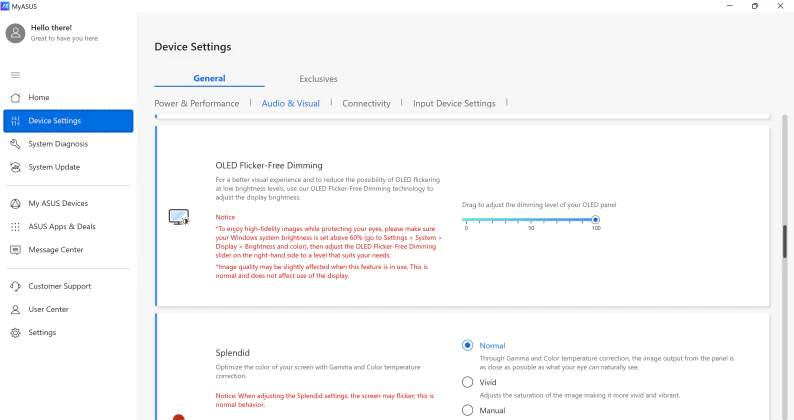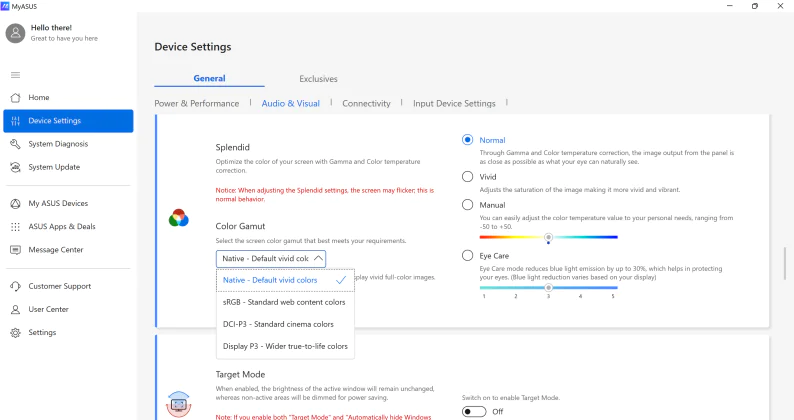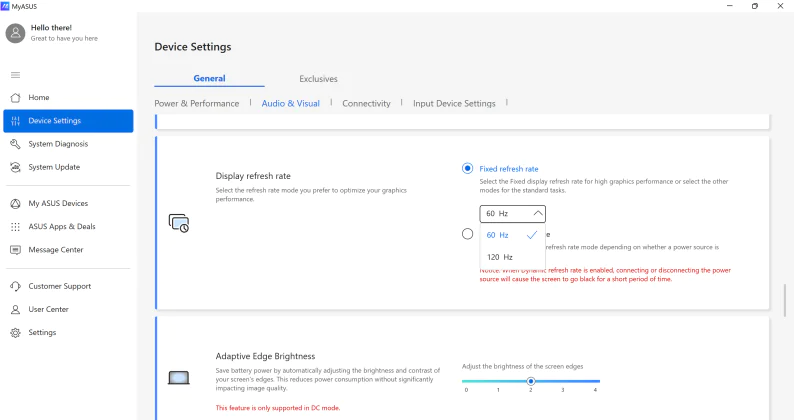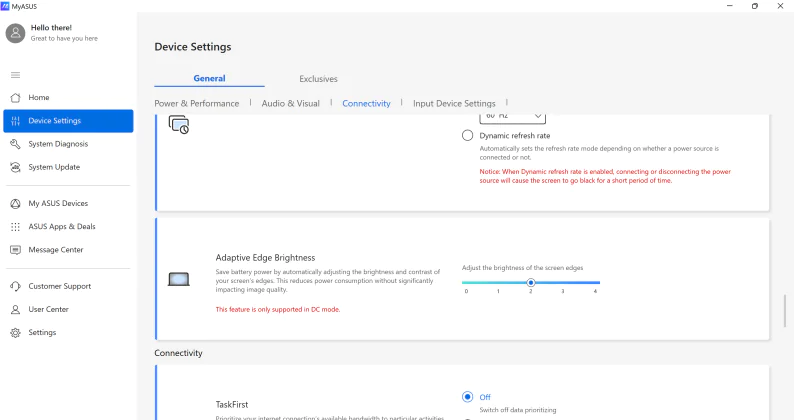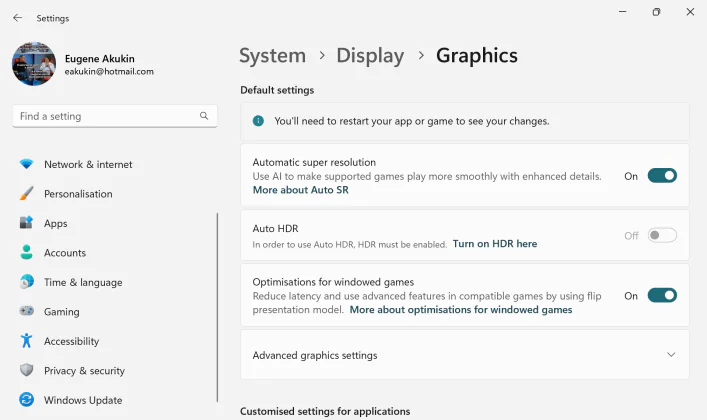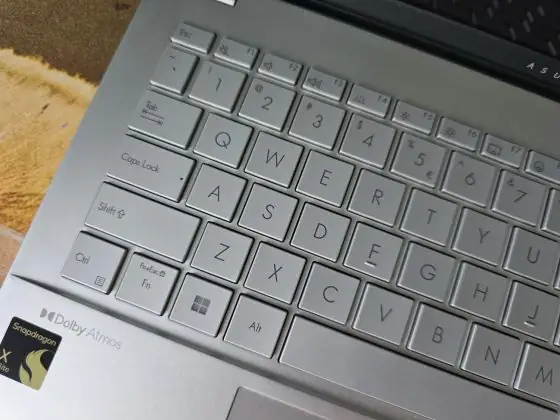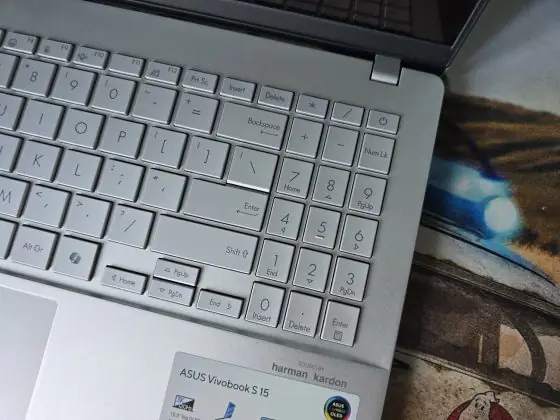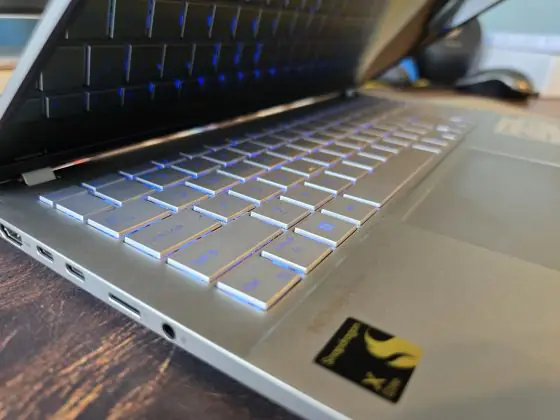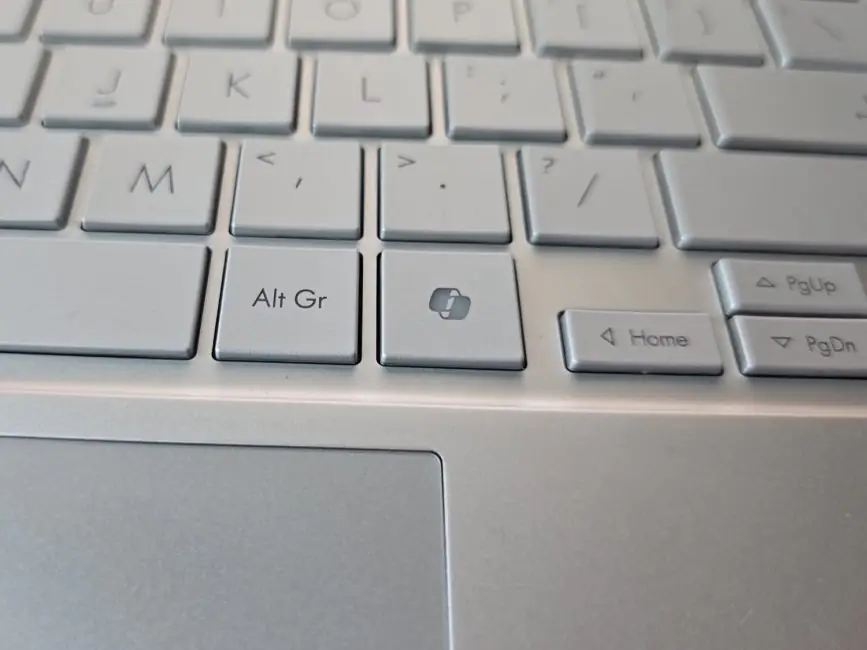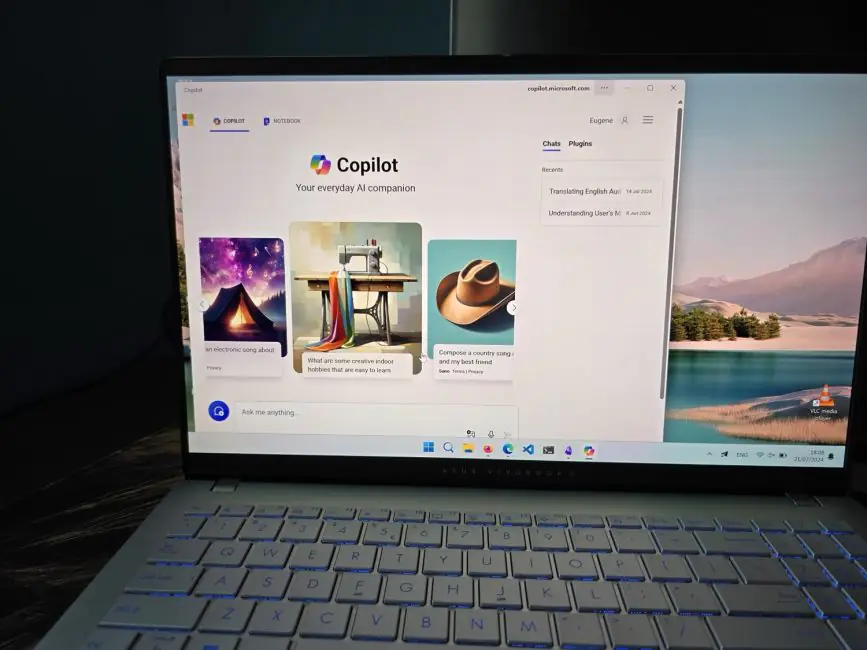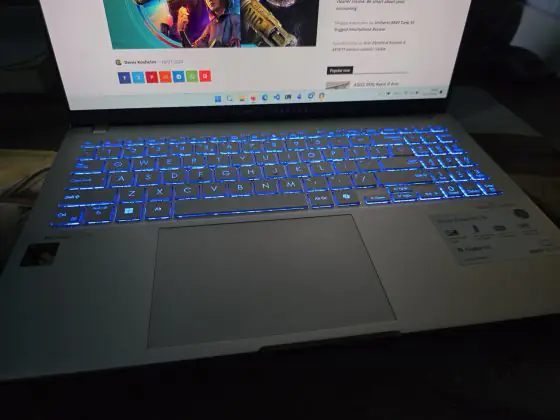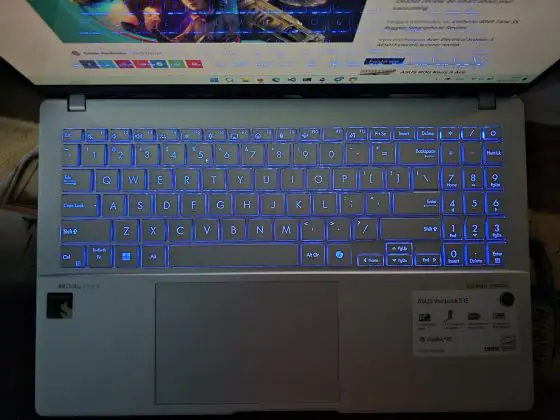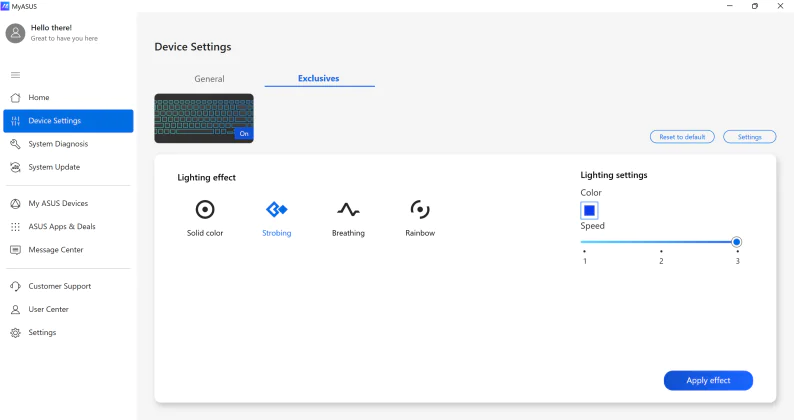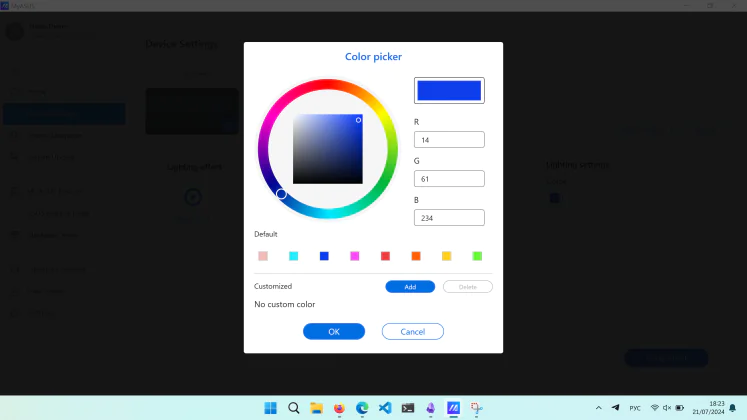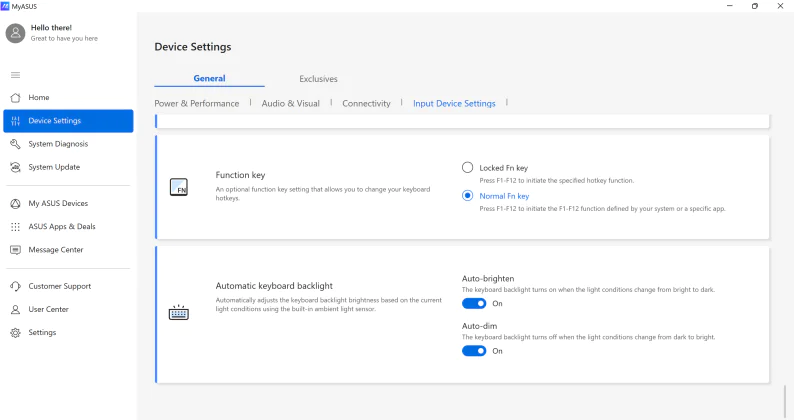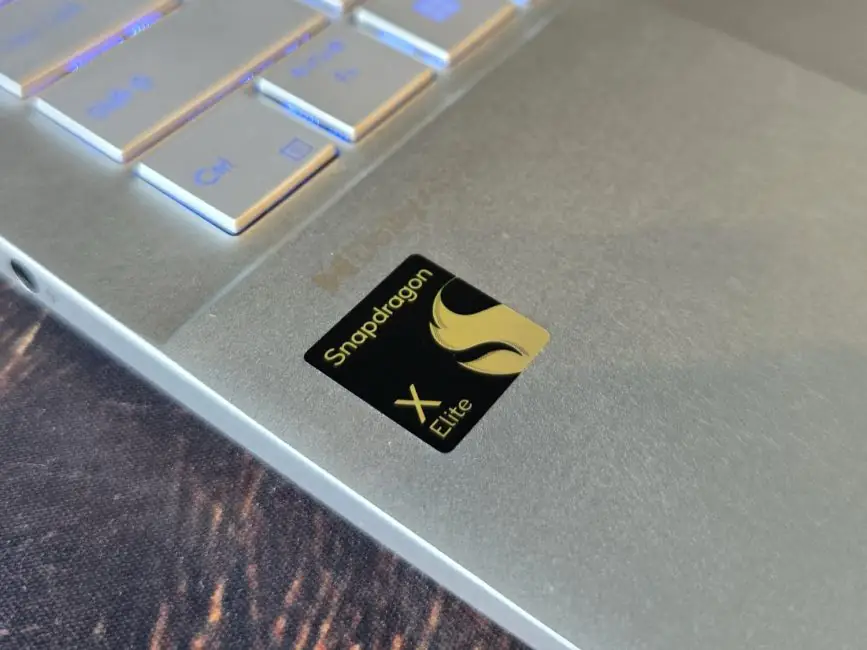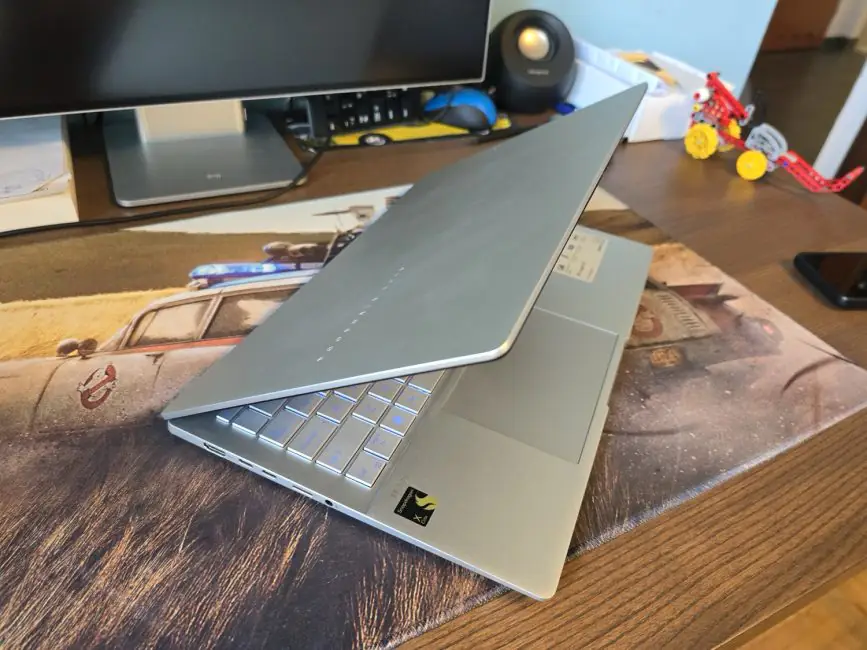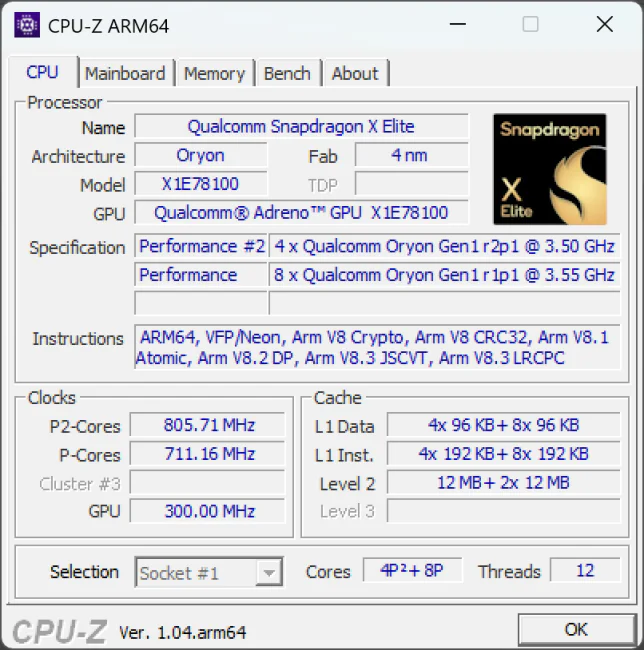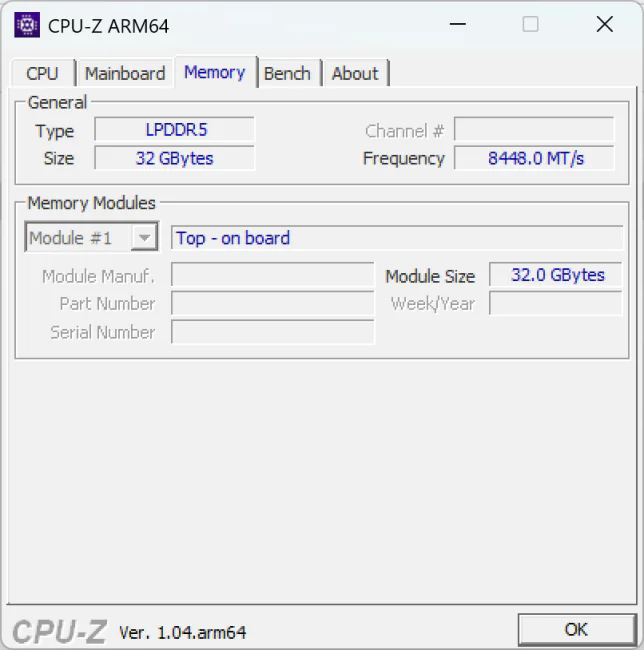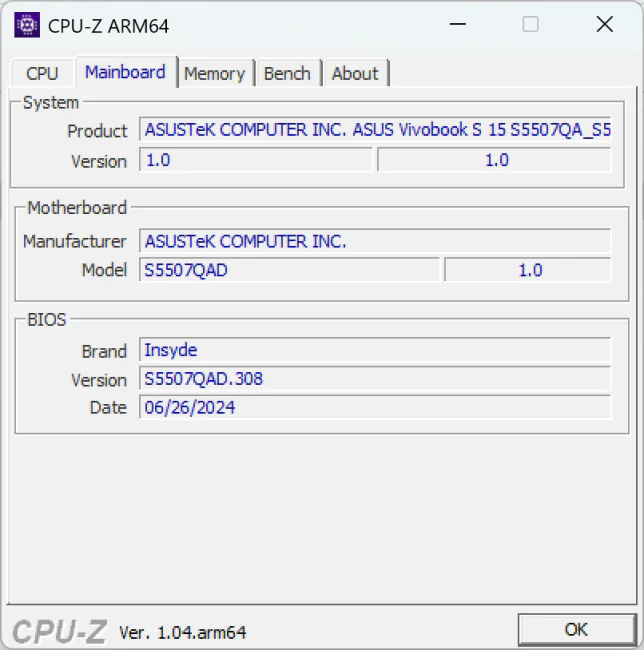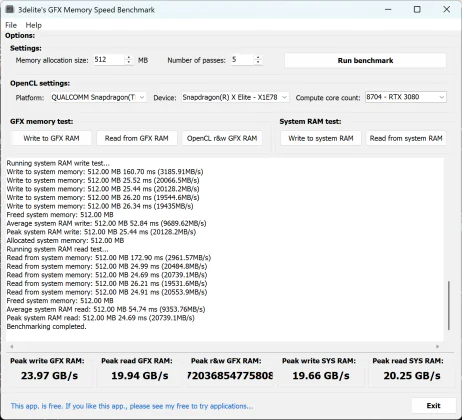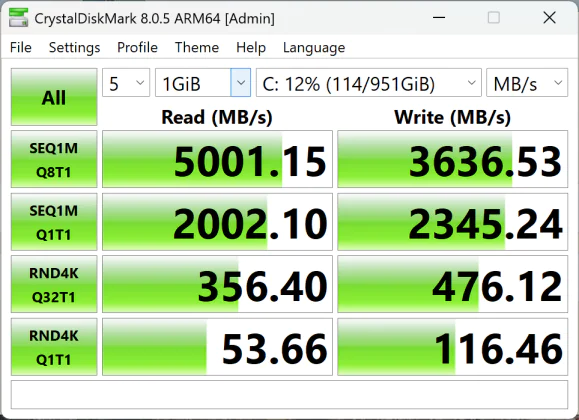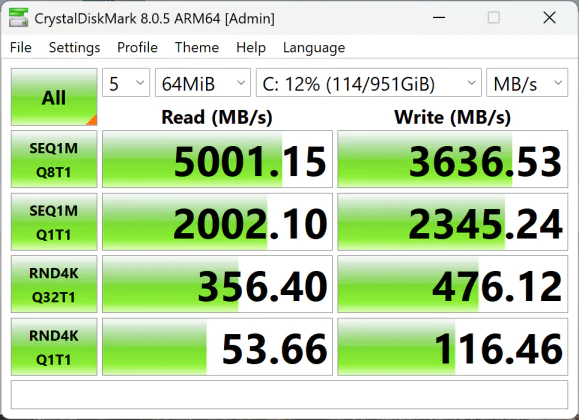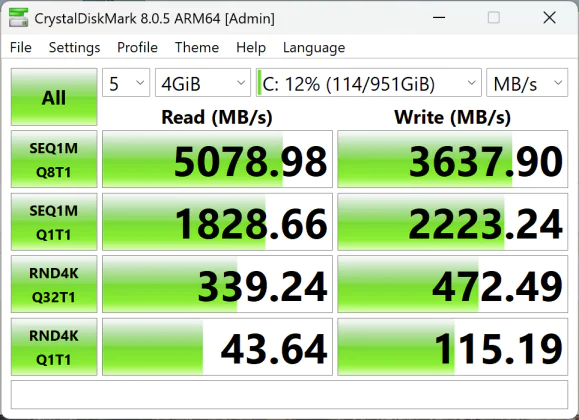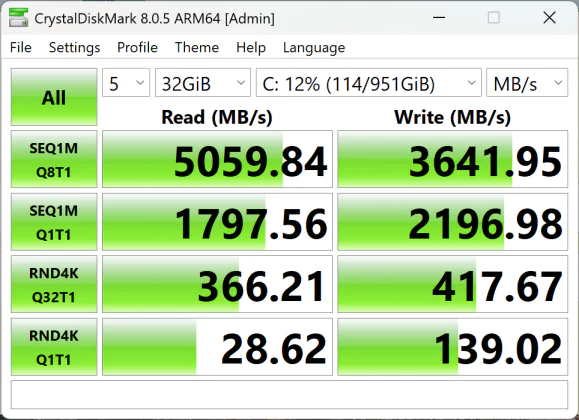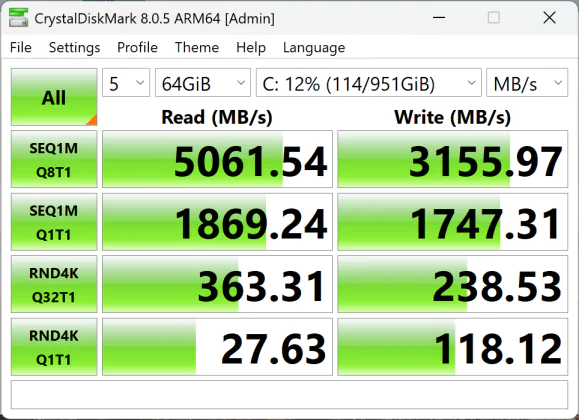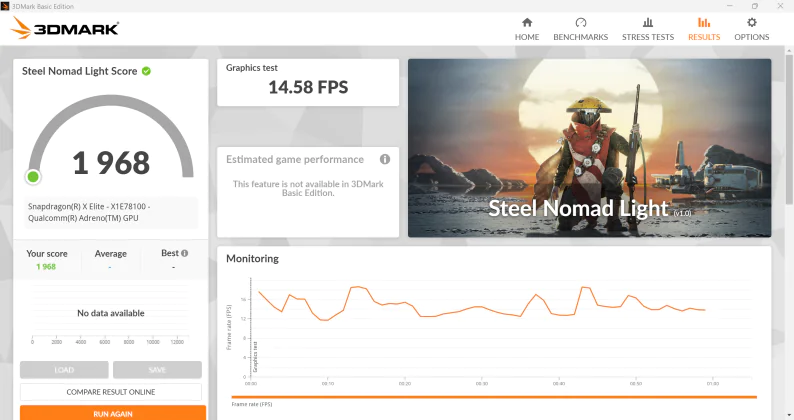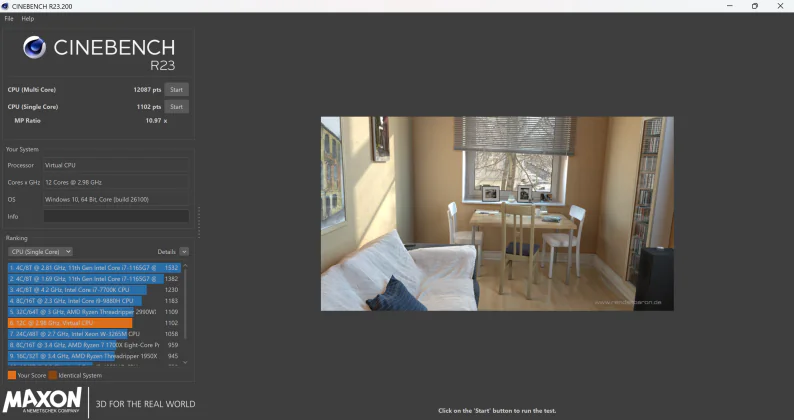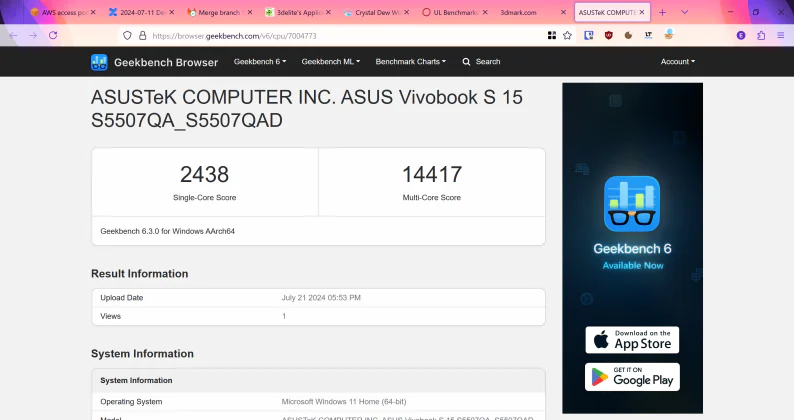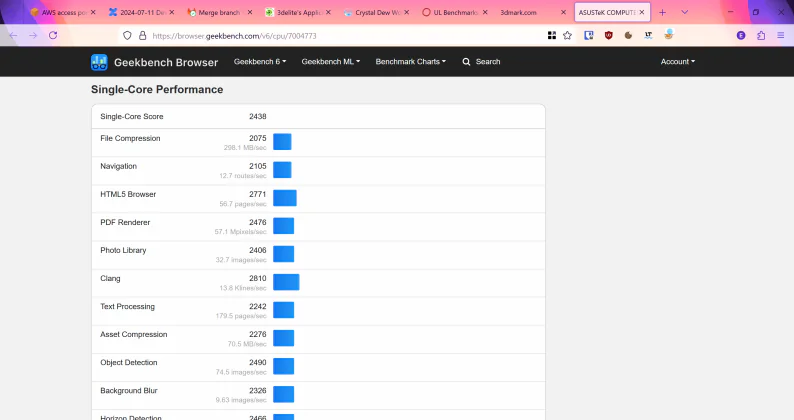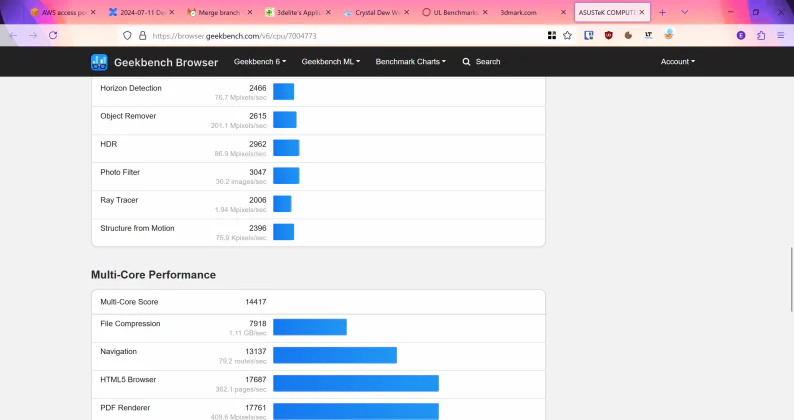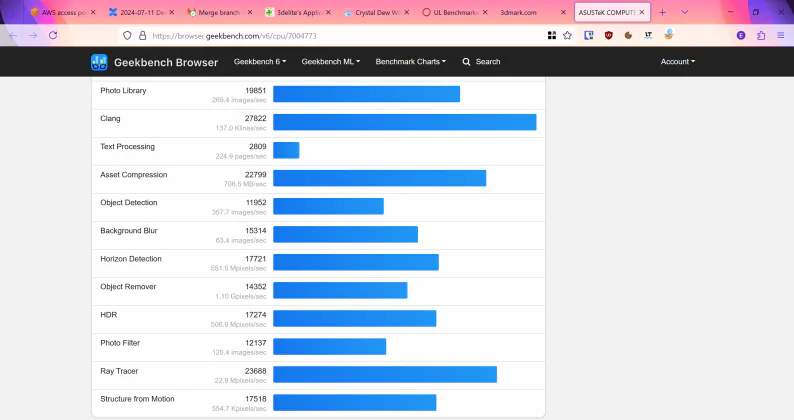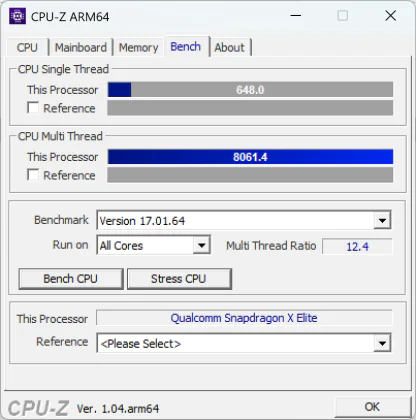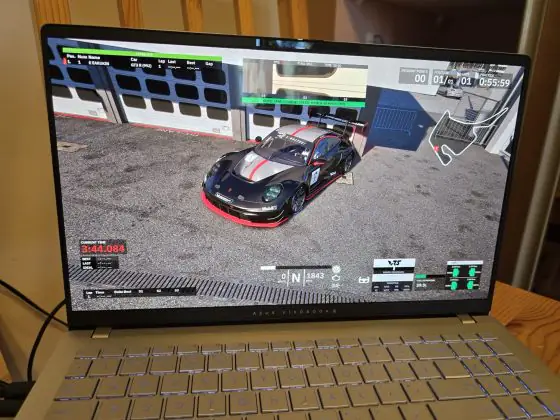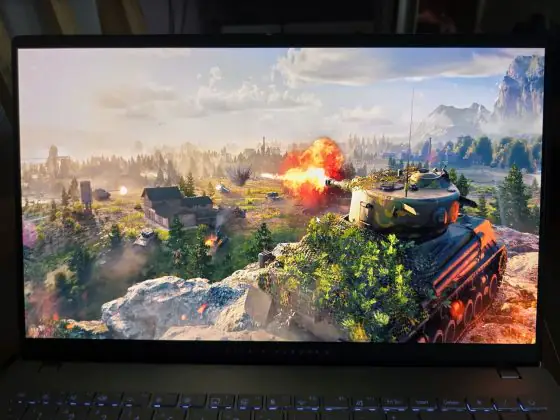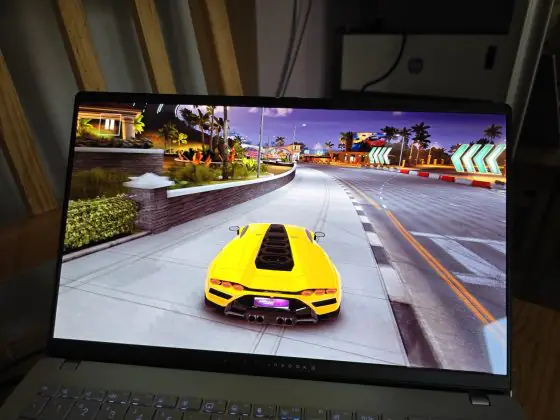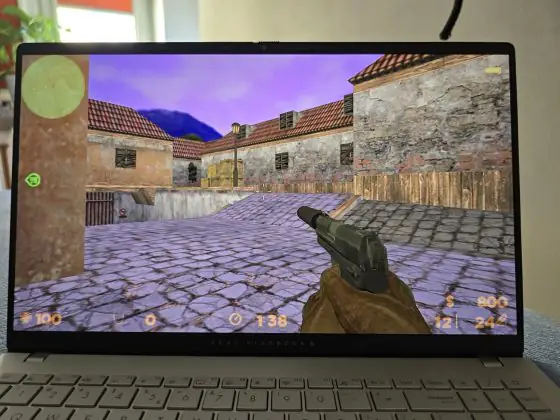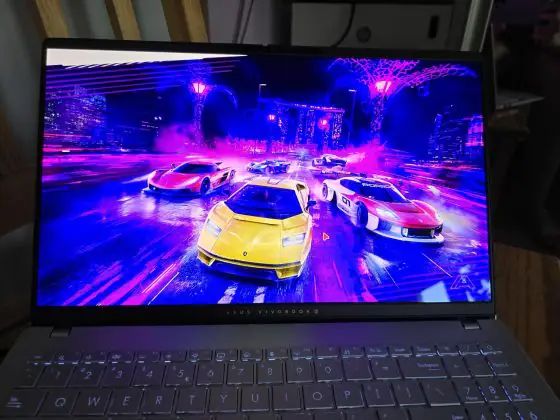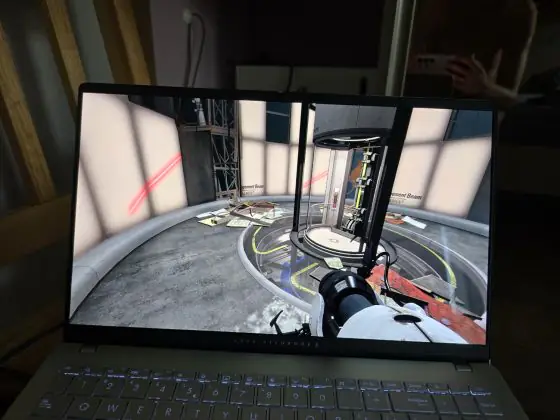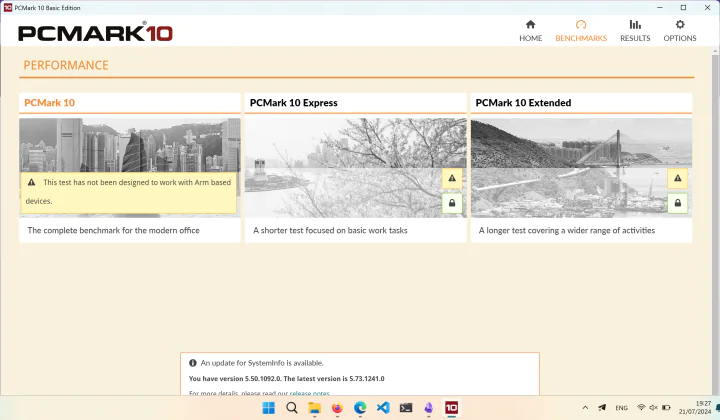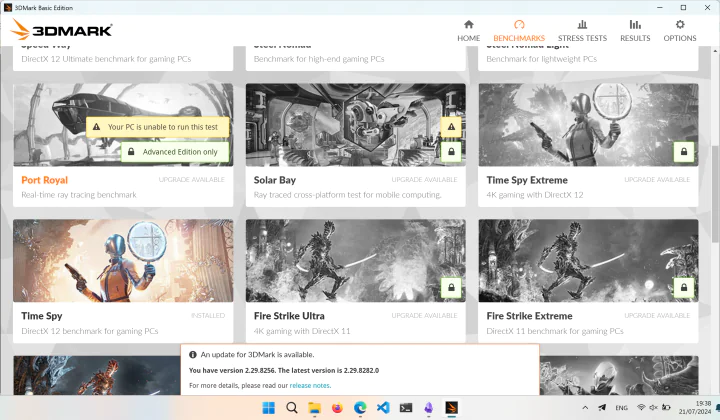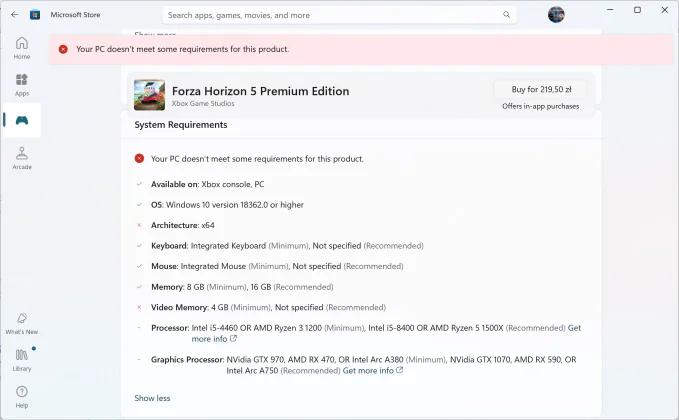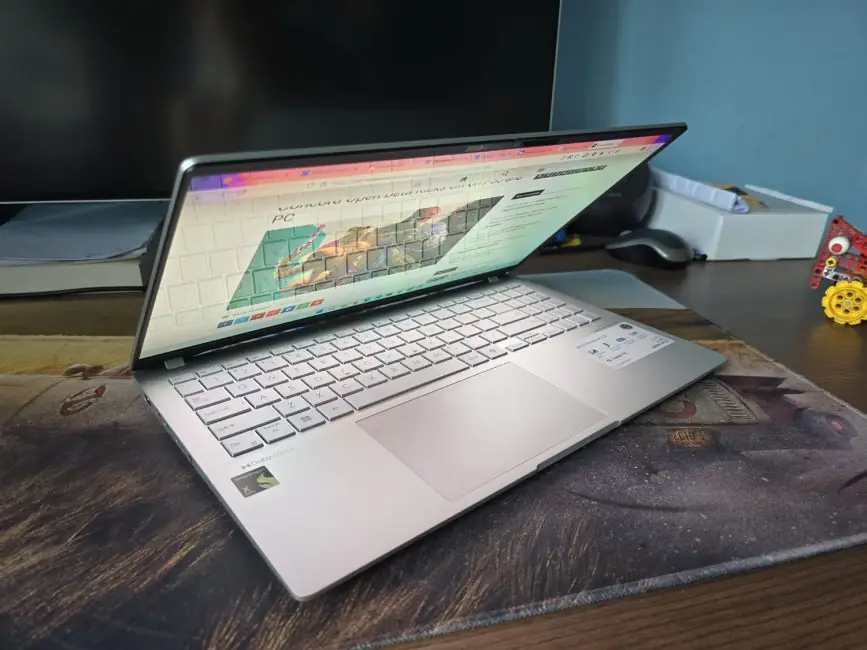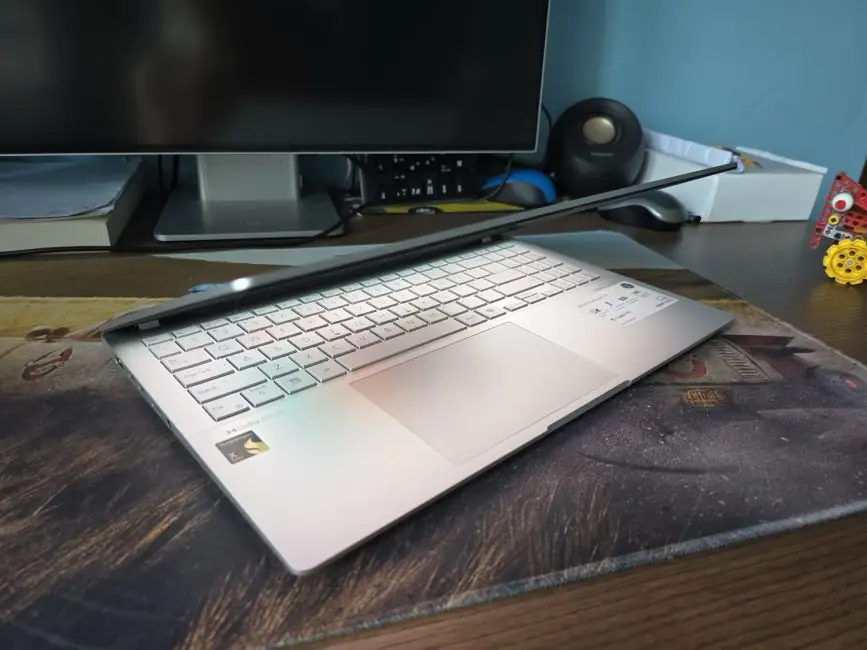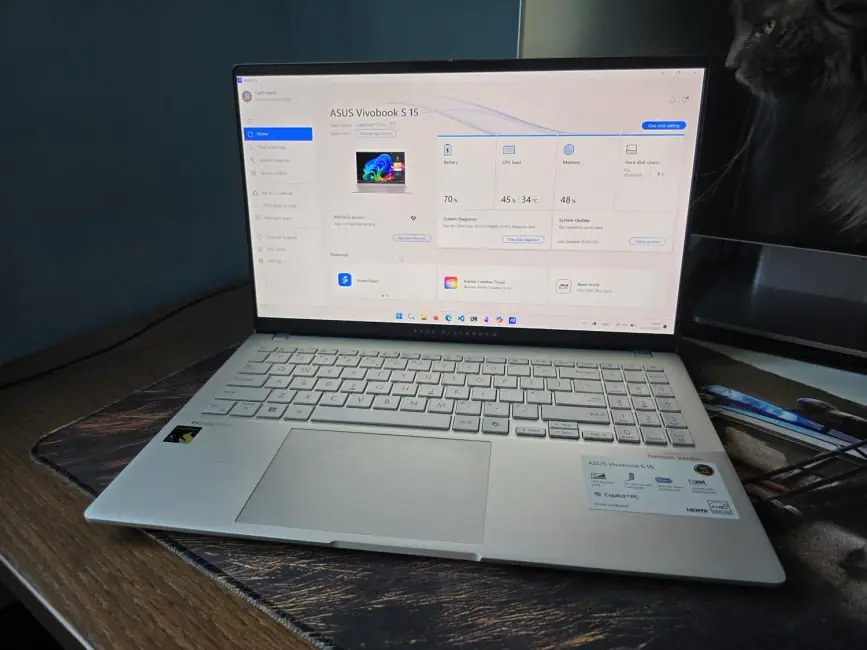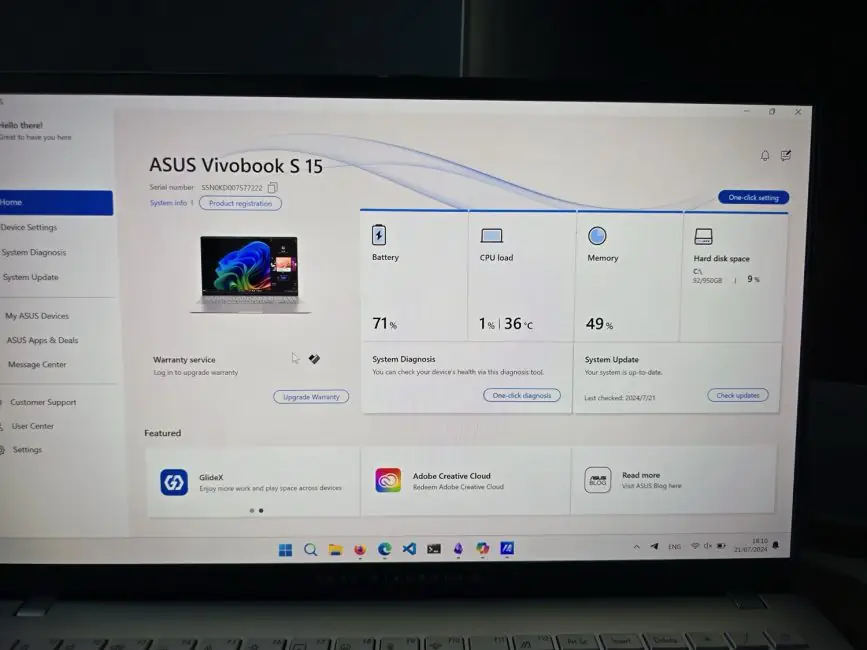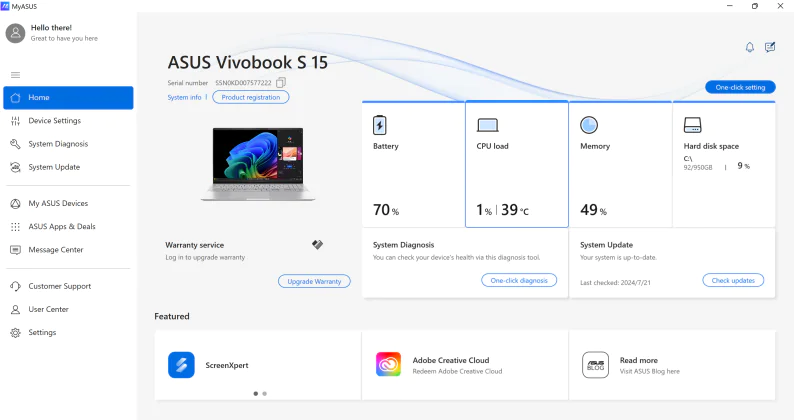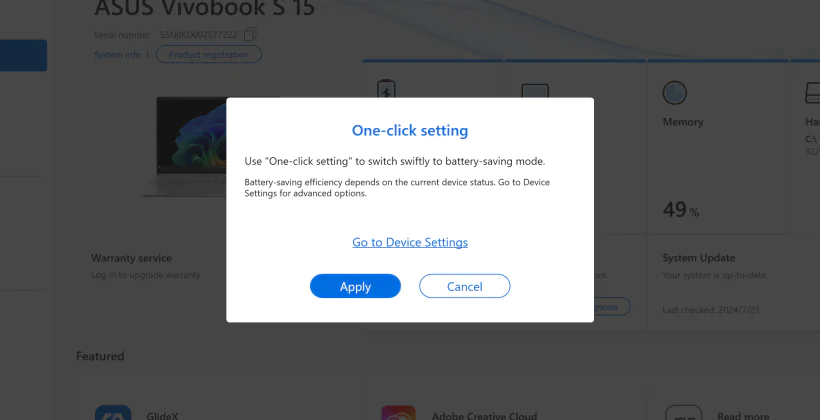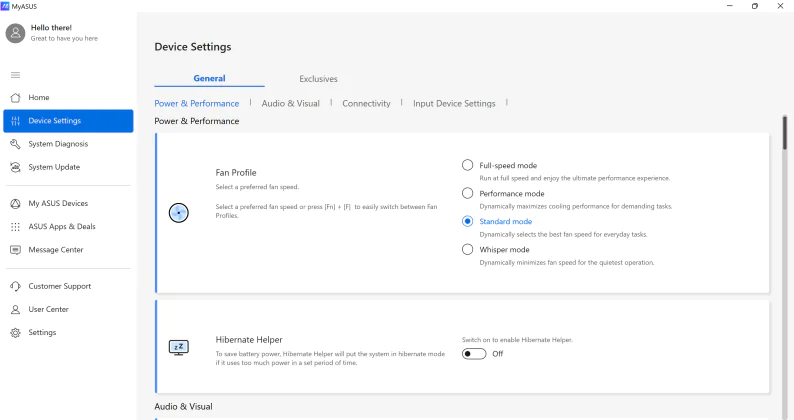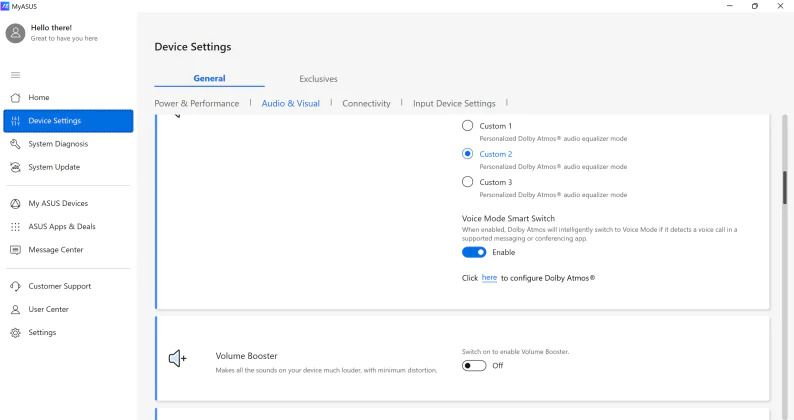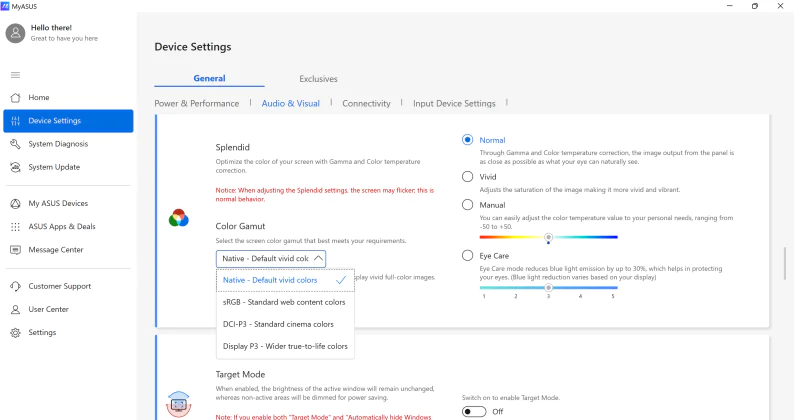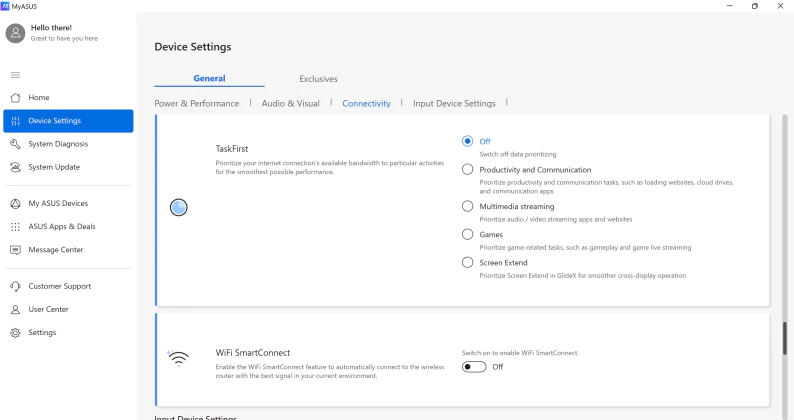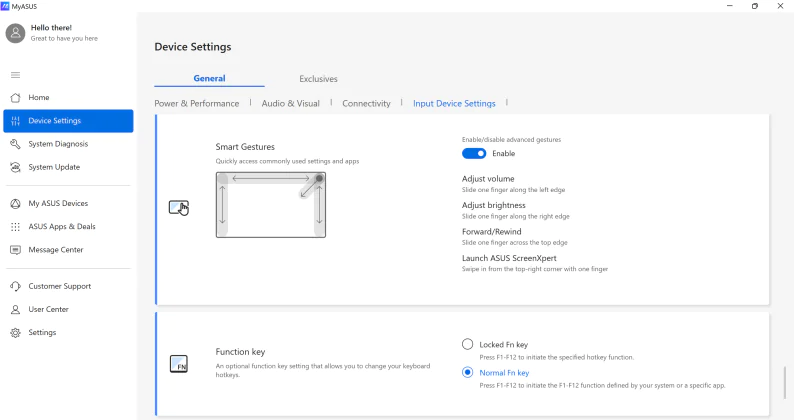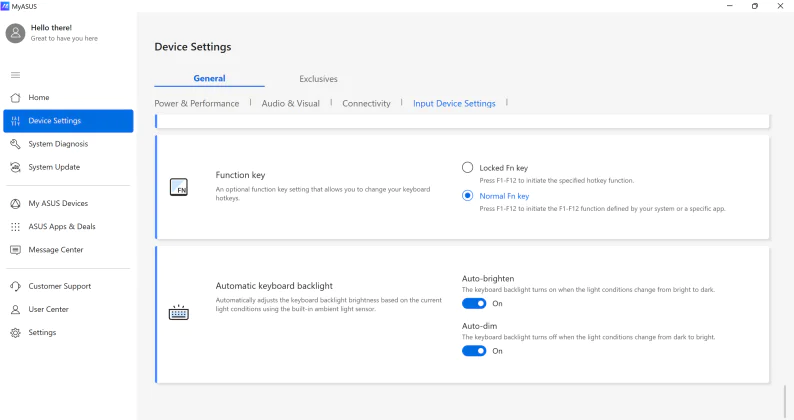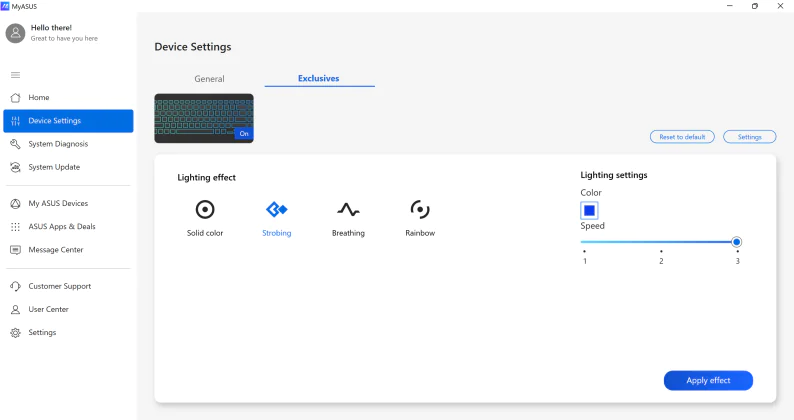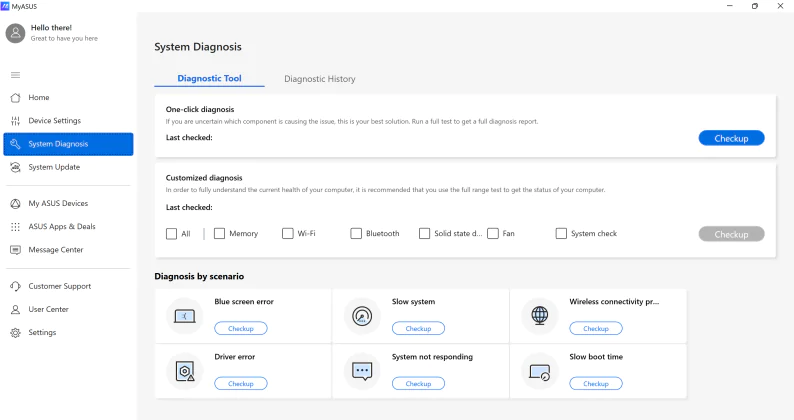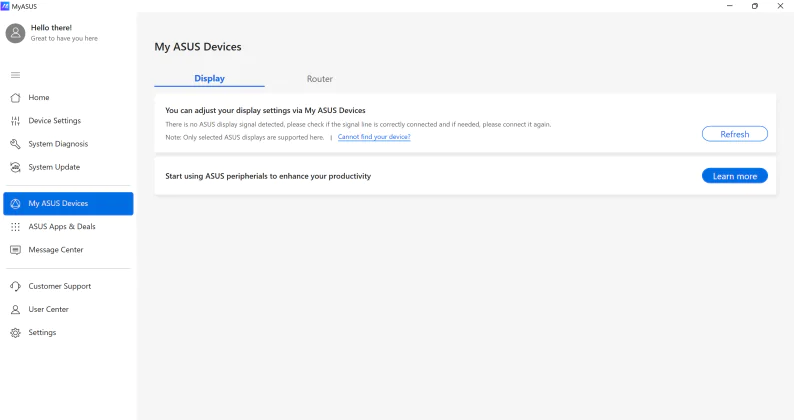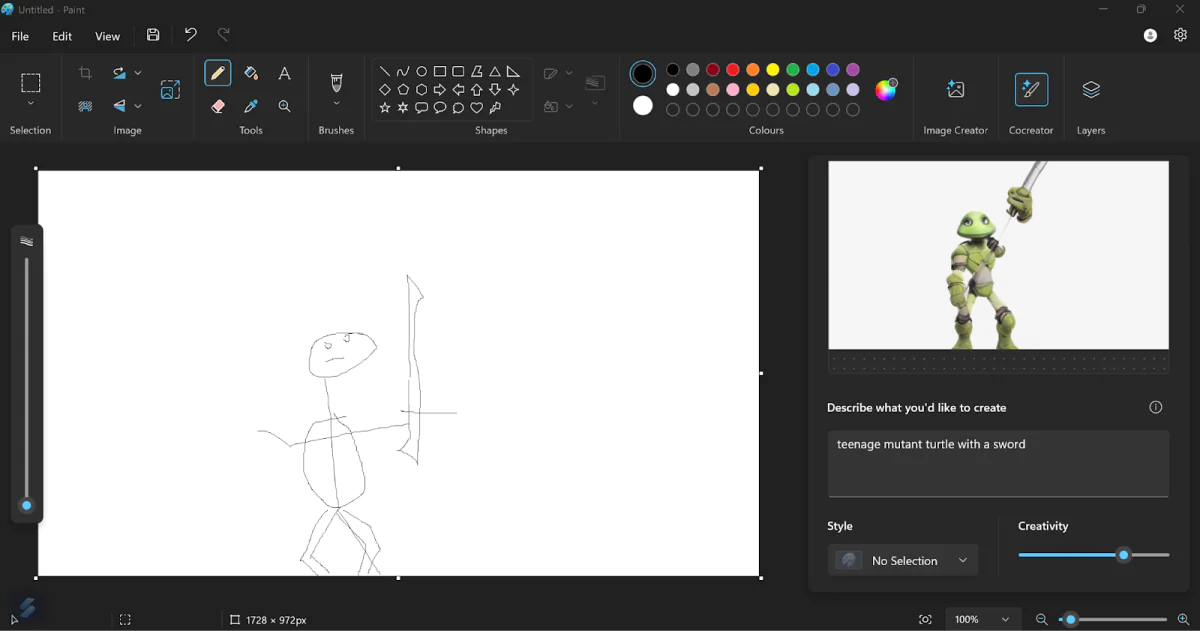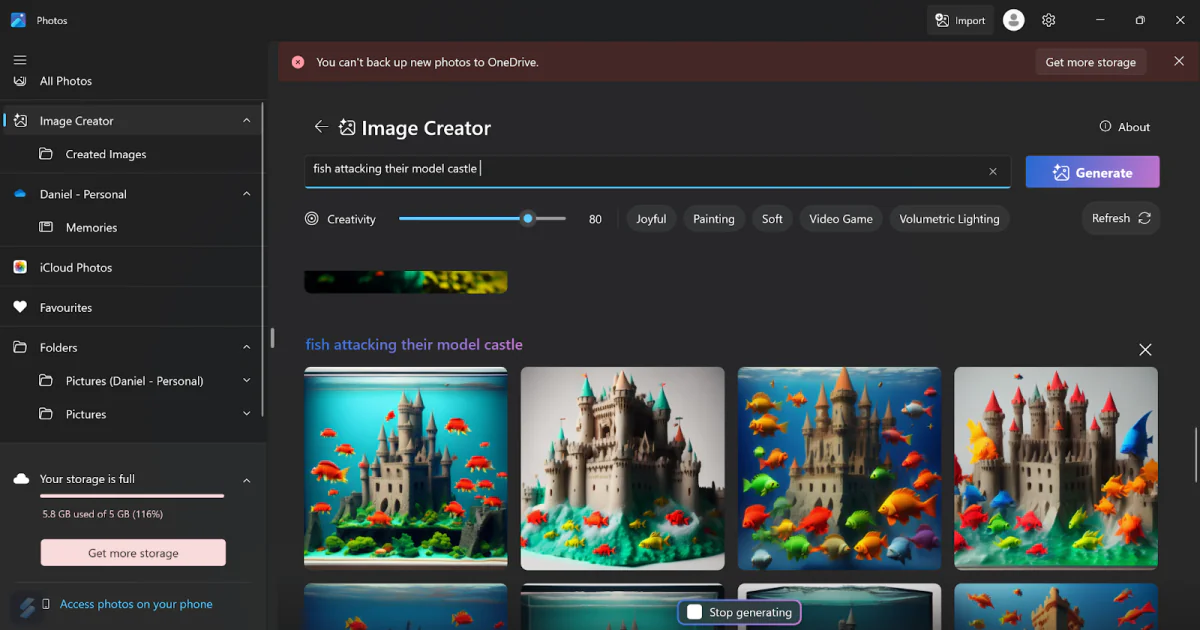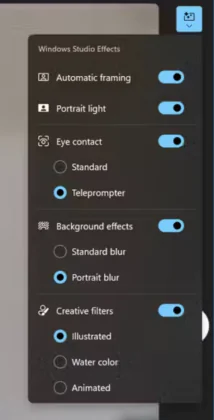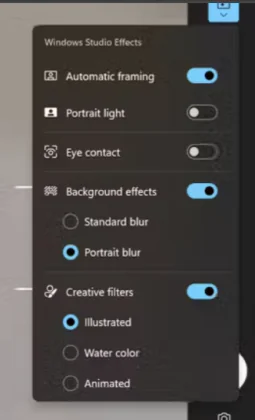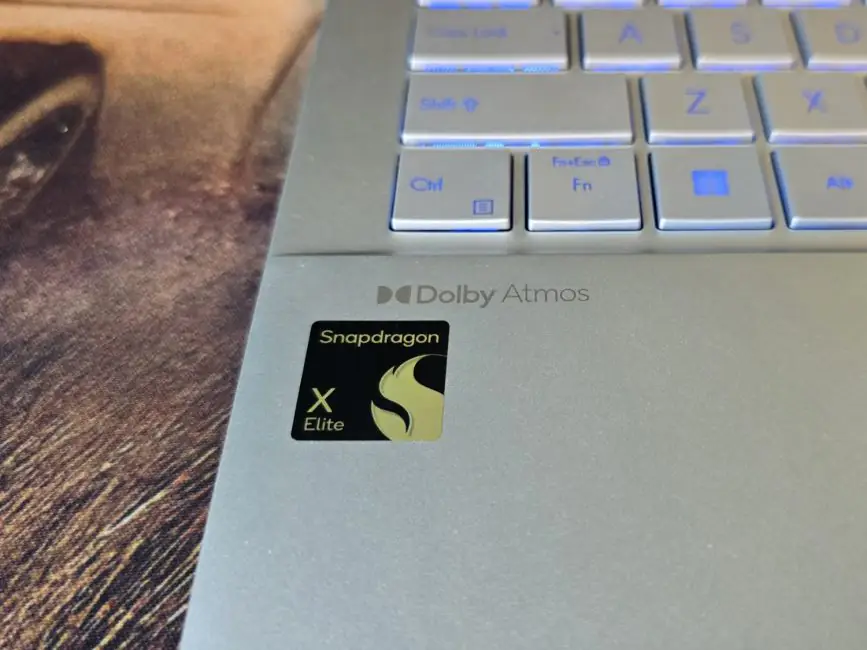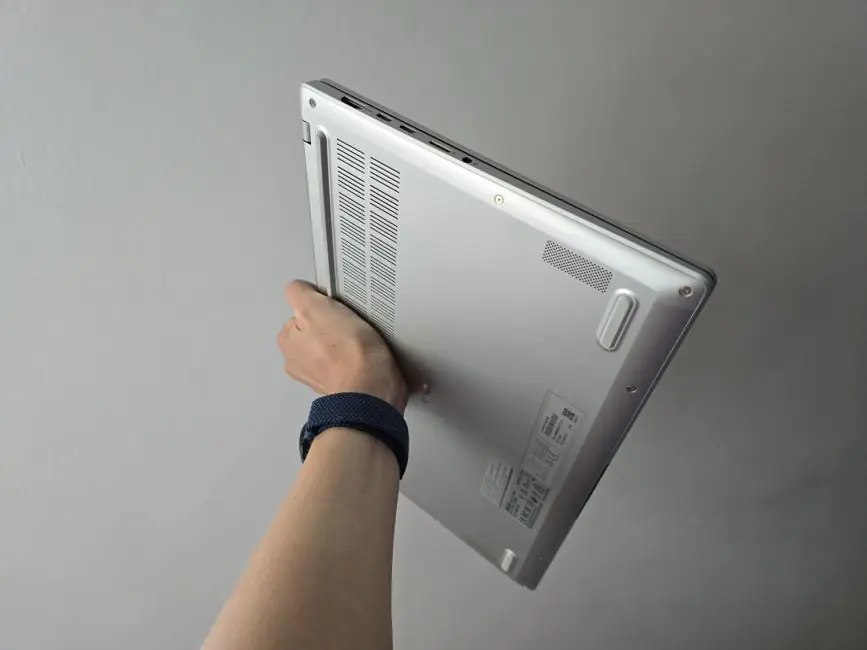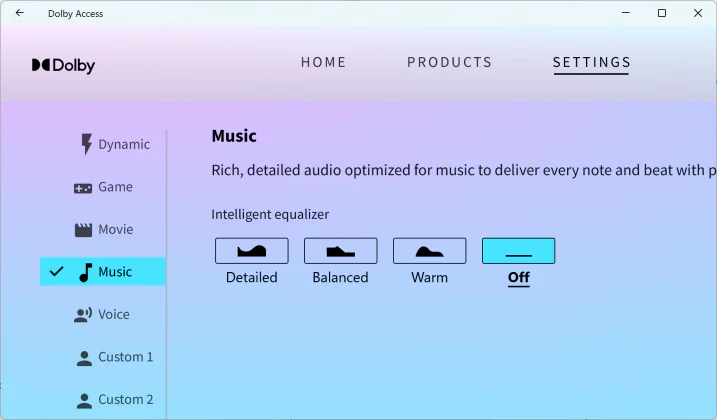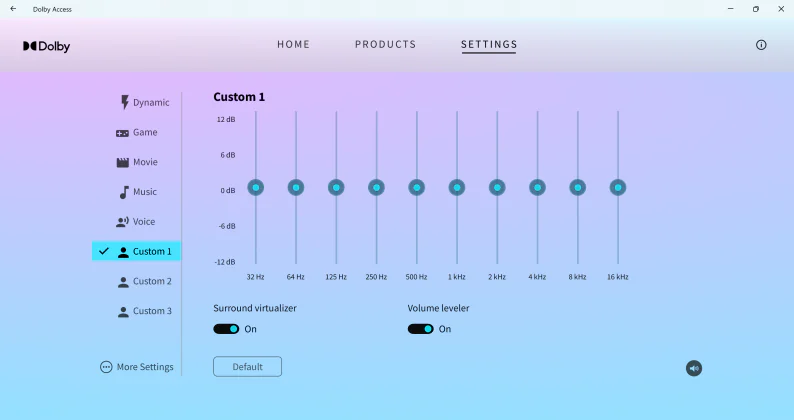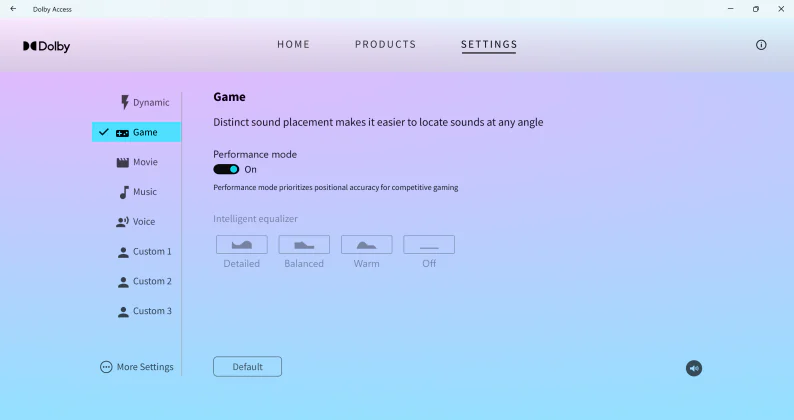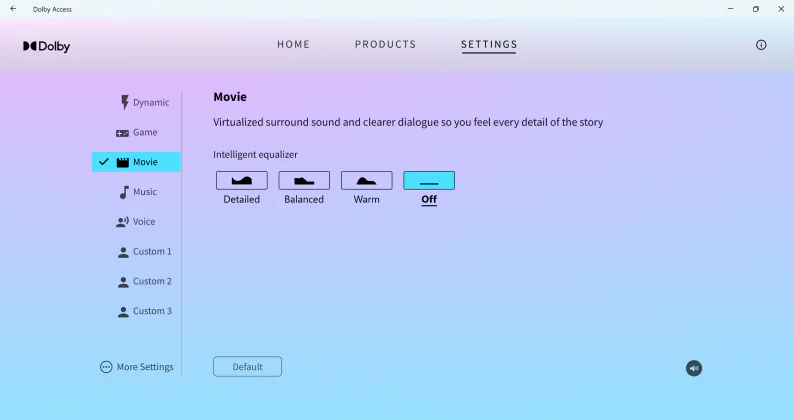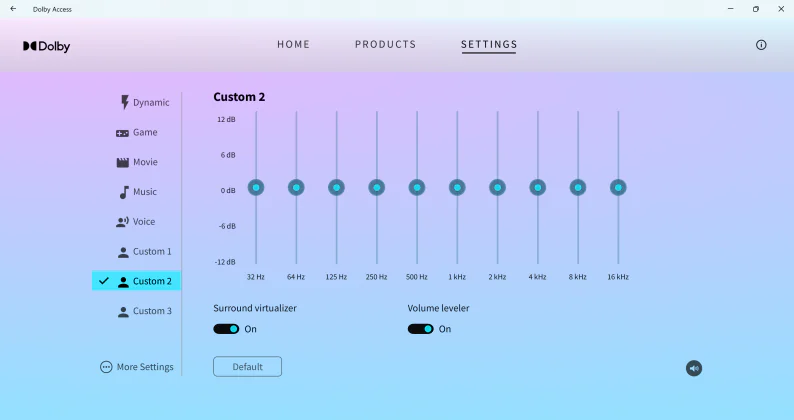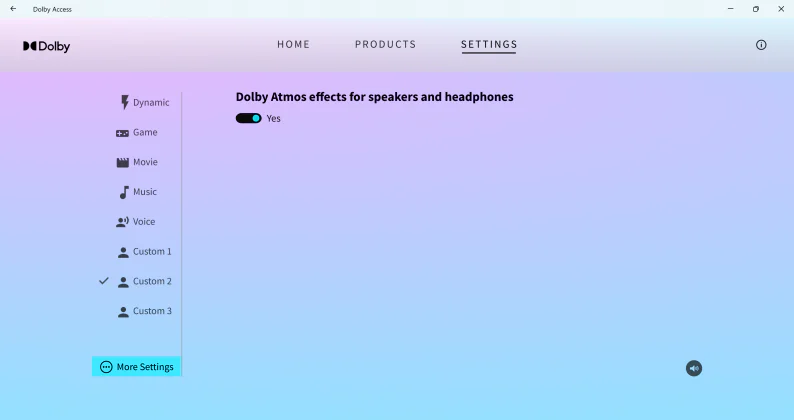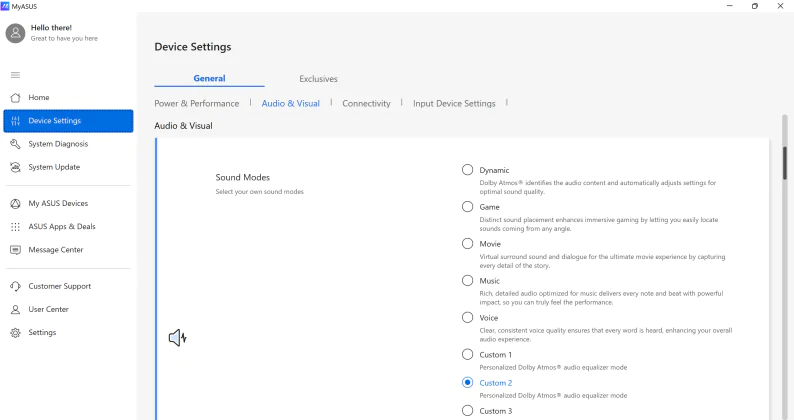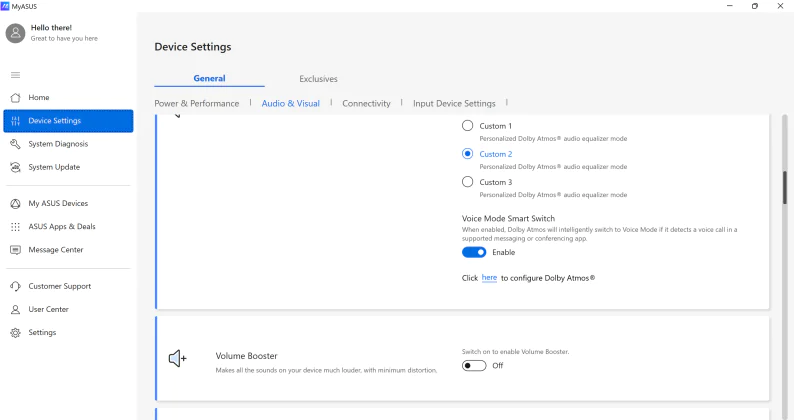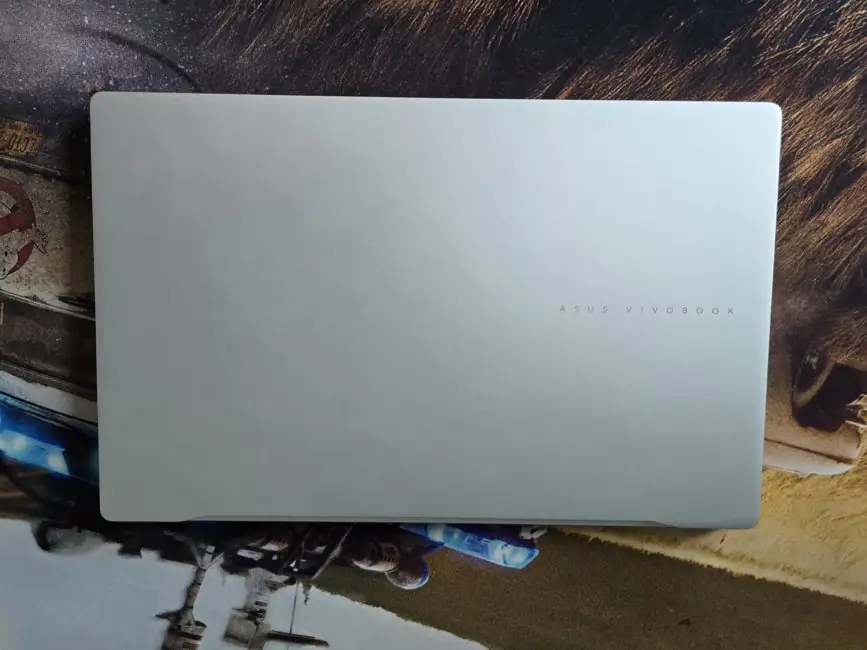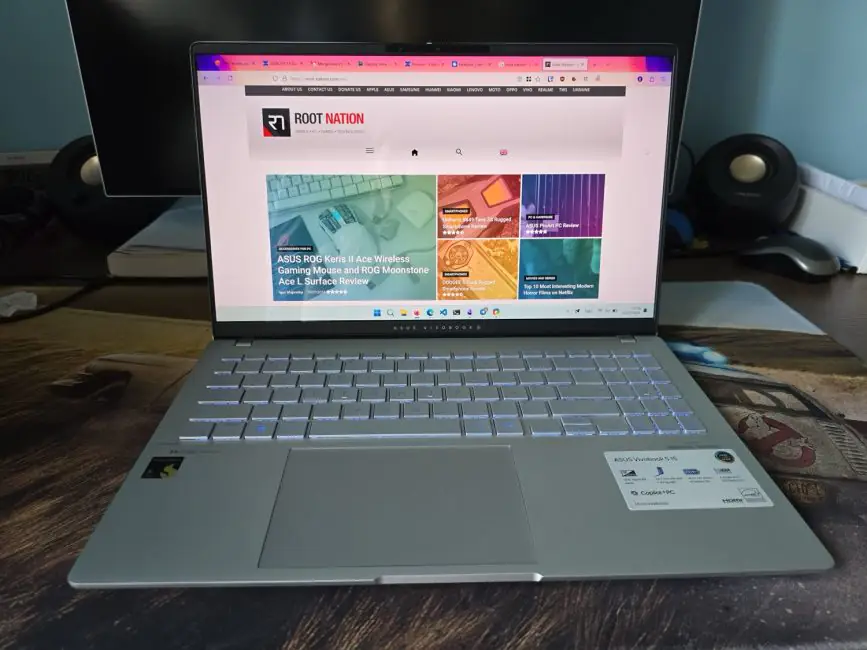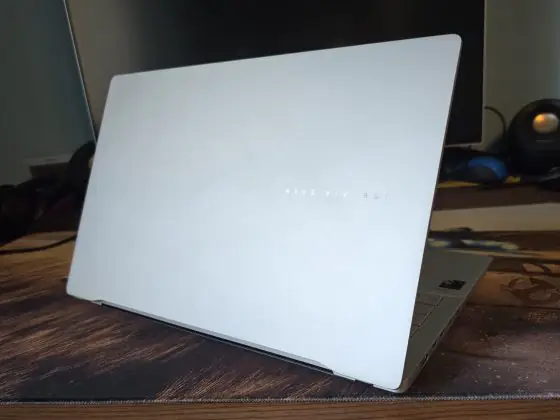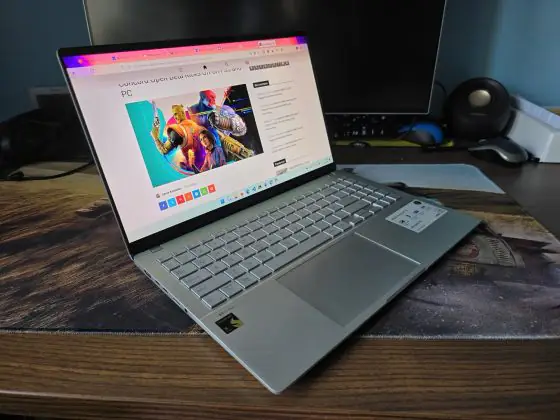© ROOT-NATION.com - Use of content is permitted with a backlink.
At the beginning of summer, a whole range of laptops featuring the new Qualcomm Snapdragon X processor was released. We covered the chipset and the initial models running on it in a previous article. Today, let’s dive into one of the first laptops equipped with this chipset—specifically, the more powerful version, the Snapdragon X Elite—namely, the ASUS Vivobook S 15 S5507 Copilot+.
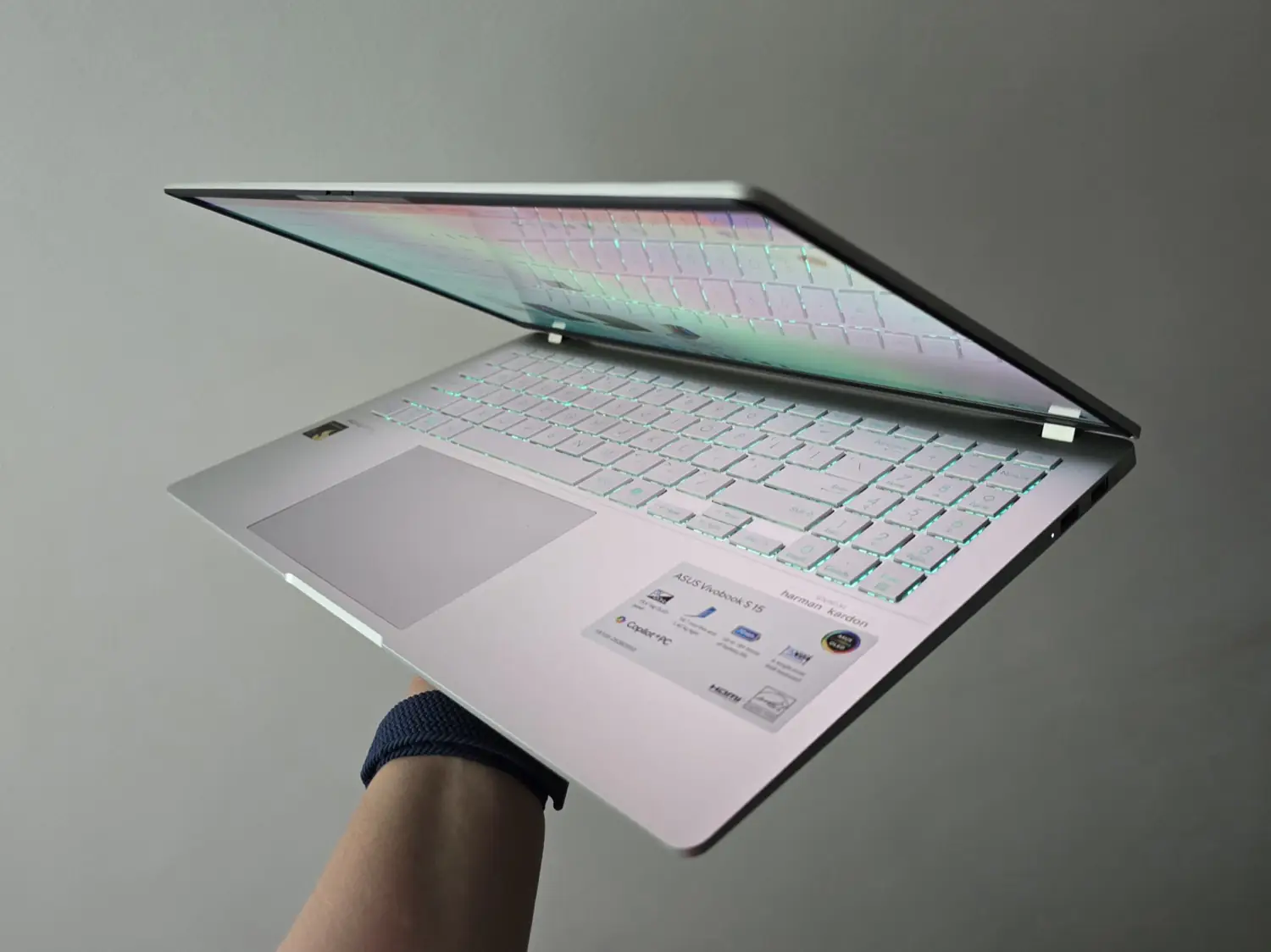
Many users have been eagerly anticipating new models based on Snapdragon X series processors. These are set to provide an alternative to Intel and AMD processors and compete with Apple laptops featuring proprietary M-series chips based on ARM architecture. Until recently, such chipsets were only used in smartphones and tablets, but now they’ve entered the laptop market, promising excellent performance without overheating and with long battery life—all running on Windows. Let’s see if it lives up to the hype.
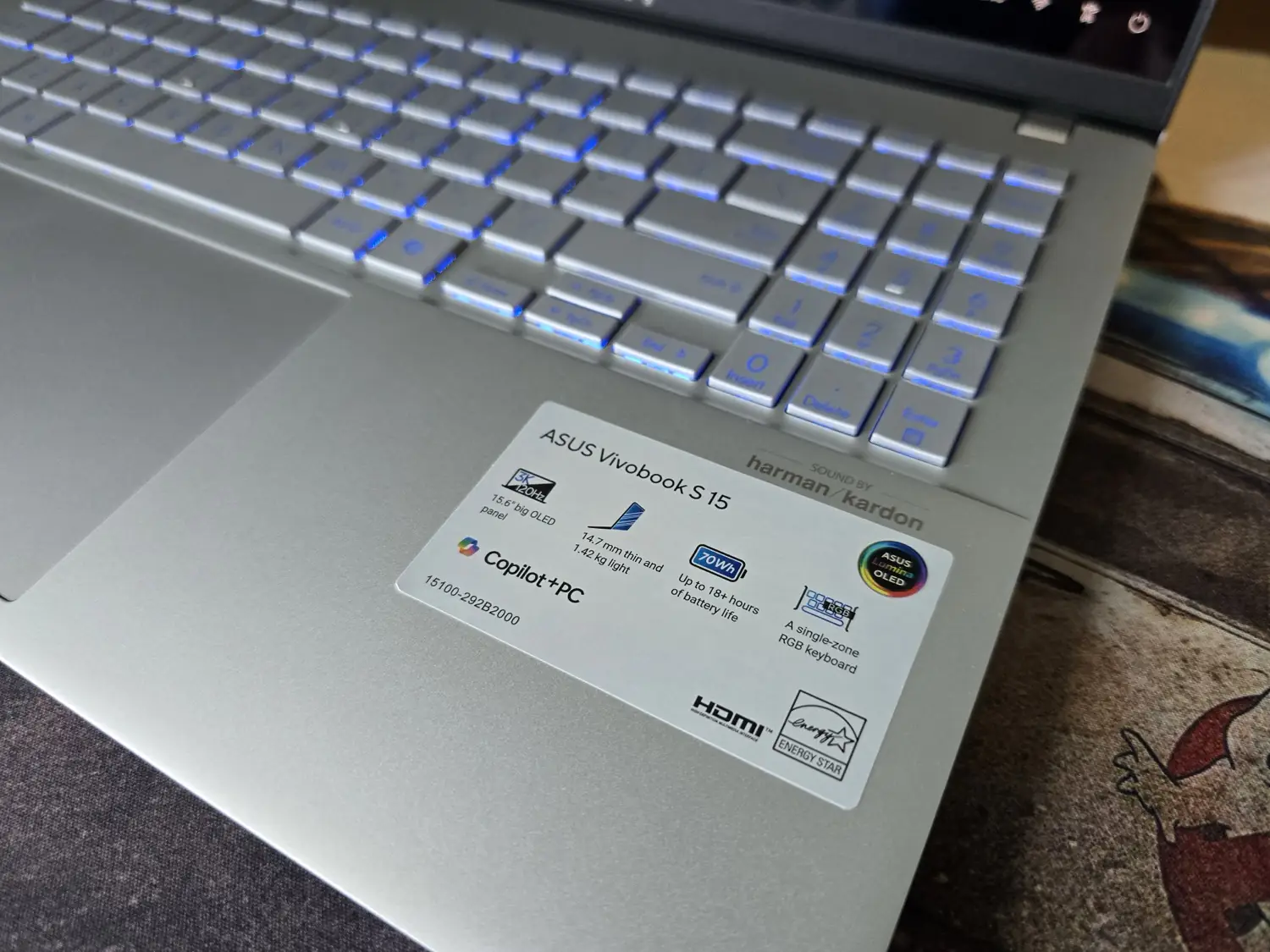
ASUS Vivobook S 15 S5507 specifications and price
There are two variants of this model, differentiated by chipset types (12-core Snapdragon X Elite X1E 78 or 10-core Snapdragon X Plus X1P 64), RAM options (16 GB or 32 GB), storage capacities (512 GB or 1 TB), and operating systems (Windows 11 Pro or Windows 11 Home).
We received the older one for testing, which is available in stores for $1460 / €1319. Its specifications:
- Processor: Qualcomm Snapdragon X Elite X1E-78-100 with 12 Oryon cores, 3 clusters of equal power; 12 threads, up to 3.4 GHz / Qualcomm Snapdragon X Plus X1P-64-100 with 10 cores up to 3.4 GHz
- Operating system: Windows 11 Home / Pro
- RAM: 16 GB or 32 GB LPDDR5x, with a frequency of up to 8533 MT/s, without the possibility of expansion
- Permanent memory: 512 GB / 1 TB SSD, M.2 NVMe PCIe 4.0
- Graphics: Built-in Qualcomm Adreno with support for up to three external 4K 60Hz displays
- Neuroprocessor (NPU): Qualcomm Hexagon, up to 45TOPS
- Screen: 15.6 inches, OLED, 3K resolution (2880×1620), refresh rate up to 120 Hz, 16:9 aspect ratio, 0.2 ms response time, brightness up to 600 nits, 1000000:1 contrast, 100% color gamut coverage 100% DCI-P3, VESA DisplayHDR True Black 600, TÜV Rheinland-certified, SGS Eye Care Display, glossy
- Ports and connectors:
- 2×USB 3.2 Gen 1 Type-A
- 2×USB 3.2 Gen 1 Type-C (with support for DisplayPort and Power Delivery)
1×HDMI 2.1 TMDS - 1×3.5 mm combo audio jack
- 1× microSD slot
- Battery: 70 Wh, 3-cell, included 90 W charger with 20 VDC, 4.5 A specifications, up to 18 hours of operation on a single charge
- Wireless communication: Wi-Fi 7 (802.11be, Tri-band), Bluetooth 5.4
- Keyboard and touchpad: full-size island keyboard with single-zone RGB backlight, number pad (Num-key), 1.7 mm key travel and dedicated Copilot key, high-precision multi-touch touchpad
- Camera: Full HD with mechanical shutter and support for Windows Hello
- Audio: stereo speakers with Smart Amp technology, harman/kardon sound enhancement, built-in speaker and spatial microphone
- Dimensions and weight: 35.0×23.0×1.5~1.6 cm, weight 1.42 kg
- Built-in software: StoryCube, MyASUS, ScreenXpert, GlideX
- Optional: MIL-STD 810H military compliant body, 1-year Microsoft 365 Personal subscription, 3-month XBOX Game Pass subscription, support for AI-based technologies (Copilot+) to improve application performance and extend battery life
Read also: ASUS ROG Zephyrus G16 2024 (GU605MI-QR064W) Gaming Laptop Review
Package contents
The laptop comes in a compact box with a 90W charger (plus a USB-C cable) and a user manual. The charger is compact and portable, similar to those for smartphones. Additionally, the box can be transformed into a laptop stand!
Design and build
ASUS Vivobook S 15 boasts a stylish and elegant appearance. Though it may sound like advertising, it’s true. The chassis is crafted from anodized aluminum, formed from a single piece of metal. The top cover features a minimalist embossing of the model name.
The only downside is that the surface of the chassis easily shows smudges. Despite my efforts to clean it with various cloths, the marks remained.
The laptop can be easily opened with one hand, and the hinge allows it to be opened up to a full 180°.

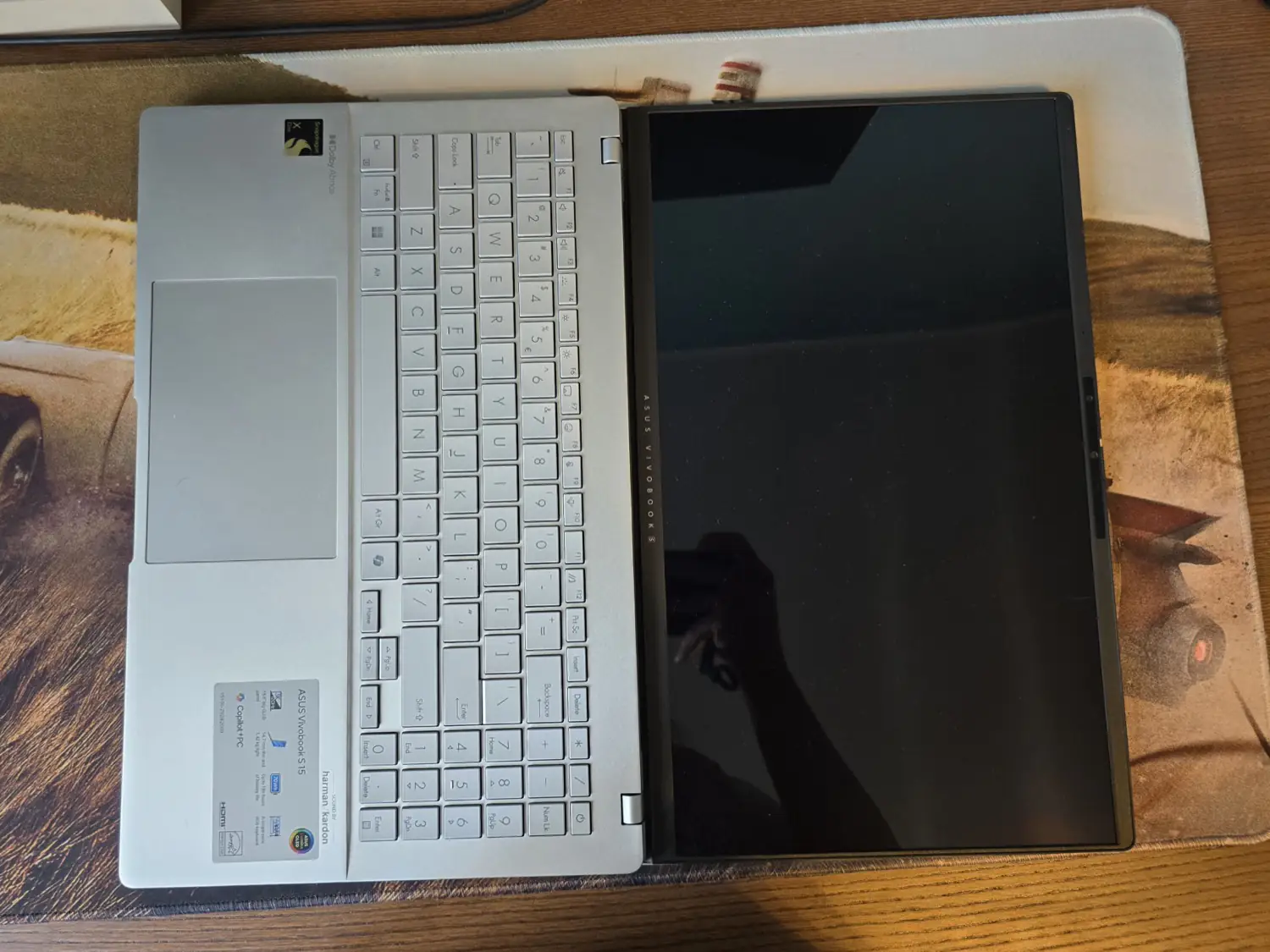
The screen has minimal bezels, especially on the sides. The front camera features a physical privacy shutter.
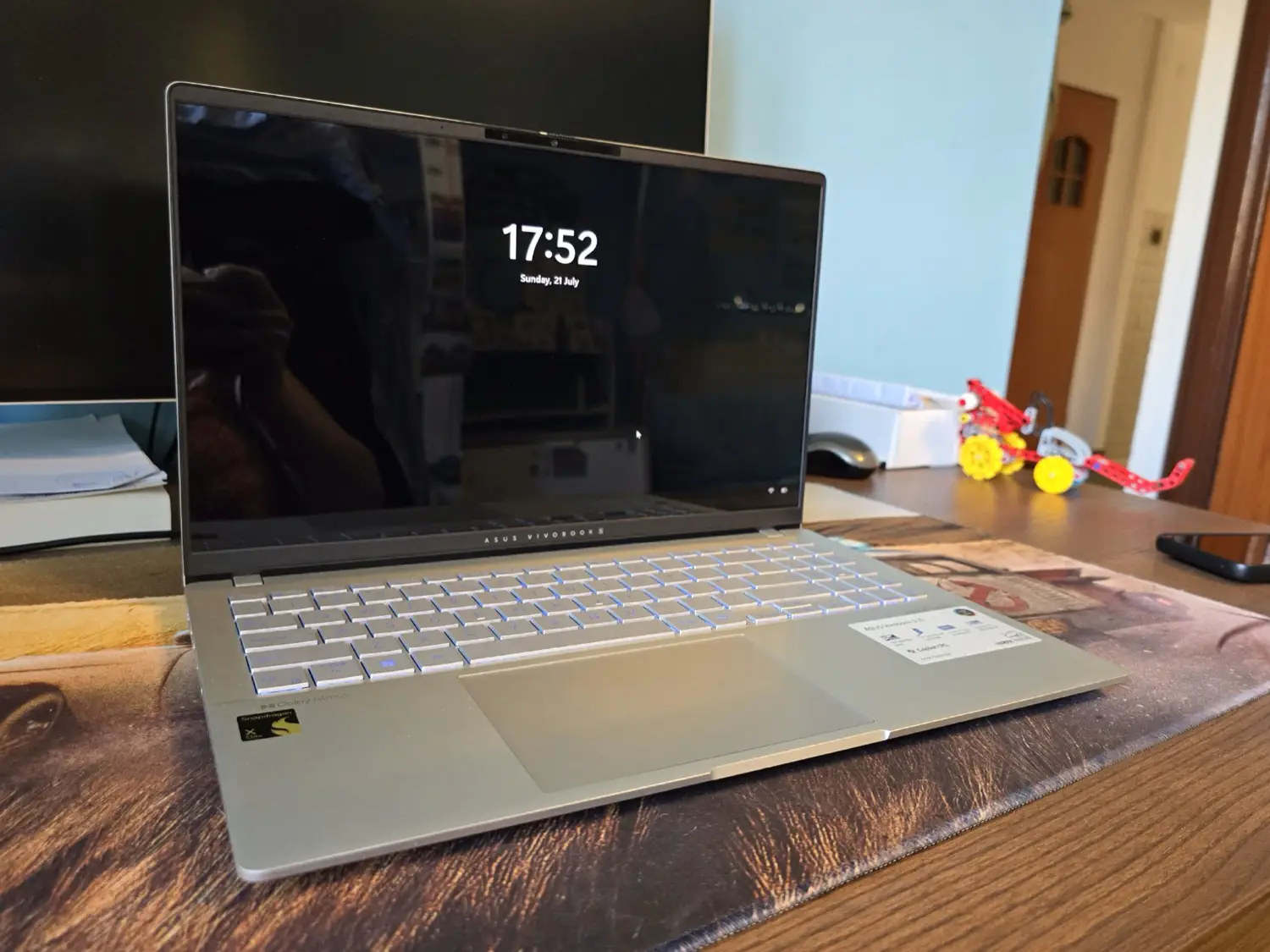
On the underside, you’ll find ventilation vents, two speakers, and polymer feet that lift the laptop off the desk surface.
The model is well-built, with MIL-STD 810H military-grade protection, and it’s very compact, thin, and lightweight, especially for a 15.6-inch laptop.
In one online store, I even came across a customer complaint questioning the specifications, saying that a 15.6-inch laptop couldn’t possibly be so thin (1.47 cm) and lightweight (1.42 kg). But it can, and the Vivobook S 15 is proof of that. It’s easy to take with you on trips, and in terms of dimensions, it’s a true record-holder—MacBooks seem bulky in comparison.
Read also: ASUS ROG Keris II Ace Wireless Gaming Mouse and ROG Moonstone Ace L Surface Review
Ports and connectors
For a slim ultrabook, it has everything you need: two USB 3.2 Gen 1 Type-A ports, two USB 3.2 Gen 1 Type-C ports with DisplayPort and Power Delivery support, an HDMI 2.1 TMDS port, a 3.5 mm headphone and microphone jack, and even more—a microSD slot.
ASUS Vivobook S 15 Display
The ASUS Vivobook S 15 features a 15.6-inch OLED display with a refresh rate of up to 120 Hz and a resolution of 2880×1620. Just the fact that it’s an OLED screen signifies top-notch quality. We’re accustomed to OLEDs in smartphones, even in budget models, but large OLED panels are costly and not commonly found in laptops. This type of display delivers vibrant and rich colors, excellent contrast, deep blacks, and wide viewing angles. Viewing content on the Vivobook S 15 is a pleasure. After experiencing this screen, I was reluctant to go back to my laptop with an IPS display.
The resolution is high for a 15.6-inch display, offering excellent detail. The 120 Hz refresh rate ensures smooth performance for the operating system and applications. While higher refresh rates above 60 Hz have long been standard in smartphones, they are just starting to become common in laptops.
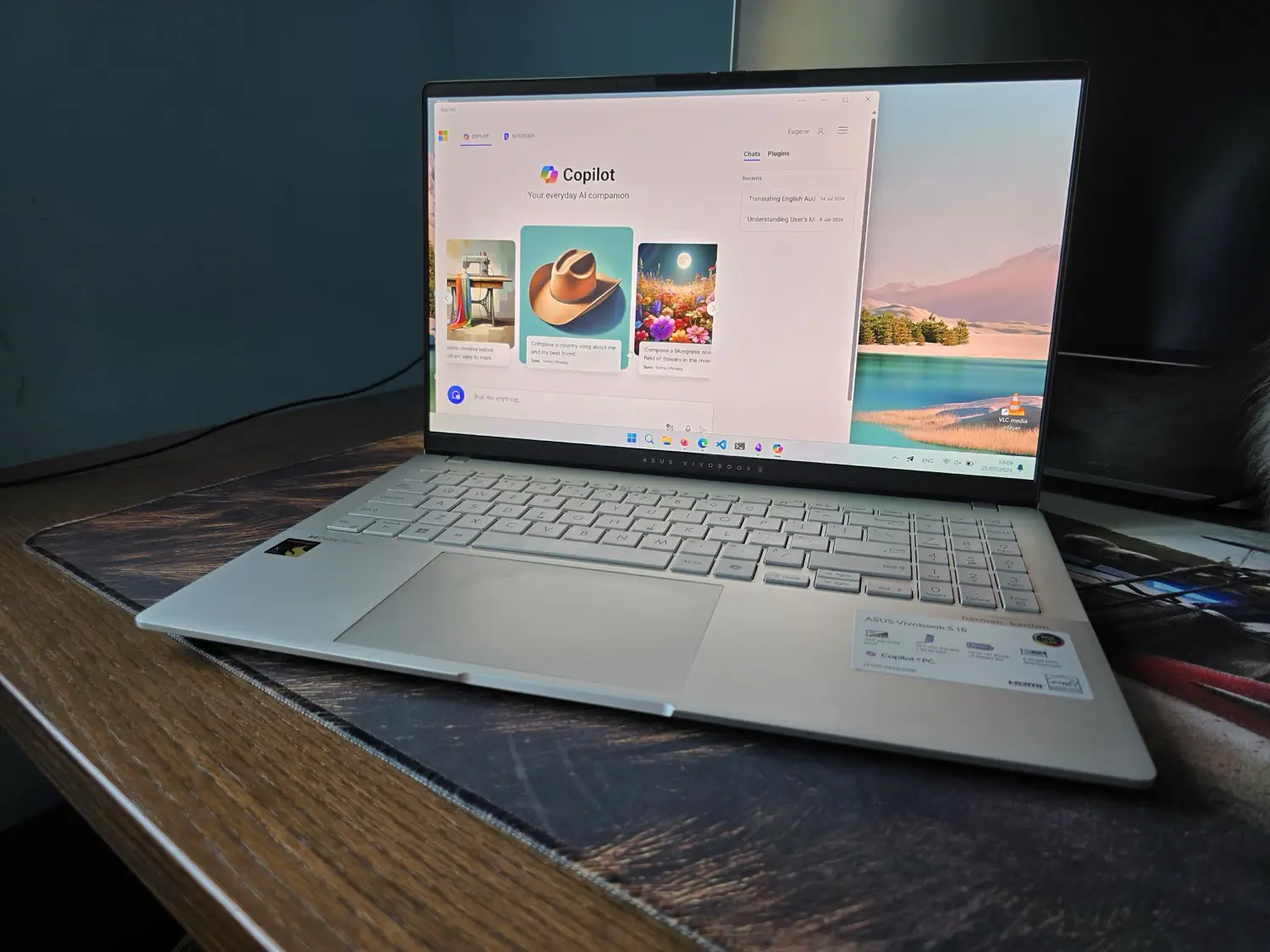 The screen isn’t touchscreen, which might be a downside for some, but to me, a laptop is a laptop, not a tablet.
The screen isn’t touchscreen, which might be a downside for some, but to me, a laptop is a laptop, not a tablet.
The maximum brightness is rated at 600 nits by the manufacturer, but since the screen is glossy, it reflects light noticeably. As a result, you might need to find a better spot to work in bright conditions.
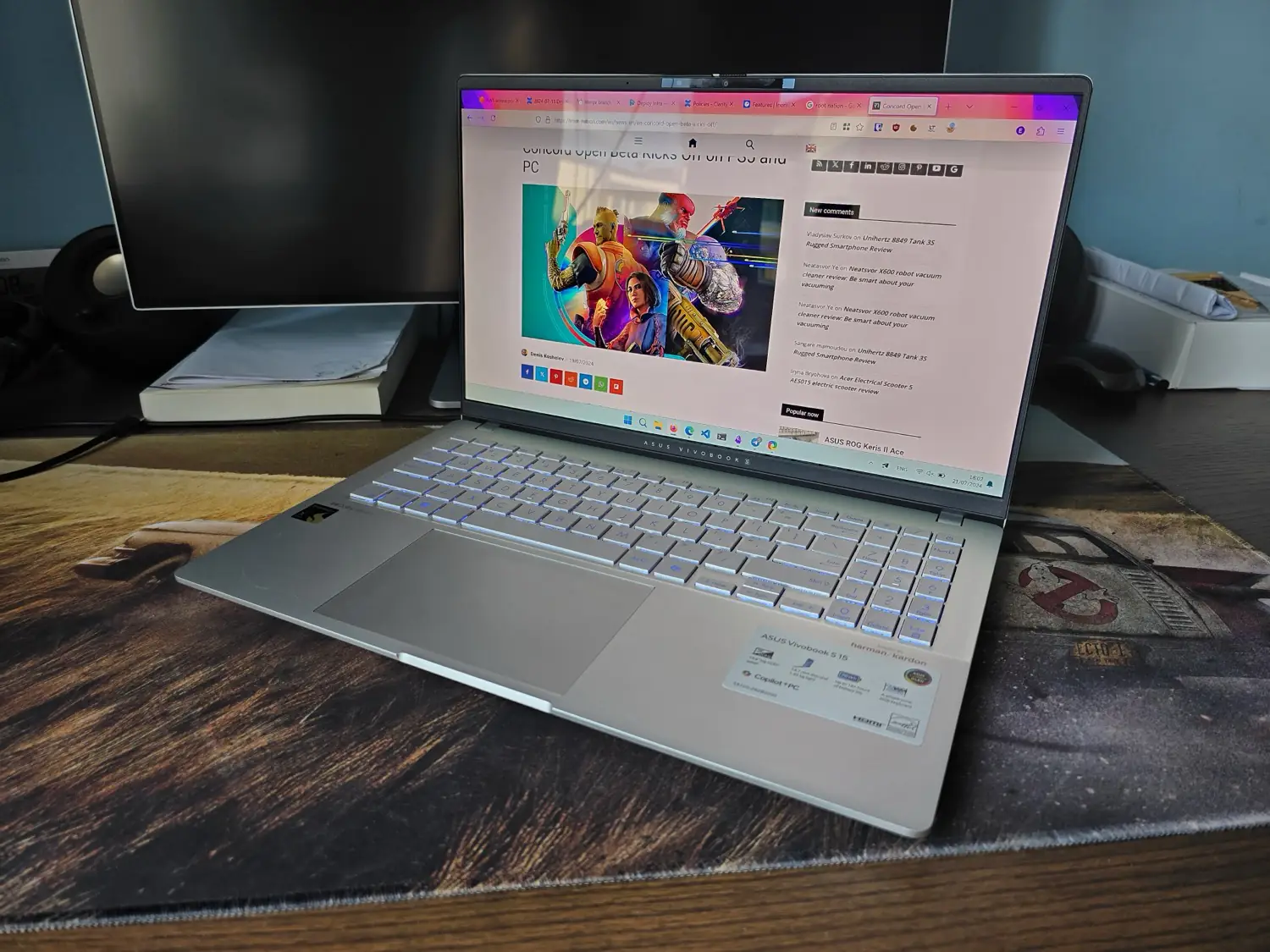 The PWM frequency is around 240 Hz at all brightness levels of the OLED panel. ASUS recommends not lowering the brightness below 50% and instead using the “flicker-free OLED dimming” software feature to reduce noticeable flicker (though I personally didn’t find it bothersome).
The PWM frequency is around 240 Hz at all brightness levels of the OLED panel. ASUS recommends not lowering the brightness below 50% and instead using the “flicker-free OLED dimming” software feature to reduce noticeable flicker (though I personally didn’t find it bothersome).
In the settings, you can also adjust the refresh rate (and enable automatic adjustment based on tasks), activate OLED burn-in protection, calibrate color accuracy, and more.
Overall, the screen is excellent, although the 16:9 aspect ratio is becoming less common. It would be nice to have more vertical space with such a diagonal.
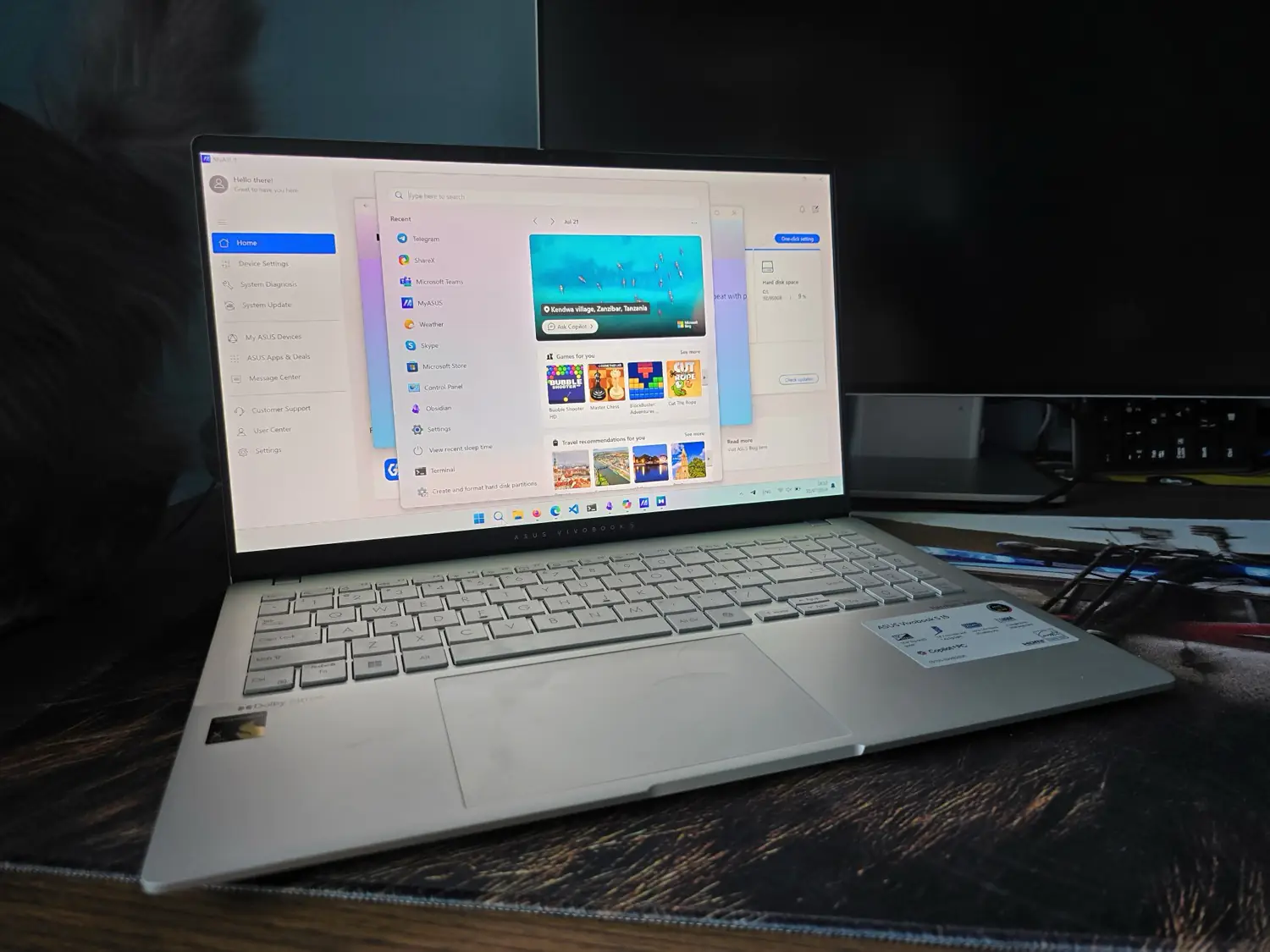
Read also: Report and Video from the ASUS Booth at #IFA2024 – All the New Releases
Keyboard and touchpad
The laptop comes with a full-sized keyboard, complete with a numeric keypad. The keyboard is silver with light-colored labels, which can make them harder to read in certain lighting conditions.
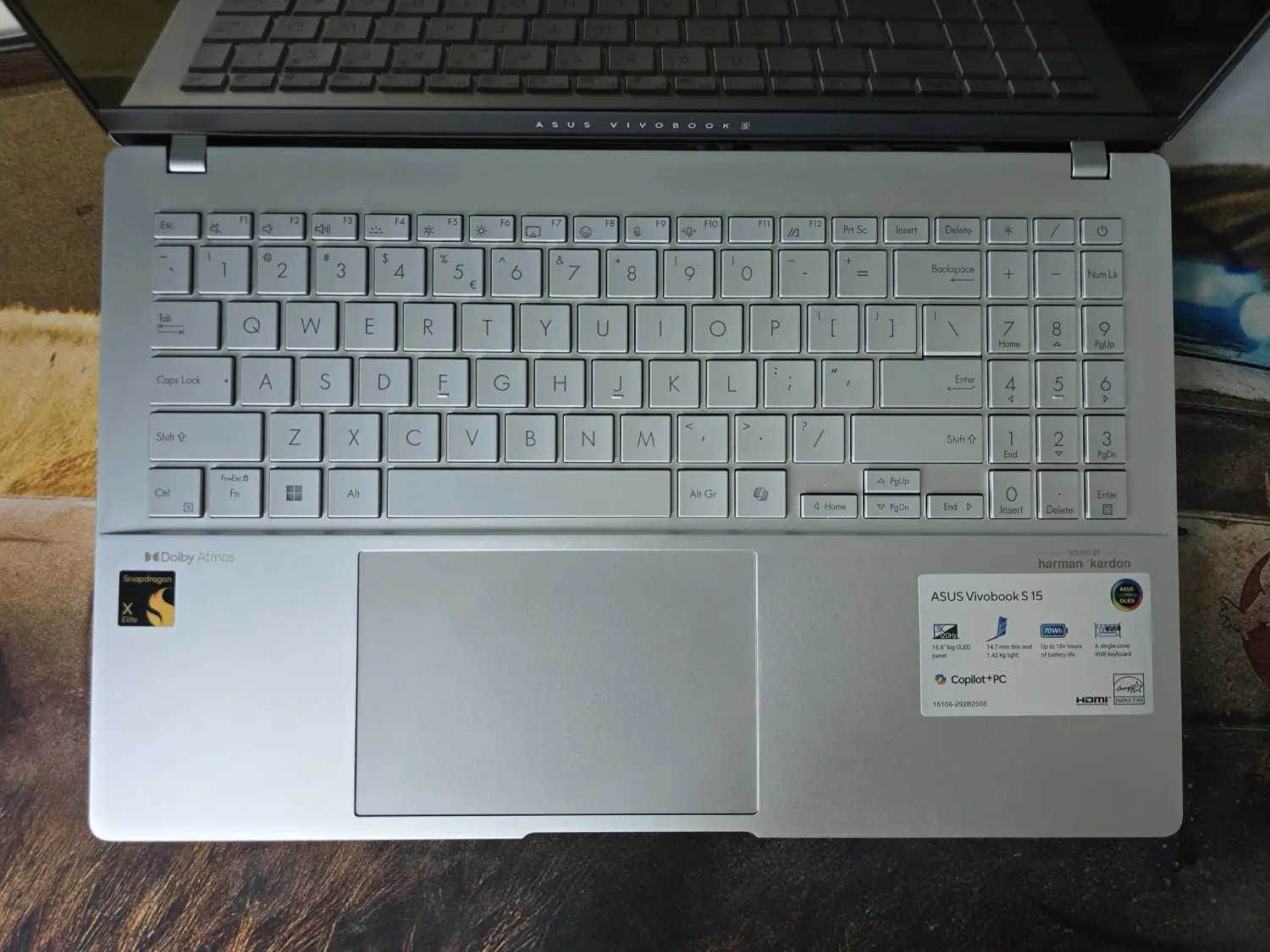
The key travel is comfortable, with a depth of 1.7 mm. All the keys are of a standard size, except perhaps the arrow keys, which are a bit smaller. There’s also a dedicated Copilot key, which has become quite common now—it opens the app where you can ask questions to Microsoft’s AI assistant.
In the top row of keys, there’s also an ASUS button that launches the proprietary MyAsus app, which we’ll discuss later.
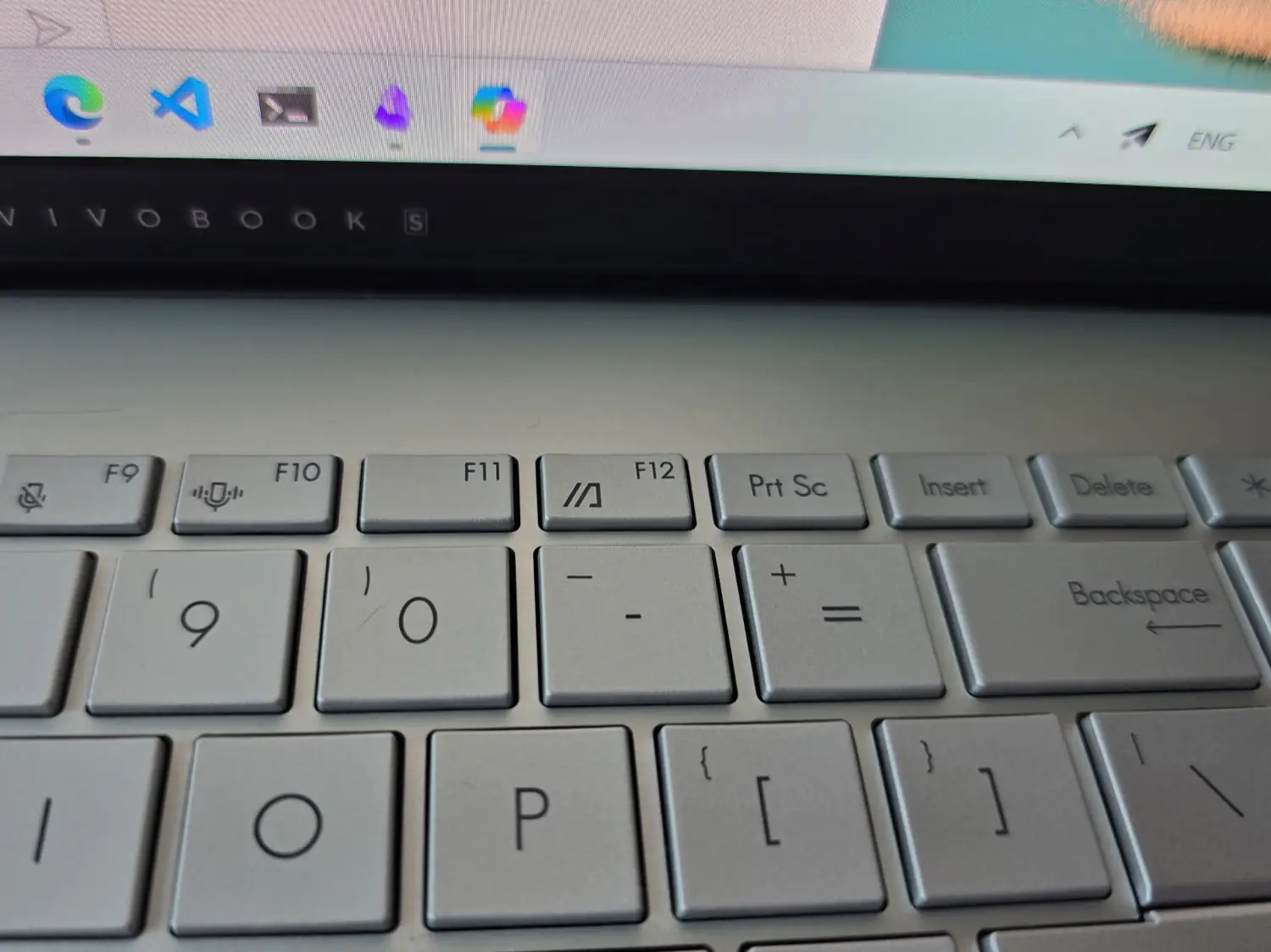 The keyboard features RGB backlighting, which can be customized through the MyAsus app. However, you can only choose one color for the entire keyboard at once, as there are no separate zones. Three levels of brightness are available, and the backlighting can turn on and off automatically thanks to the ambient light sensor.
The keyboard features RGB backlighting, which can be customized through the MyAsus app. However, you can only choose one color for the entire keyboard at once, as there are no separate zones. Three levels of brightness are available, and the backlighting can turn on and off automatically thanks to the ambient light sensor.
There are also lighting effects – “breathing”, blinking, and “shimmering”.

The touchpad is large – 13.0×8.5 cm, perfect for using gestures.
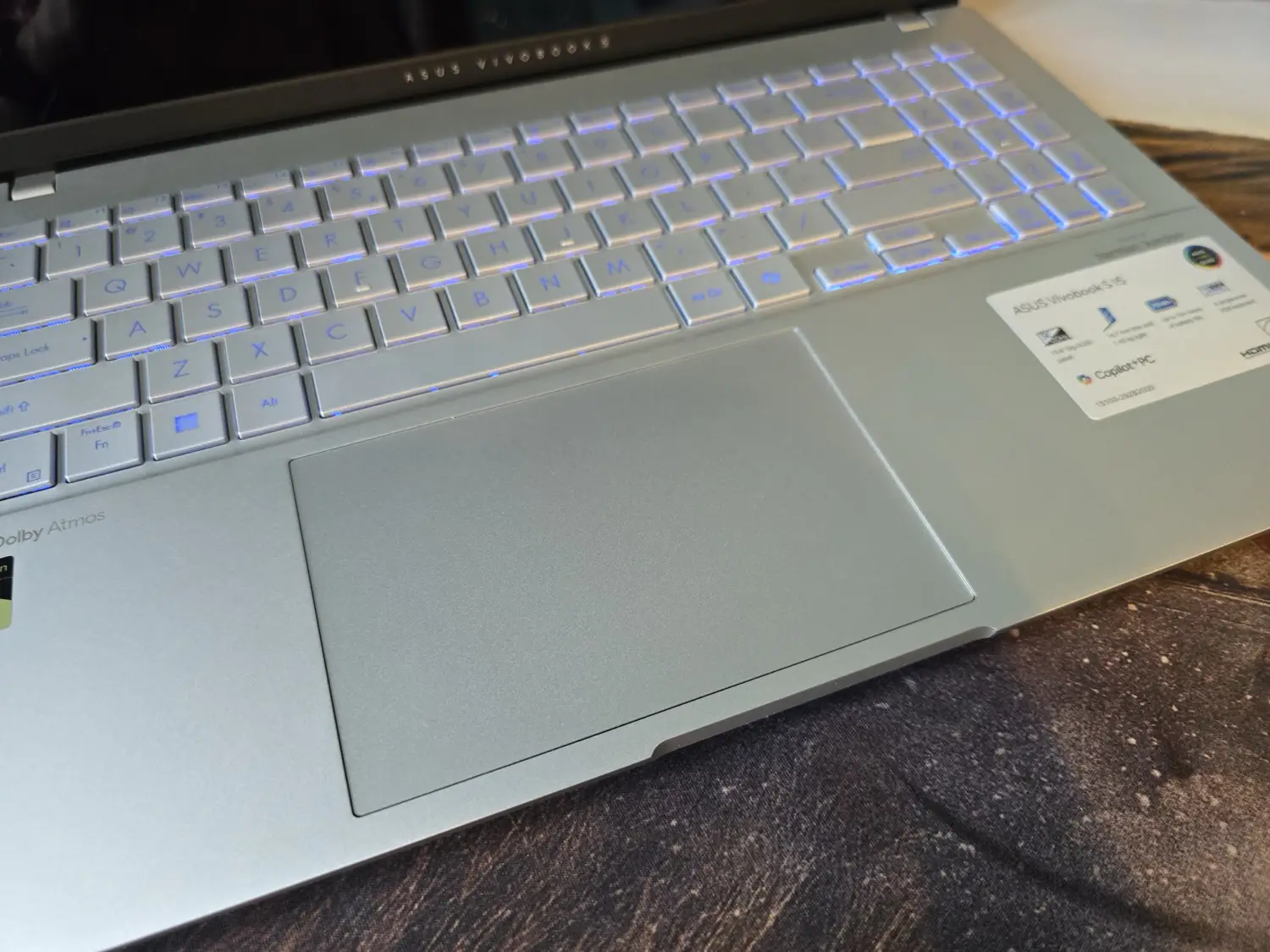
Gestures include both standard Windows ones and unique ones, like adjusting brightness or volume by swiping along the sides of the touchpad.
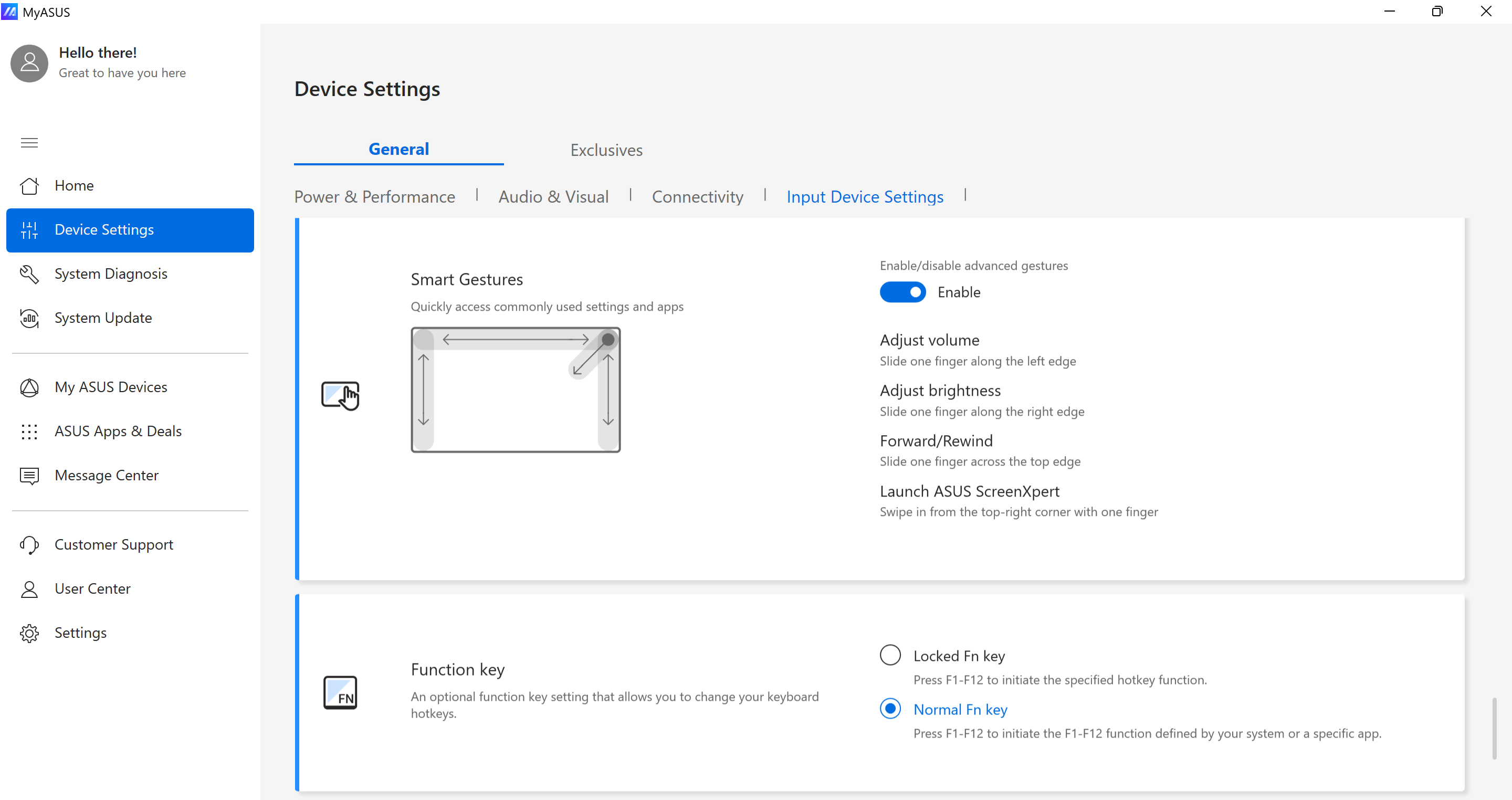
The touchpad sensitivity is decent. However, for a model in this price range, I would have preferred a haptic touchpad instead of a traditional one. The click is too loud, and the depth of the press didn’t appeal to me.
Hardware and performance
Let’s move on to the most exciting part. The ASUS Vivobook S 15 can be equipped with two types of Qualcomm processors — the Snapdragon X Elite and the slightly simplified Snapdragon X Plus. We tested the top configuration with the Snapdragon X Elite X1E-78-100. However, within the Snapdragon X Elite lineup, the X1E-78-100 is actually the entry-level variant. Still, it offers plenty of performance.
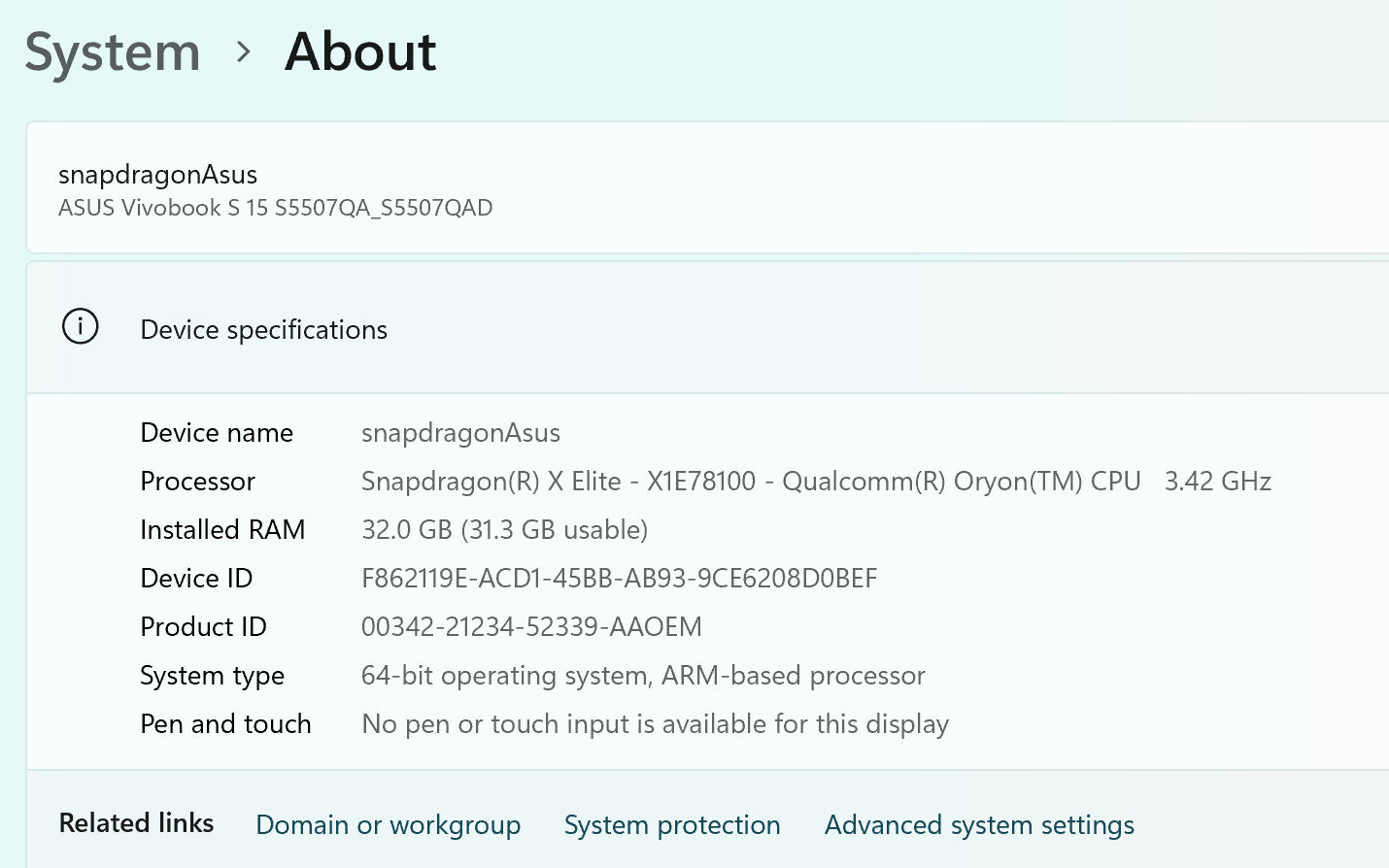 The chipset features 12 Oryon CPU cores (3 clusters of equal power; 12 threads) with a clock speed of up to 3.4 GHz, and it does not support turbo mode. Other key features include the integrated Adreno X1-85 iGPU, the Hexagon NPU (45 TOPS) for neural processing, and a fast LPDDR5x-8448 memory controller.
The chipset features 12 Oryon CPU cores (3 clusters of equal power; 12 threads) with a clock speed of up to 3.4 GHz, and it does not support turbo mode. Other key features include the integrated Adreno X1-85 iGPU, the Hexagon NPU (45 TOPS) for neural processing, and a fast LPDDR5x-8448 memory controller.
According to tests, the Snapdragon X Elite X1E-78-100 delivers performance comparable to the AMD Ryzen 7 7840U and Apple M3. While it’s not revolutionary, it should be sufficient for most users to run any applications for the next few years.
The 3.8 TFLOPS Adreno X1-85 GPU supports DirectX 12, but does not support DirectX 12 Ultimate, despite supporting VRS and ray tracing. The video chip allows you to use up to 3 UHD 2160p monitors simultaneously. It’s definitely not designed for demanding games, but you can still play on this laptop with good parameters, which I’ll talk about later.
The amount of RAM in our version is 32 GB, LPDDR5X type. The drive is a 1 TB PCIe NVMe 4.0 SSD. The modules are very fast.
The SSD is the only component in the ASUS Vivobook S 15 S5507 that can be upgraded. To access it, you’ll need to remove the back panel, which is secured with a pair of Torx screws. The screws are different sizes, so make sure to reinsert them in the correct order.
In everyday use, the laptop is incredibly fast—no delays, applications open instantly, and the Vivobook S 15 wakes up immediately when you open the lid. This performance is consistent whether it’s running on battery power or plugged in. Of course, I ran all possible benchmarks to test its performance, but keep in mind that most benchmarking applications are optimized for x86 architecture processors, so comparisons should be made with caution. In any case, the results are impressive; for example, Geekbench and Cinebench produced excellent scores, even surpassing those of MacBooks with M3 processors.
I installed a range of resource-intensive 3D games, including Metro Exodus, PUBG, Asphalt Legends, and Genshin Impact. While many of these games are also available for smartphones, it’s no surprise that they run on the laptop with excellent graphics and without any issues:
- Metro Exodus: I had my doubts, the game slowed down at the first setting, but then went without problems with an average level of graphics
- Witcher 3 on 1920×1080 with Ultra graphics gave no more than 17 fps, if you lower the graphics, then about 40 fps is not a problem
- GTA 3 on Full HD and maximum settings produced an average of 22 fps or more when the graphics level was lowered
- Dota 2 sometimes reached 60 fps, on average – 50-55.
Not all games and benchmark applications were compatible with ARM, and some that did install were not optimized for this processor and run through emulation, which naturally affects graphics performance. However, there’s plenty of potential ahead as the platform and its software continue to develop.
I should add that the Qualcomm chip supports Automatic Super Resolution. It uses AI to enhance game resolution, meaning you can technically choose a lower resolution without losing graphical quality.
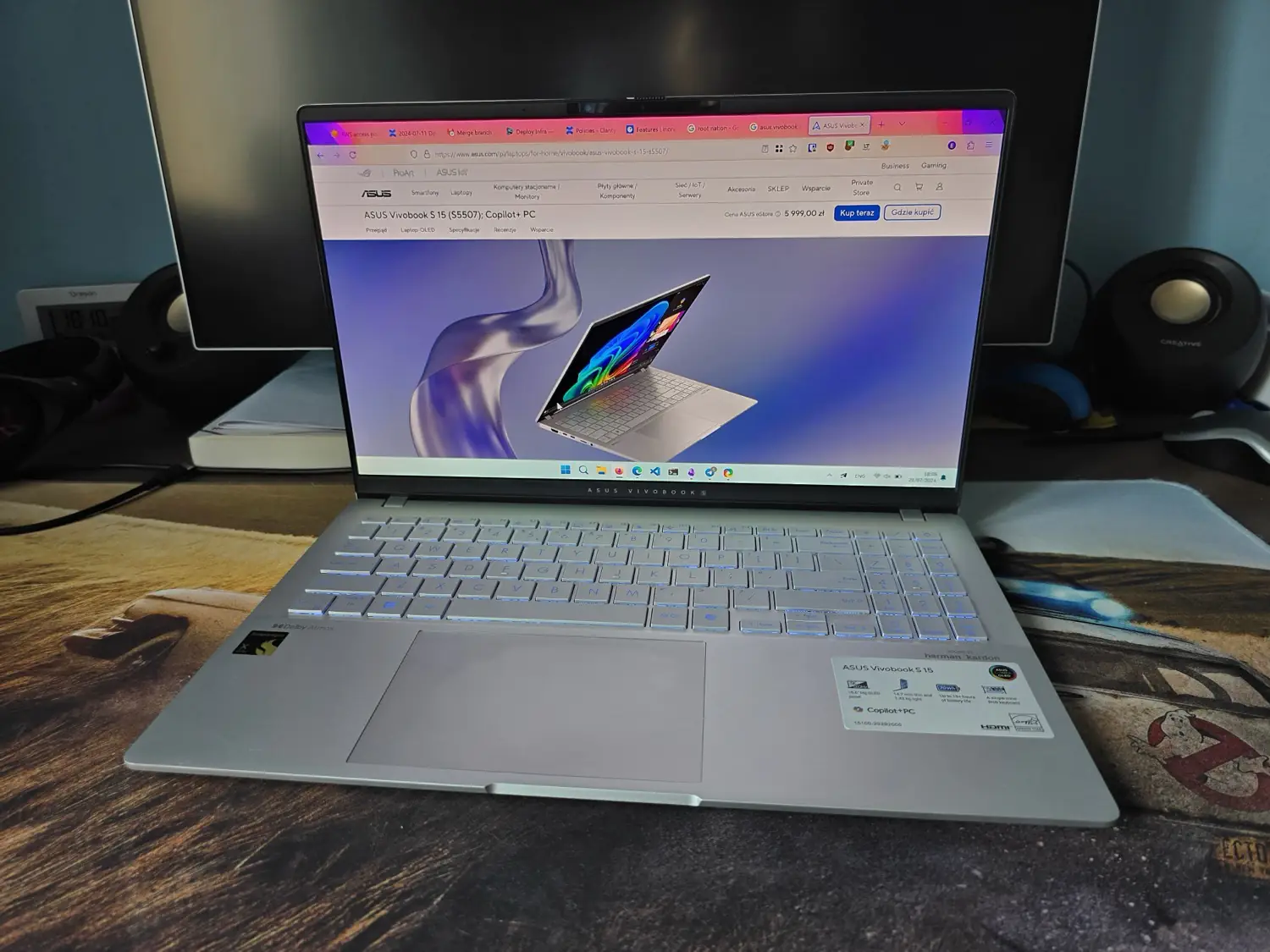 The main advantage of Apple laptops and other ARM-based devices has always been their ability to deliver high performance without overheating. For instance, MacBook Air models don’t even have fans—they don’t need them. The ASUS Vivobook S 15 S5507, however, does have fans, which theoretically allows it to achieve higher performance compared to models with passive cooling systems. During testing, the Vivobook S 15 only activated the fans rarely and only under significant load, such as stress tests, video rendering, or installing/updating a large amount of software simultaneously. It did get warm but not excessively so. Various fan modes are available, which I’ll cover in more detail below.
The main advantage of Apple laptops and other ARM-based devices has always been their ability to deliver high performance without overheating. For instance, MacBook Air models don’t even have fans—they don’t need them. The ASUS Vivobook S 15 S5507, however, does have fans, which theoretically allows it to achieve higher performance compared to models with passive cooling systems. During testing, the Vivobook S 15 only activated the fans rarely and only under significant load, such as stress tests, video rendering, or installing/updating a large amount of software simultaneously. It did get warm but not excessively so. Various fan modes are available, which I’ll cover in more detail below.
Read also: ASUS Vivobook S 16 OLED (S5606M) Review: Excellent Mid-Range Laptop
Software, compatibility
The test laptop runs on Windows 11 Home, specifically designed for ARM 64-bit architecture.
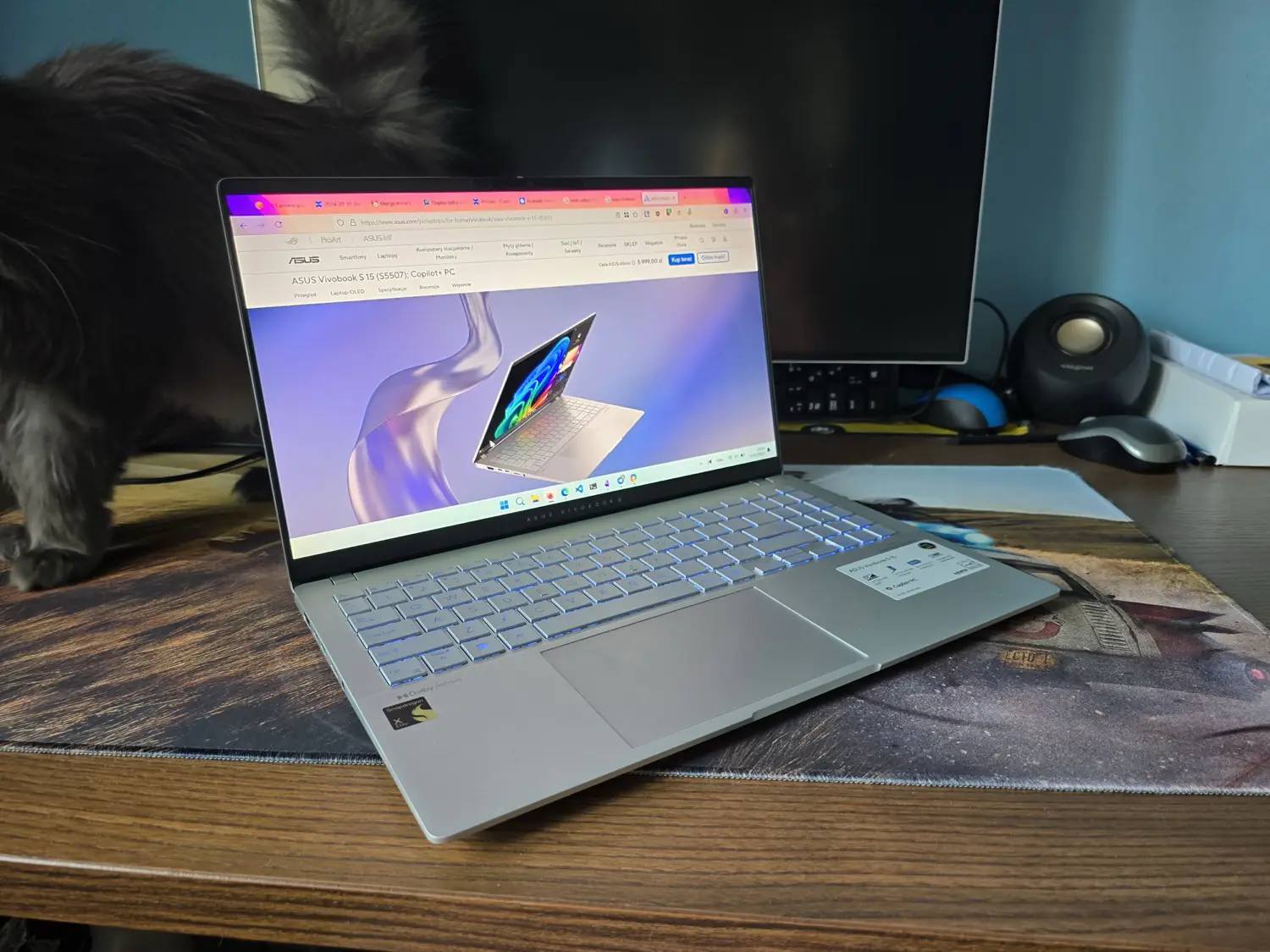
Proprietary software and profile settings
The Vivobook S 15 comes with the standard MyAsus application, which allows you to manage power profiles, battery settings, screen configurations, and more.
Performance profiles are available:
- Full speed – allows the model to operate at a constant power of about 50 W, processor frequency up to 3.4 GHz, while the fans are overclocked to ~46 dB
- Performance – power up to 45 W, frequency up to 3 GHz, noise up to ~42 dB
- Balanced/Standard – up to 35 W under continuous load, up to 2.7 GHz, up to ~35 dB
- Whisper – limit up to 20 W, up to 2.2 GHz, fan noise level below 30 dB
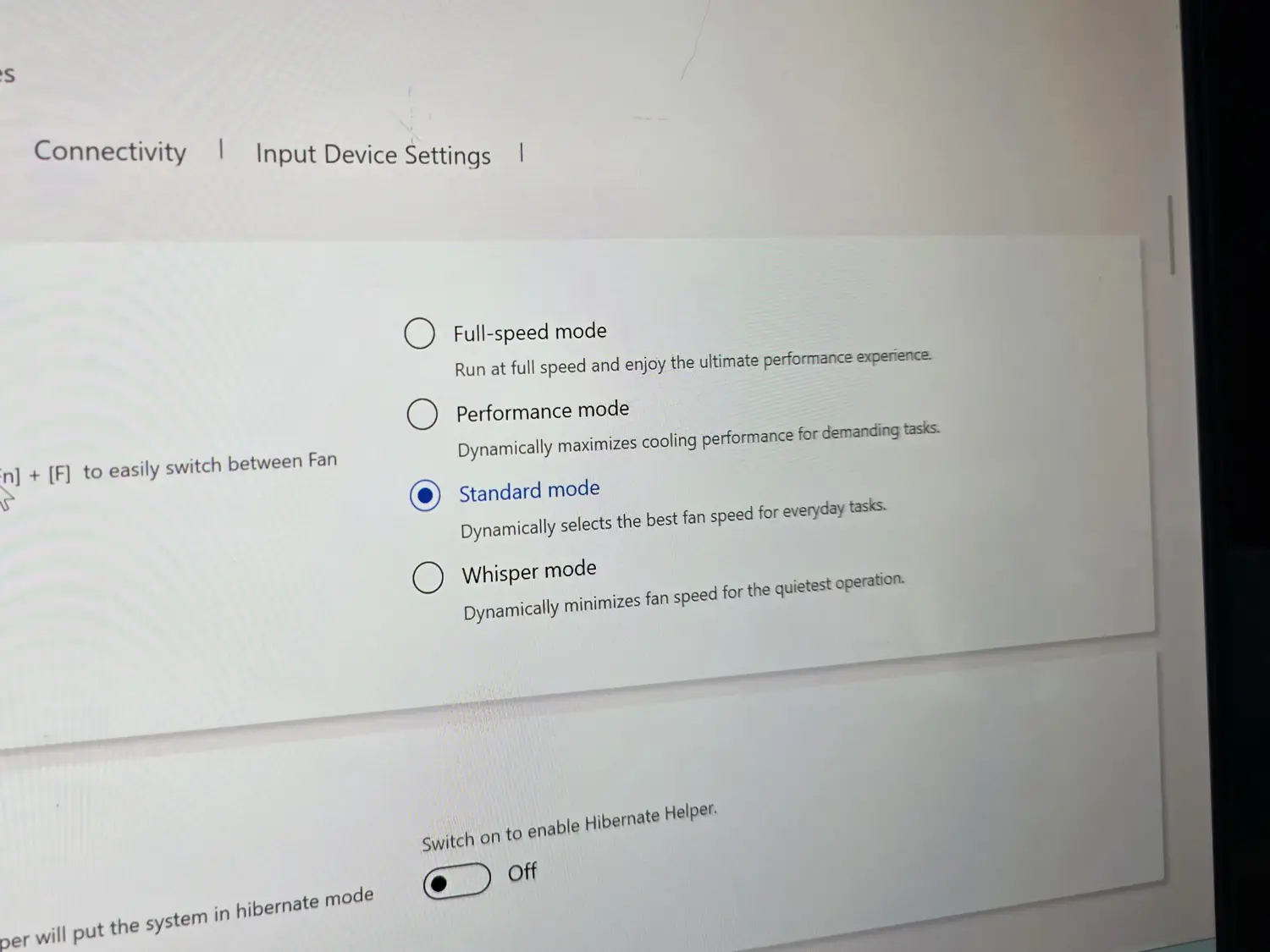 I would recommend using the laptop in standard mode for most situations, although the “Whisper” mode also works well for everyday use without any stuttering or lag. However, it all depends on the software you are using. For example, here’s the noise level under high load in Full Speed mode:
I would recommend using the laptop in standard mode for most situations, although the “Whisper” mode also works well for everyday use without any stuttering or lag. However, it all depends on the software you are using. For example, here’s the noise level under high load in Full Speed mode:

And what about the professionals?
I also asked my husband, who works as a programmer, to set up the laptop for himself and use it for a while to share his impressions. Personally, I didn’t encounter any issues with ARM, as I work with text, documents, and basic photo editing. But what about the specialists?
The initial setup of the ASUS Vivobook S 15 S5507 was quiet and didn’t overheat, which sets it apart from laptops with Intel and AMD processors that often start their fans like jet engines on takeoff. Overall, I had no complaints about the initial setup; the only issue was that installing updates required manual intervention, as some components, including Snapdragon drivers, didn’t install automatically through Windows Update.
Not all the programs installed on the laptop were adapted for ARM architecture. Among them were ASUS utilities and drivers. For example, the utility for updating the Edge browser, although the browser itself is ARM-based. Additionally, the MS Office 365 Personal package from the Microsoft site was installed, but only four applications were available for ARM: Word, Excel, PowerPoint, and Publisher. The main application needed daily, Outlook for ARM, is still not adapted. It would have been nice if they had made more effort. According to support forums, Outlook for ARM can be installed, but only if you install a beta version of Windows and switch it to testing mode. We didn’t want to go through that with a test laptop.
By the way, a native version of Thunderbird for Windows on ARM is also in development, but it’s reported that the x86 version should work without issues.
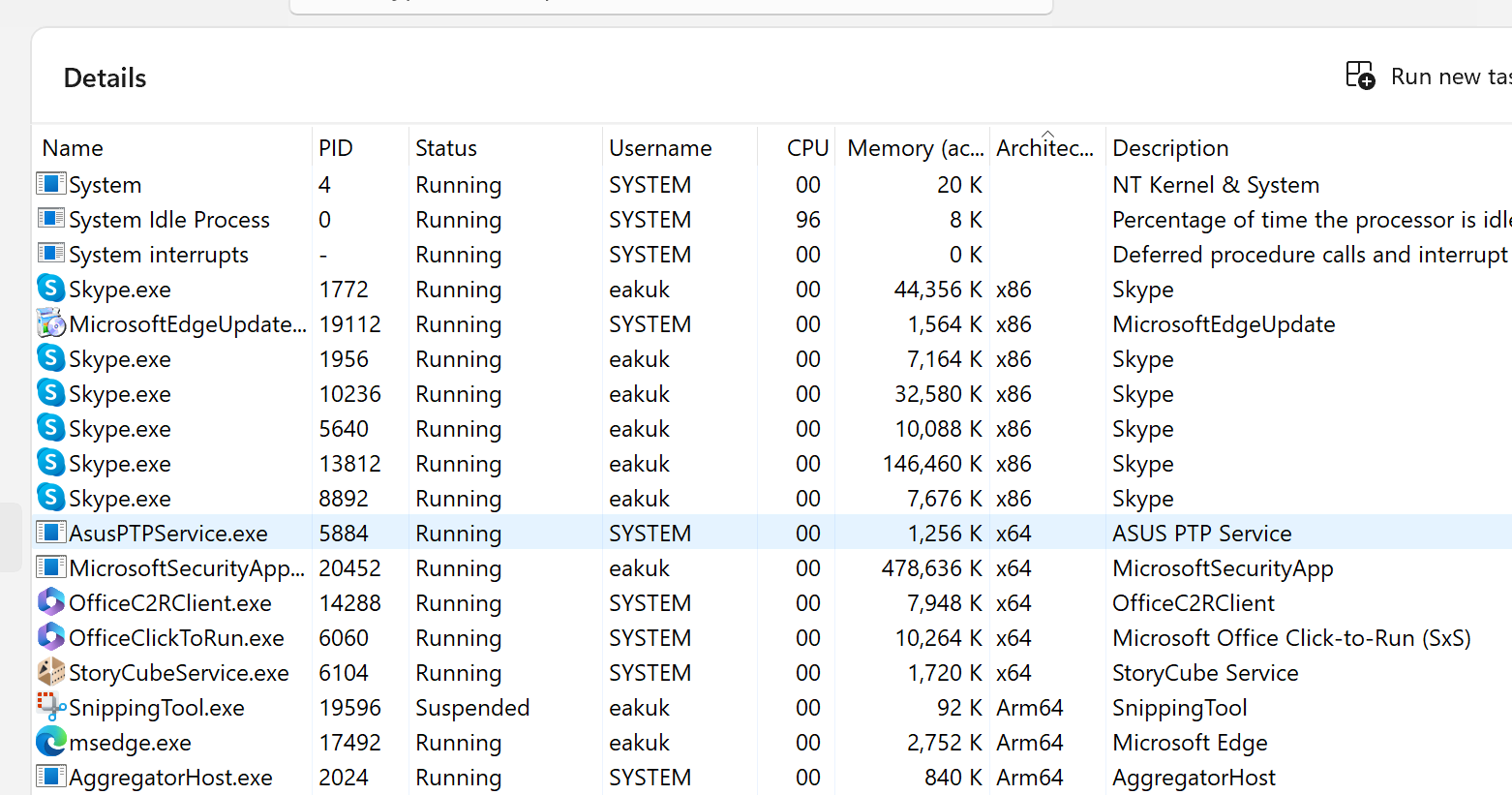
My husband gave me a list of software he frequently uses. Among third-party software adapted for ARM are Firefox, VS Code, and Obsidian. From Microsoft, the ARM-compatible software includes Terminal, WSL (Windows Subsystem for Linux), OneNote, and Teams.
Since he used the laptop for software development, he noted that the combination of VS Code and Windows Subsystem for Linux works exceptionally well. WSL itself proved to be quite smart—when you install Linux from the MS Store, it automatically downloads the required ARM64 version.
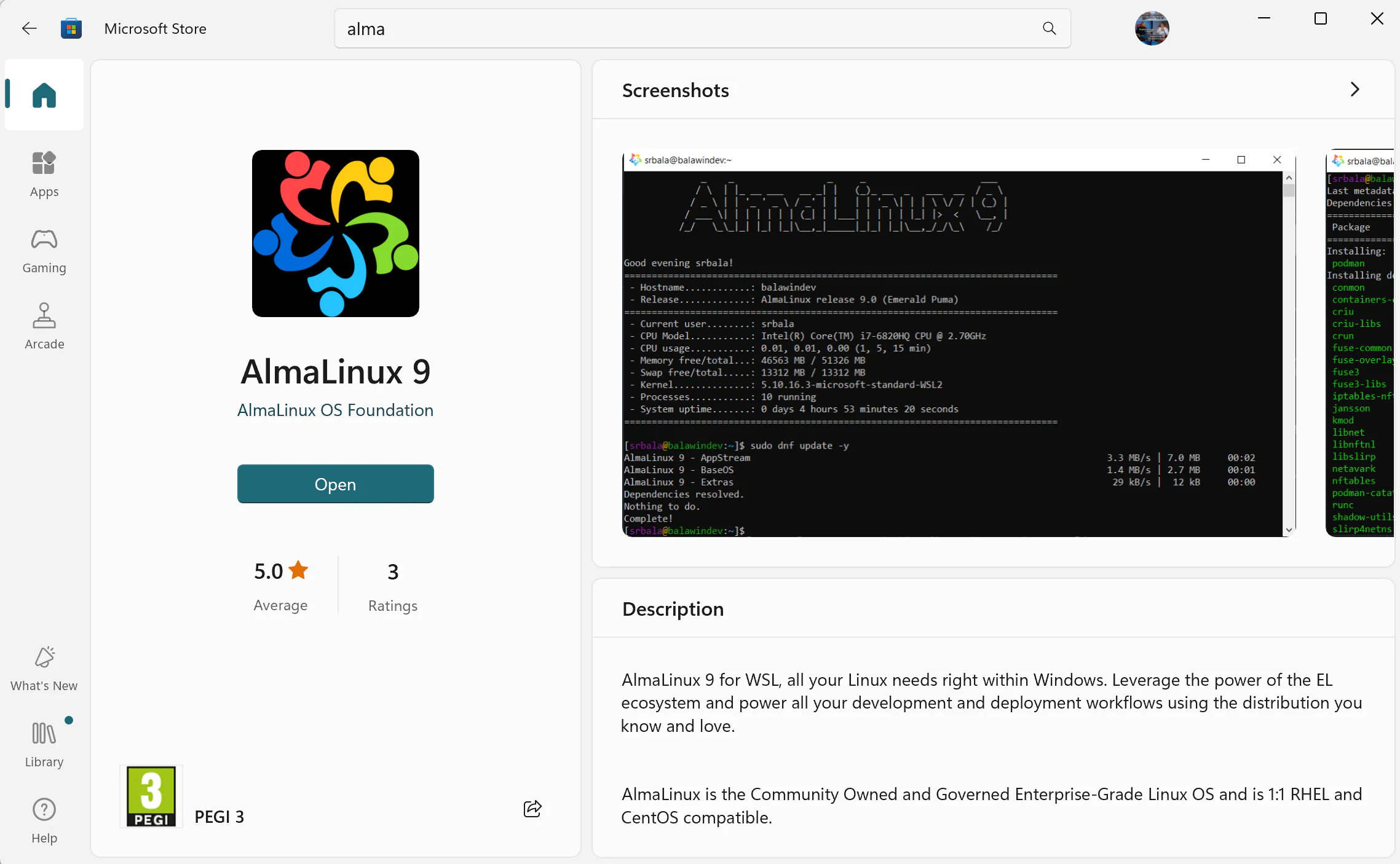
It gets easier from here, as ARM64 support within Linux is quite good. Many servers have been running on this architecture for years, and all the necessary development tools are available, including Docker.
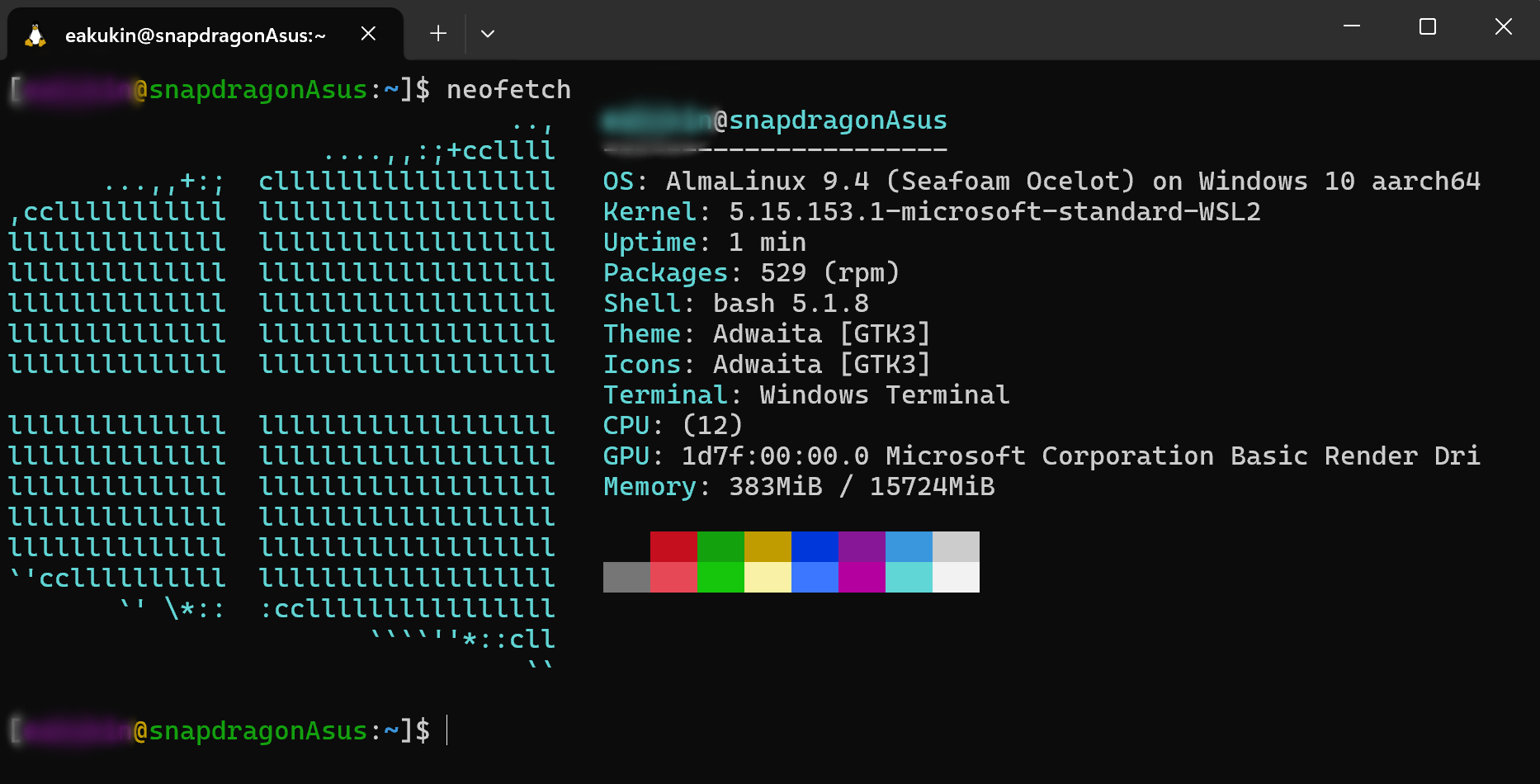
How do applications designed for x64 and x86 architectures run on an ARM processor? There are no issues. For example, Skype and Telegram are emulated, but there are no problems with them, including during calls and video.
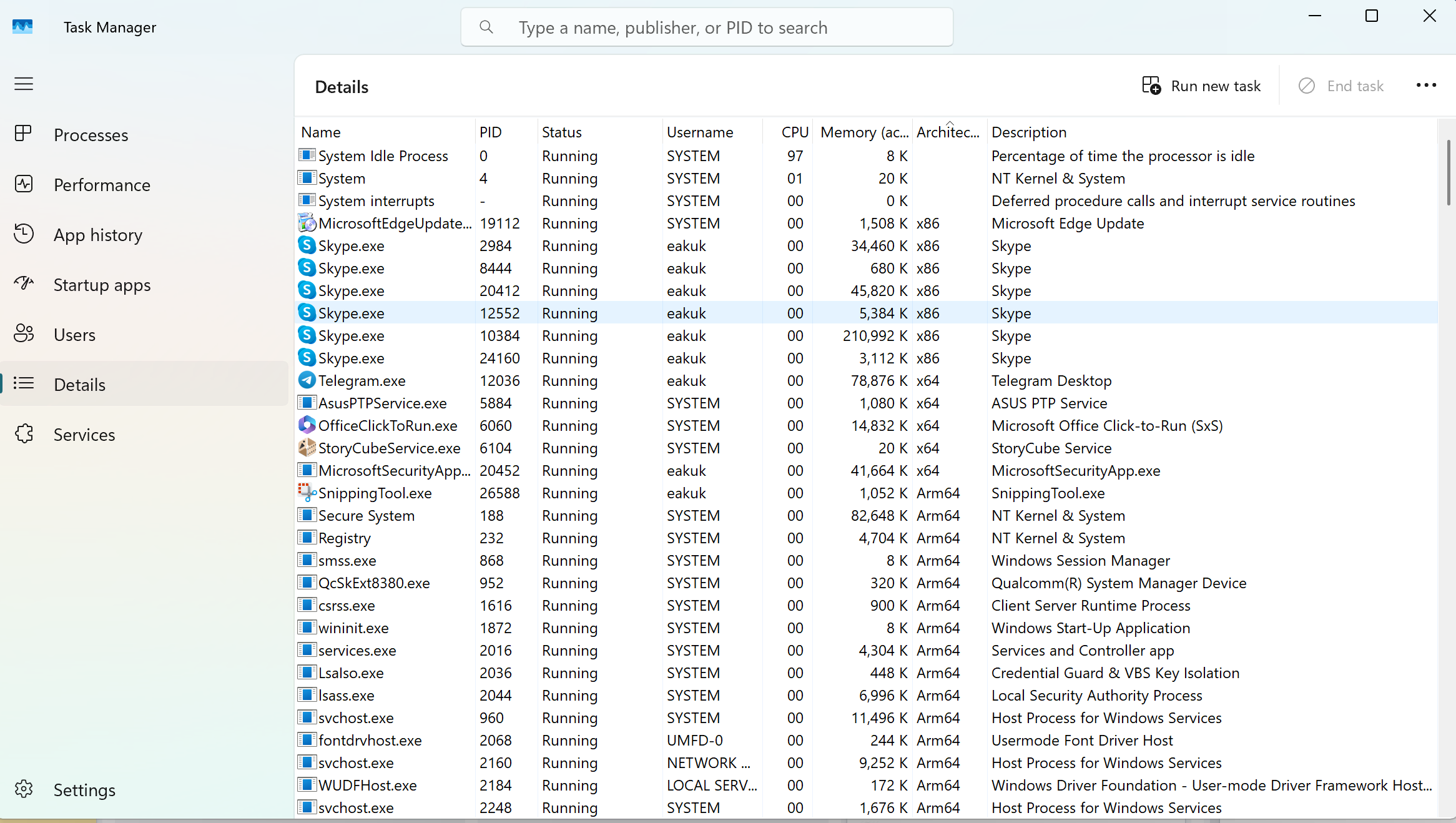
Overall, my husband wasn’t 100% satisfied, but he said the laptop would work for his needs. On the other hand, a friend of mine who is a photo and video specialist, and also works as a sound engineer on the side, claimed that an ARM laptop is not suitable for him because much of the software he needs is not available for ARM. However, I think these are individual cases. Most programs needed by a typical user work perfectly. And the laptop doesn’t make noise or overheat.
Additionally, the Vivobook S 15 handles connecting an external monitor via USB-C successfully, though there were minor issues with resolution after waking from sleep—it defaulted to a standard 1024×768 setting and appeared blurry. This was resolved by reconnecting the cable.
Read also: ASUS Zenbook 14 OLED (UX3405M) Review: 120 Hz Display and Intel Core Ultra 9
AI features of ASUS Vivobook S 15 S5507
With the lineup of laptops based on Snapdragon X chipsets, Windows introduces a new system architecture that integrates the CPU, GPU, and NPU, enhanced by large and small language models (LLMs and SLMs). This allows the PC Copilot+ to achieve a level of performance previously unattainable—it is 20 times more powerful and 100 times more efficient in handling AI-related tasks.
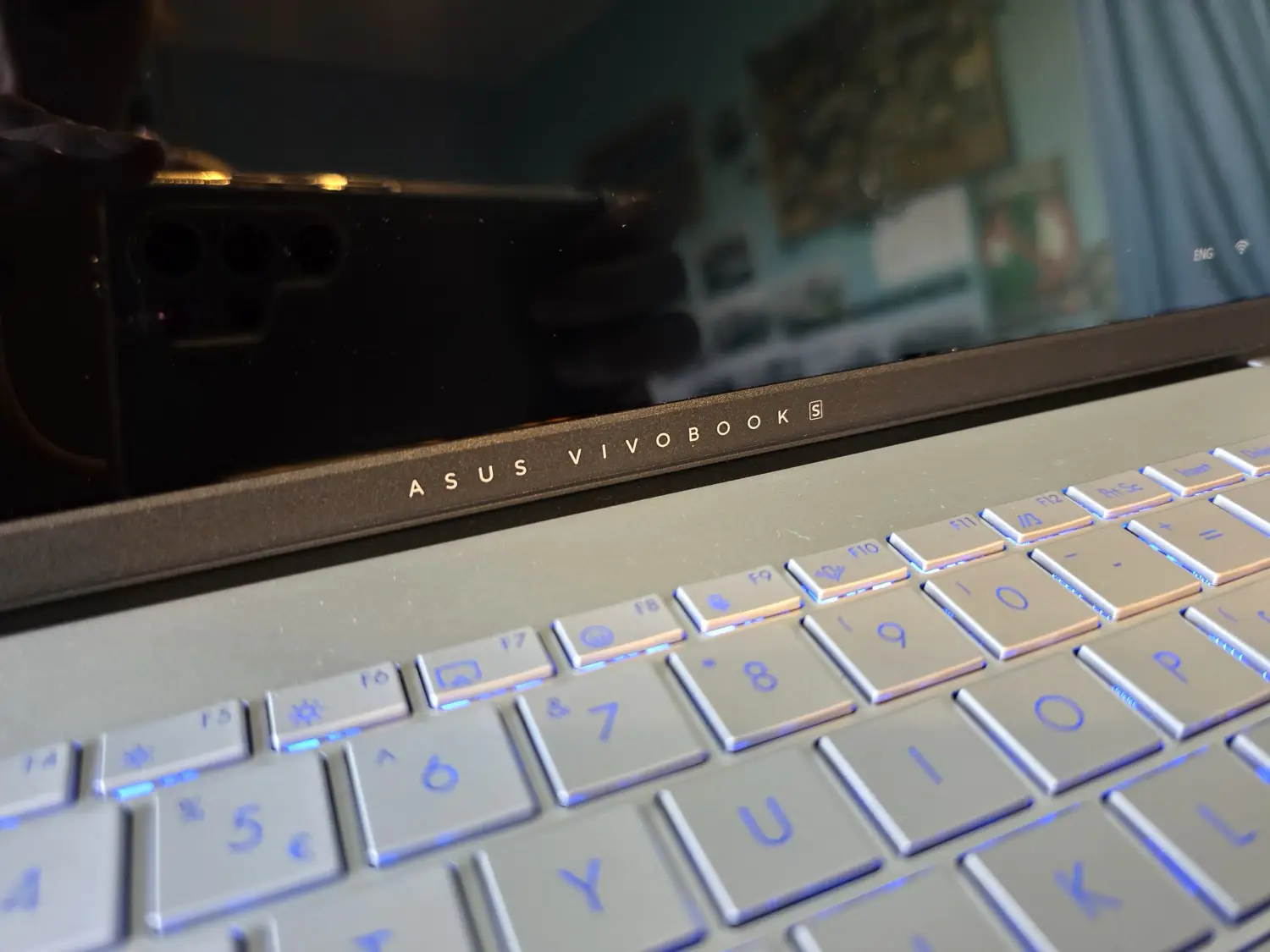
Here are the key features of Copilot+:
- Recall: This feature allows you to easily find and remember information on your PC. For example, you can quickly locate documents, photos, or other files by asking Copilot and describing them in general terms. The only issue is that Recall, which has been heavily advertised in Europe, is currently unavailable there, and its future availability remains uncertain due to EU data protection laws.
- Cocreator: This feature enables real-time image creation and editing in Paint using AI.
- Image generation in Photos. You describe your dream photo, such as a travel photo, and it comes to life! Although there may be some limitations to the prompts
- Live Captions: This feature allows you to translate audio from over 40 languages into English in real time. It works, though not perfectly
- Smart Compose: Copilot+ PCs can offer intelligent suggestions as you write, which helps speed up the process of creating documents and messages
- Task Automation: Use AI to automate routine tasks such as email sorting, meeting scheduling, and file management
- Enhanced Security: Copilot+ PCs come with enhanced security features that protect your data and sensitive information.
Copilot+ PCs come with pre-installed programs that leverage the power of AI to improve productivity. Among them:
- Copilot Office: Integration with Microsoft Office that allows you to use AI to create and edit documents, presentations, and spreadsheets
- Copilot Studio: An app for creative tasks, such as video editing and graphic design, that uses AI to speed up the process
- Copilot Assistant: A virtual assistant that helps you manage tasks, reminders, and schedules.
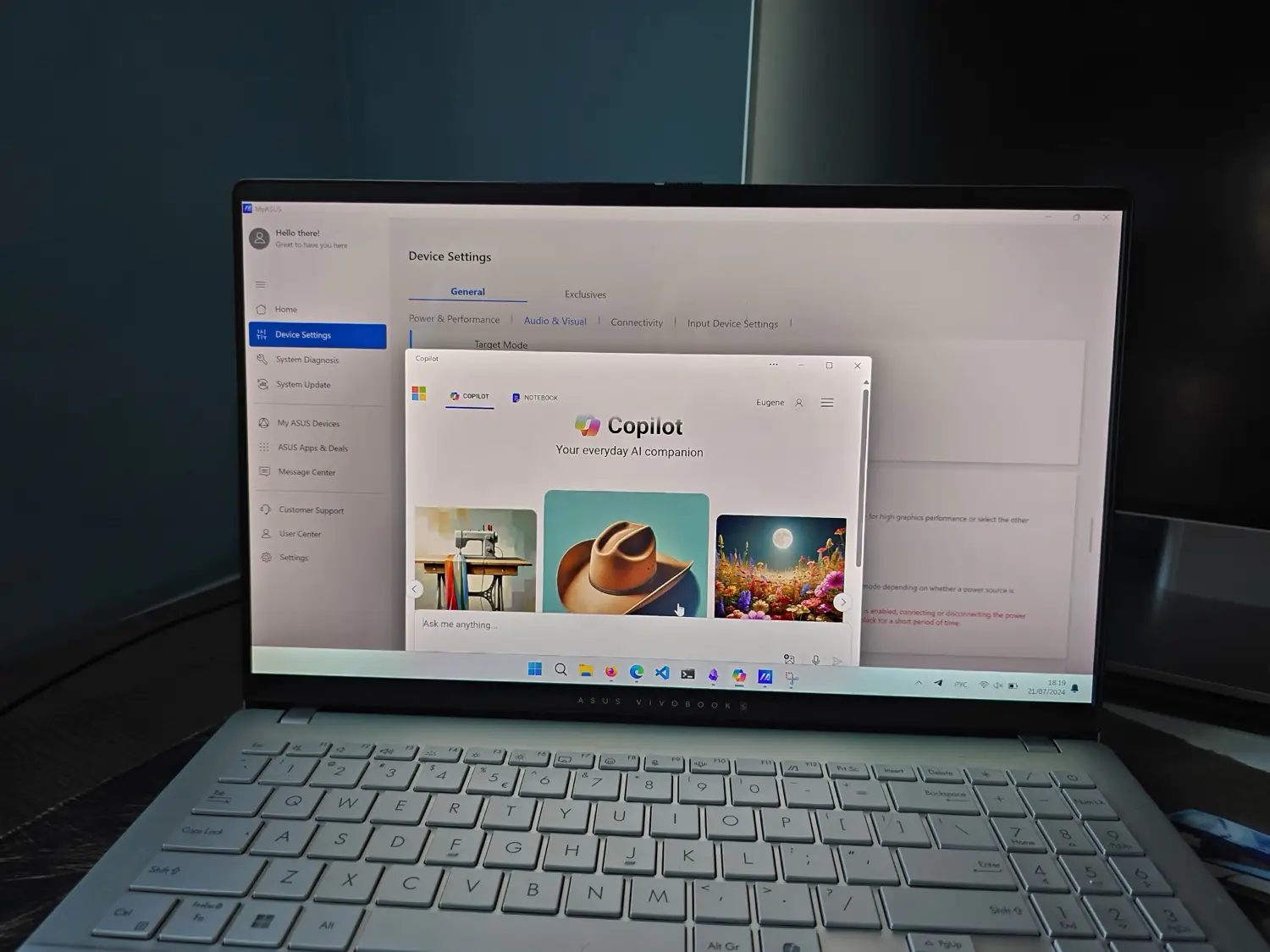
Windows also collaborates with Adobe, DaVinci Resolve, CapCut, and others to optimize AI functions in applications like Photoshop, Lightroom, and djay Pro, which are accelerated by the neural processor.
The AI features of Studio Effects, such as studio lighting, background replacement during video calls, eye contact effects, and skin smoothing, are already familiar to us. Now, additional features are supported, including the live captions mentioned above.
Additionally, ASUS offers its own AI features, such as AiSense for enhancing video call quality in low light, StoryCube for organizing media files, and advanced face recognition (the screen dims when you’re not looking at it to save energy).
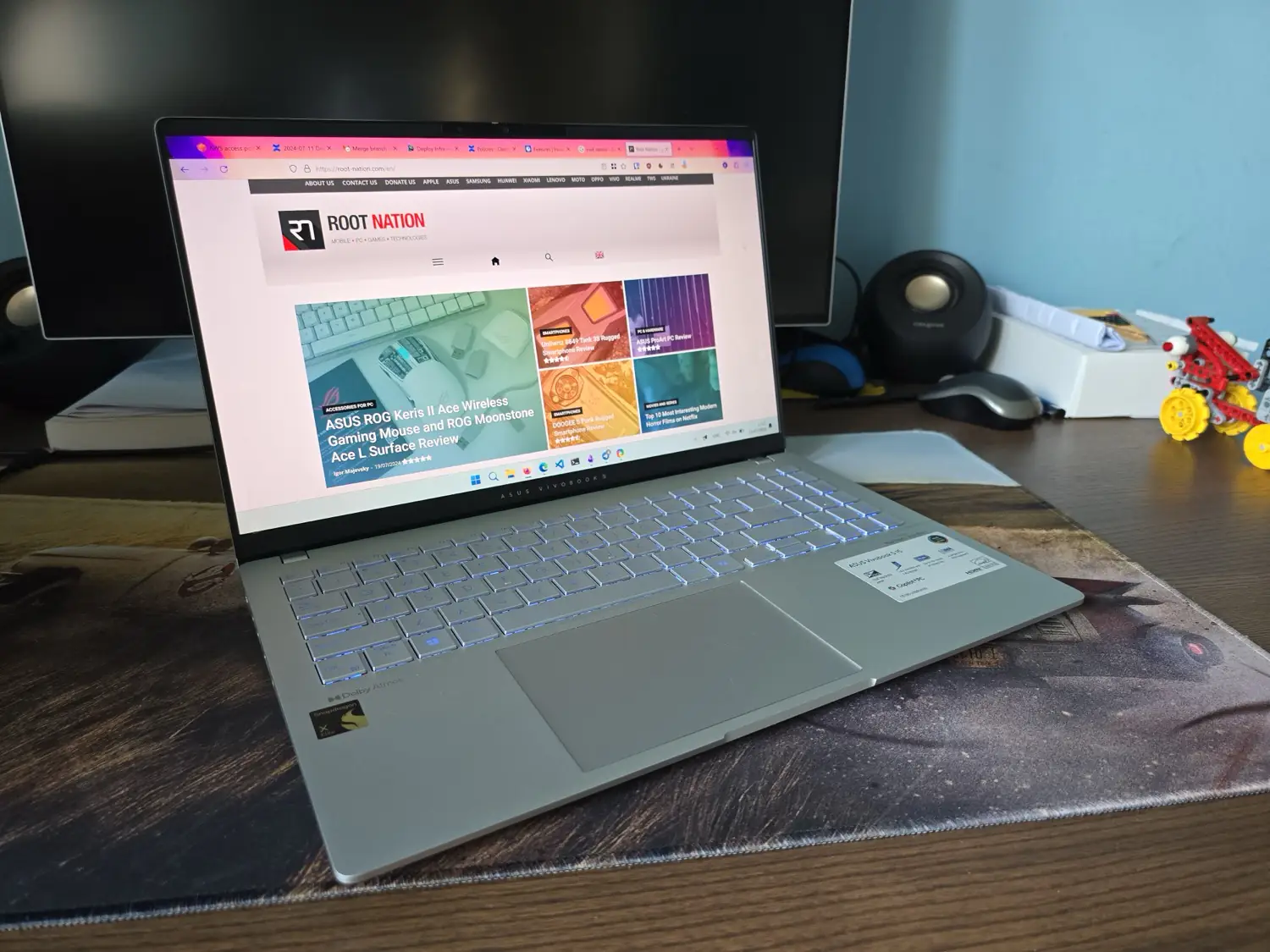
Sound and camera
The ASUS Vivobook S 15 S5507 features a basic Full HD camera that captures at 30 fps. It supports Windows Hello facial recognition, which works well in various lighting conditions, and comes with a physical shutter for privacy. The video quality is average—suitable for video calls, but if you’re looking for something better, it’s worth investing in an external camera. As expected, the camera supports effects such as automatic eye “centering” and background blurring, achieved through the use of the NPU (neural processing unit).
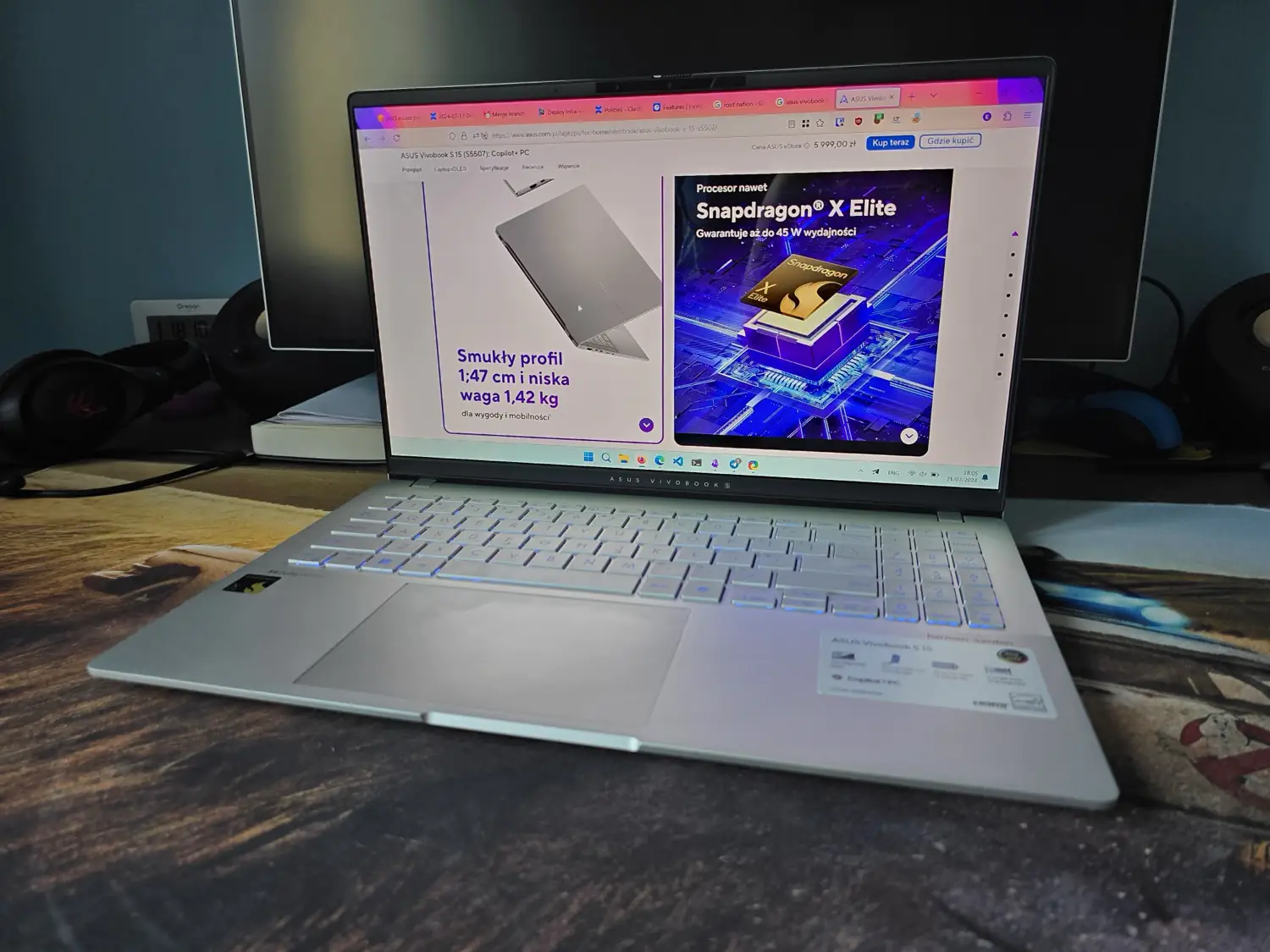 The built-in microphones do a great job of suppressing background noise, providing clear audio during video calls. For example, I had to talk to colleagues while an air conditioner was running in the background, and it wasn’t audible at all—it filtered it out perfectly. It almost managed to handle the sound of a lawnmower too.
The built-in microphones do a great job of suppressing background noise, providing clear audio during video calls. For example, I had to talk to colleagues while an air conditioner was running in the background, and it wasn’t audible at all—it filtered it out perfectly. It almost managed to handle the sound of a lawnmower too.
The laptop’s sound system features two speakers located on either side of the lower panel, certified by Harman/Kardon and supporting Dolby Atmos enhancements. The sound quality is generally good—loud and full, allowing you to watch videos or listen to music without needing to connect external speakers.
Charging and battery life
The ASUS Vivobook S 15 S5507 comes with a 70 Wh battery, and the manufacturer advertises a remarkable 18 hours of battery life on a single charge. Achieving this number might require turning off most features and working with minimal usage. In our tests, the laptop lasted up to 13.5 hours with brightness set around 65%, working with documents, web browsing, or video playback at a 60 Hz refresh rate. Switching to a 120 Hz refresh rate reduced battery life by about two hours. At maximum brightness, battery life dropped by approximately half. While these figures are quite good (unreachable for laptops with Intel or AMD processors), the Vivobook S 15 still lags behind the MacBook Air in battery life by about 20%.
I should add that under high load (stress tests, rendering video in high resolution), the laptop will last only up to two hours. When playing HDR videos from YouTube at maximum brightness at 120 Hz, it lasts about 9-10 hours, and at 60 Hz – up to 12 hours. The performance is excellent.
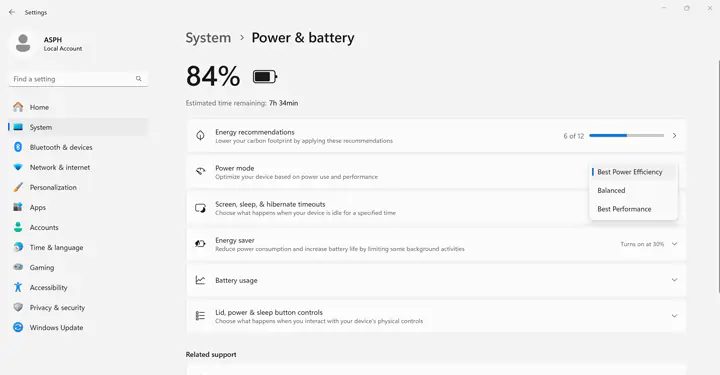
The hero of the review is charged at a speed of 90 W, it takes a little less than two hours to charge from zero to 100%, with 50% gained in 28 minutes and 80% in 50 minutes.
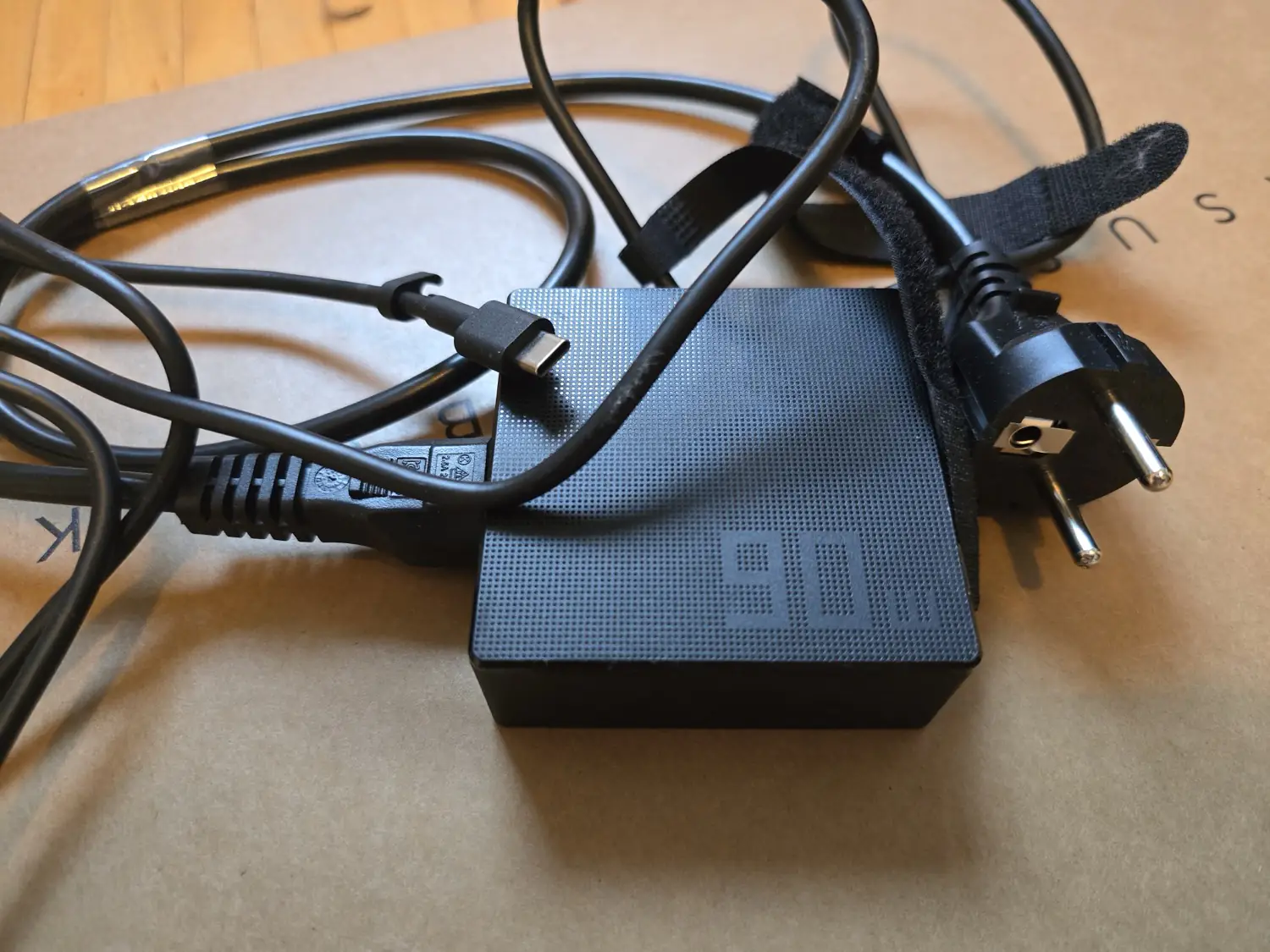
I should note that the charger heats up the laptop’s body to noticeable temperatures during charging, so I wouldn’t recommend keeping the device on your lap at that time. I tried connecting the laptop to the monitor’s charging port, but it only provides 60 watts, which wasn’t enough.
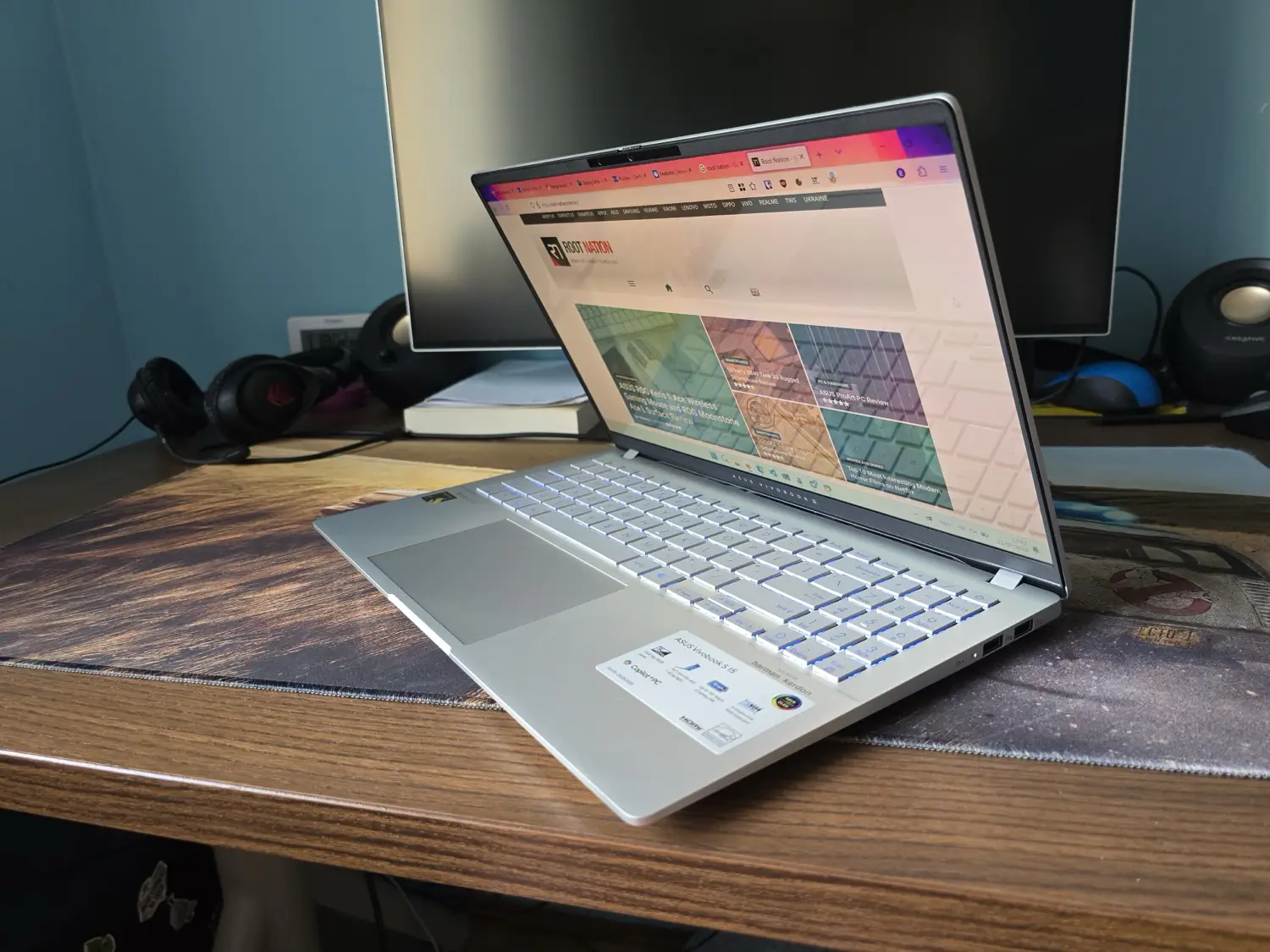
Read also: ASUS ExpertBook B9 OLED (B9403CVAR) Ultrabook Review
Conclusions
The ASUS Vivobook S 15 with Snapdragon is an intriguing choice, offering good performance and long battery life. It’s recommended for those seeking energy efficiency and low noise during operation. It’s also ideal for users who don’t need specialized software. In such cases, you won’t even notice that the processor is “different.”
The design of this model is excellent, with great ergonomics, a comfortable keyboard, plenty of ports, and a large 120 Hz OLED screen – it’s fantastic. The sound is also impressive. What more could you need? The performance is sufficient, even for gaming. But if you’re still unsure about the Snapdragon X processors, the Vivobook S 15 is also available with Intel and AMD options.
Read also:
- Cubot KingKong ES Review: Rugged Budget Phone at Reasonable Price
- Phonemax R4GT Review: Smallest Rugged Smartphone with Night Vision and Thermal Imaging




